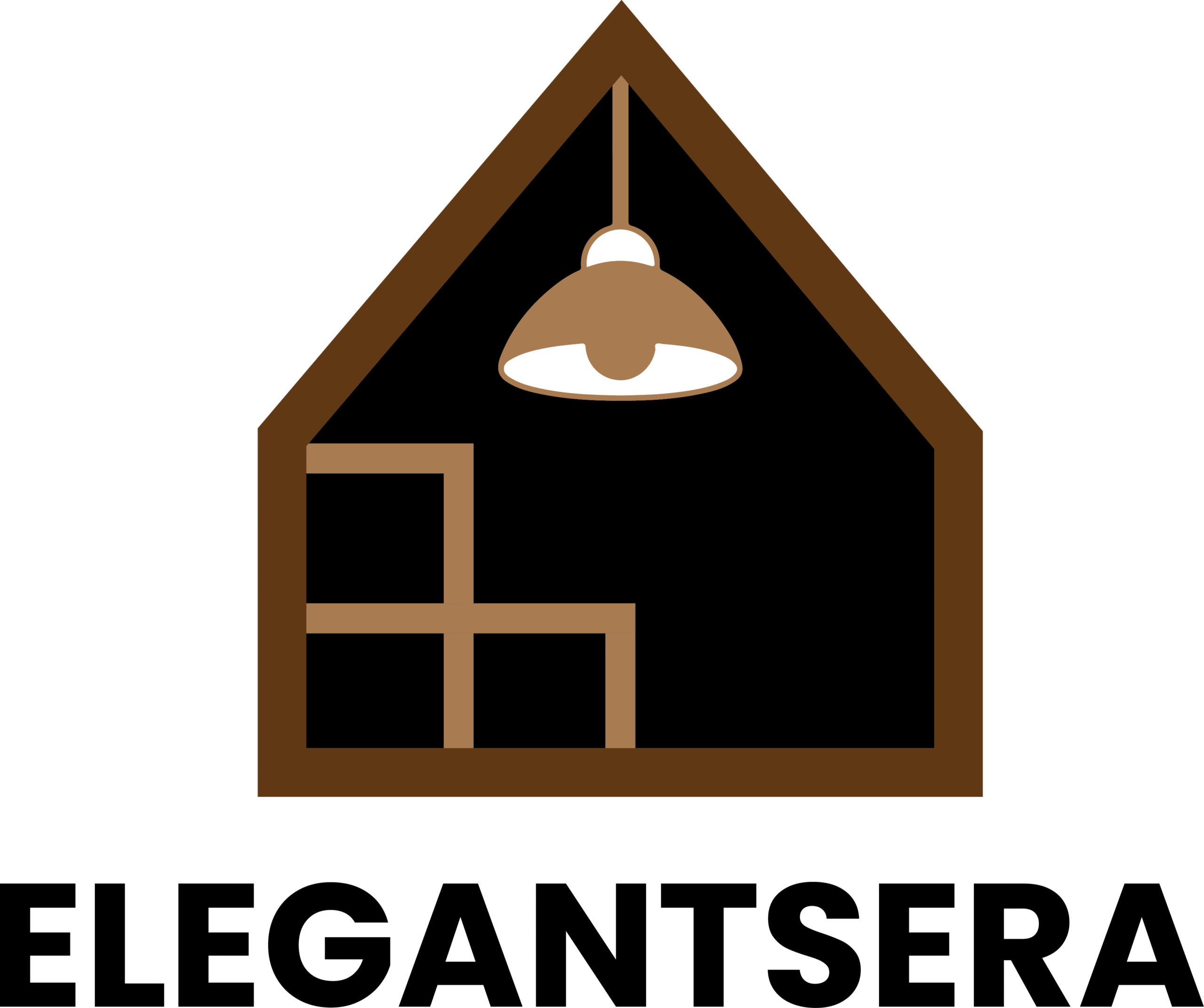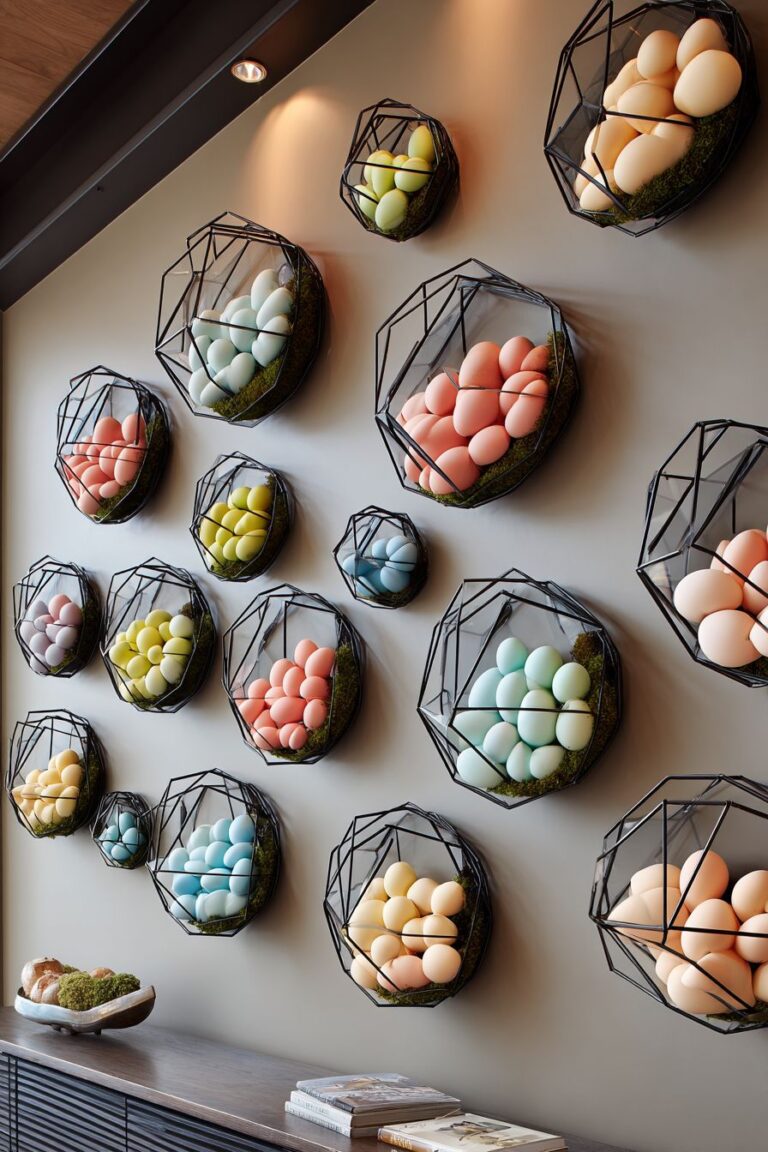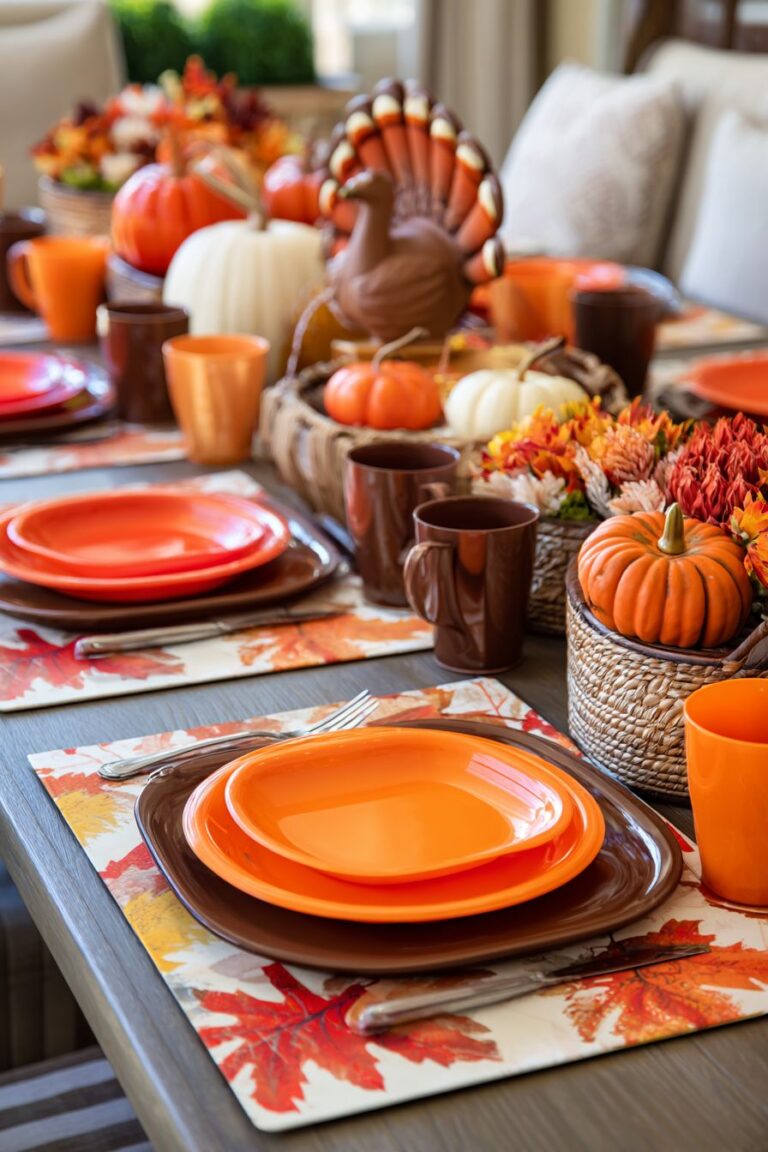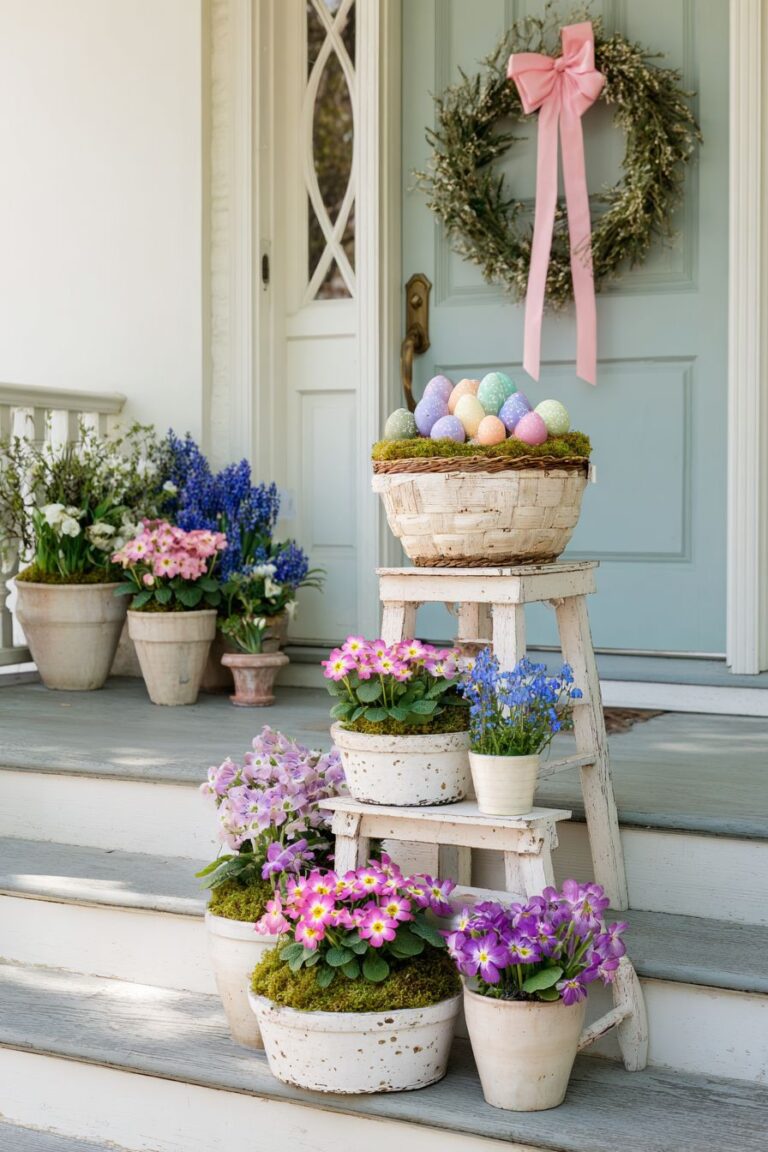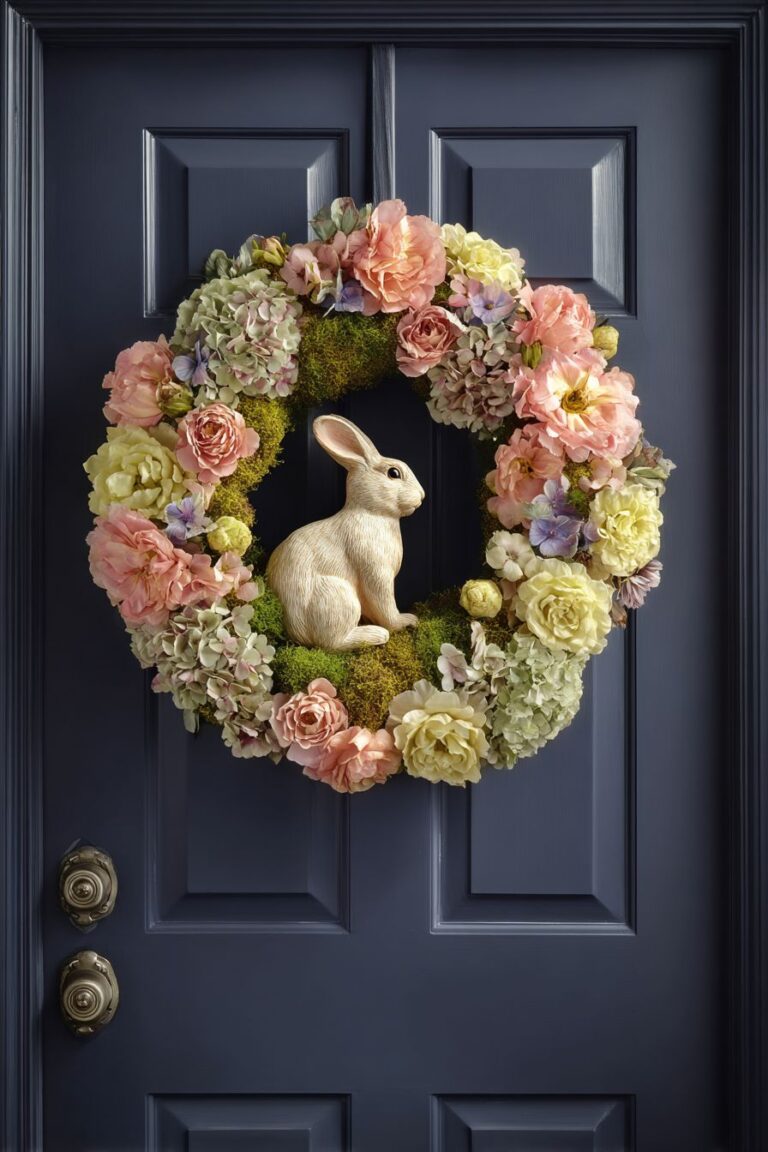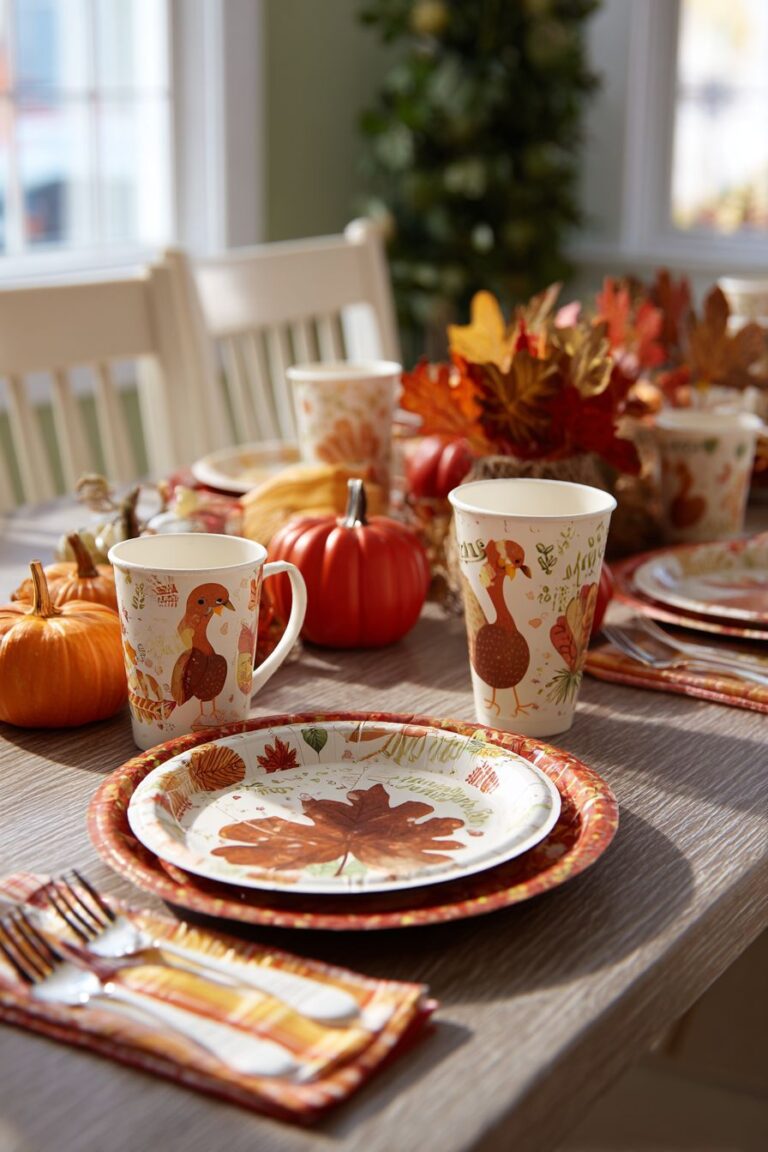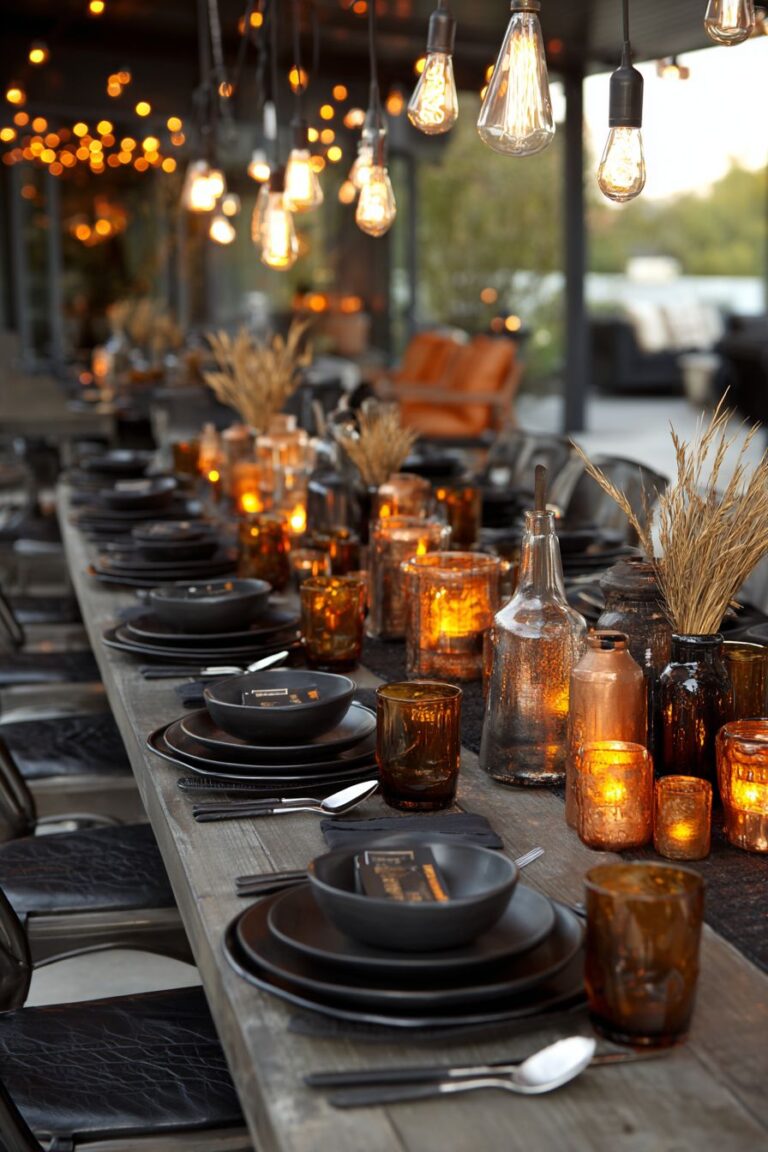19+ Charming Easter Kitchen Decor Ideas: Transform Your Space This Spring
The kitchen is often called the heart of the home, and there’s no better time to infuse it with fresh, seasonal charm than during Easter. This beloved spring holiday offers the perfect opportunity to transform your culinary space into a celebration of renewal, rebirth, and natural beauty. Easter kitchen decor goes far beyond simply placing a few plastic eggs in a basket—it’s about creating an intentional, aesthetically pleasing environment that reflects the joy and optimism of the season while maintaining the functionality that every working kitchen demands.
Whether you’re drawn to the rustic warmth of farmhouse style, the clean lines of modern minimalism, or the romantic charm of French country design, Easter provides a versatile decorating framework that adapts beautifully to any aesthetic preference. The key to successful Easter kitchen decor lies in balancing seasonal elements with your existing design, incorporating natural materials, soft pastel color palettes, and fresh botanical accents that bring the essence of spring indoors. From subtle touches like pastel dishware displays to dramatic focal points featuring oversized floral arrangements, the possibilities for Easter kitchen transformation are as diverse as they are delightful.
In this comprehensive guide, we’ll explore twenty distinctive approaches to Easter kitchen decor, each offering unique insights into different design styles, material combinations, and decorative techniques. You’ll discover how to leverage everything from vintage enamelware and reclaimed wood to contemporary quartz surfaces and industrial metal accents, creating Easter displays that feel both seasonally appropriate and authentically aligned with your personal aesthetic. These carefully curated design concepts will inspire you to reimagine your kitchen as a space that celebrates the arrival of spring while remaining beautifully functional for everyday use.
1. Farmhouse Rustic Easter Island Display
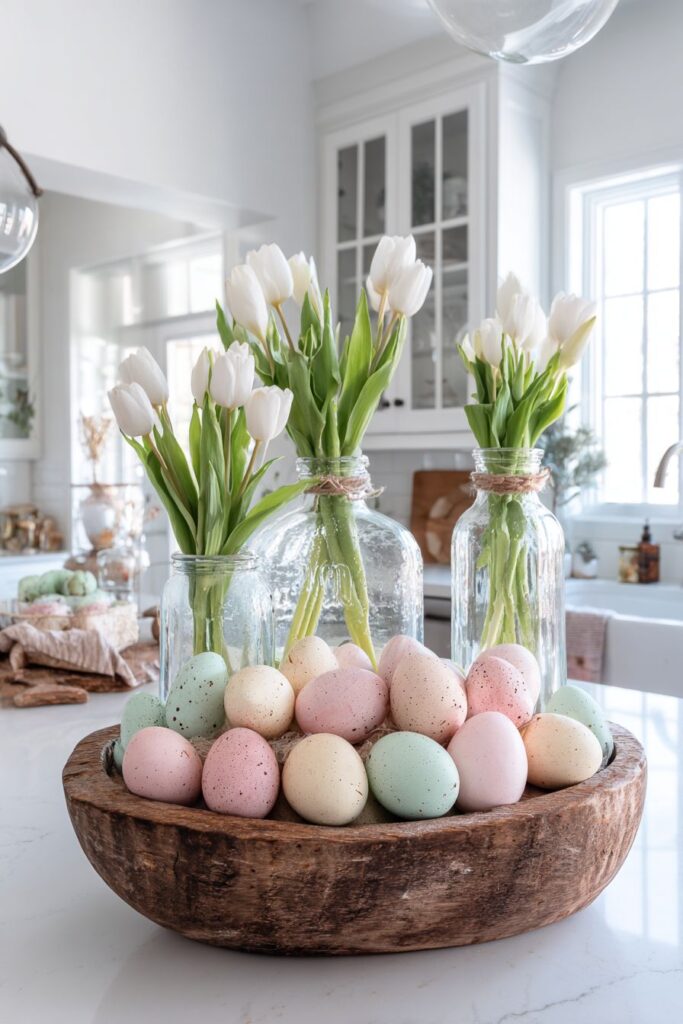
Step into a kitchen where farmhouse charm meets Easter elegance through a carefully curated island centerpiece. The focal point is a substantial rustic wooden dough bowl, its weathered surface telling stories of countless gatherings past, now filled with an artful collection of hand-painted pastel eggs. Each egg features delicate brushstrokes in soft pink, mint green, and butter yellow—colors that whisper of spring gardens and sunrise skies. The careful arrangement creates visual interest through varying heights and color distribution, ensuring the eye travels pleasantly across the display.
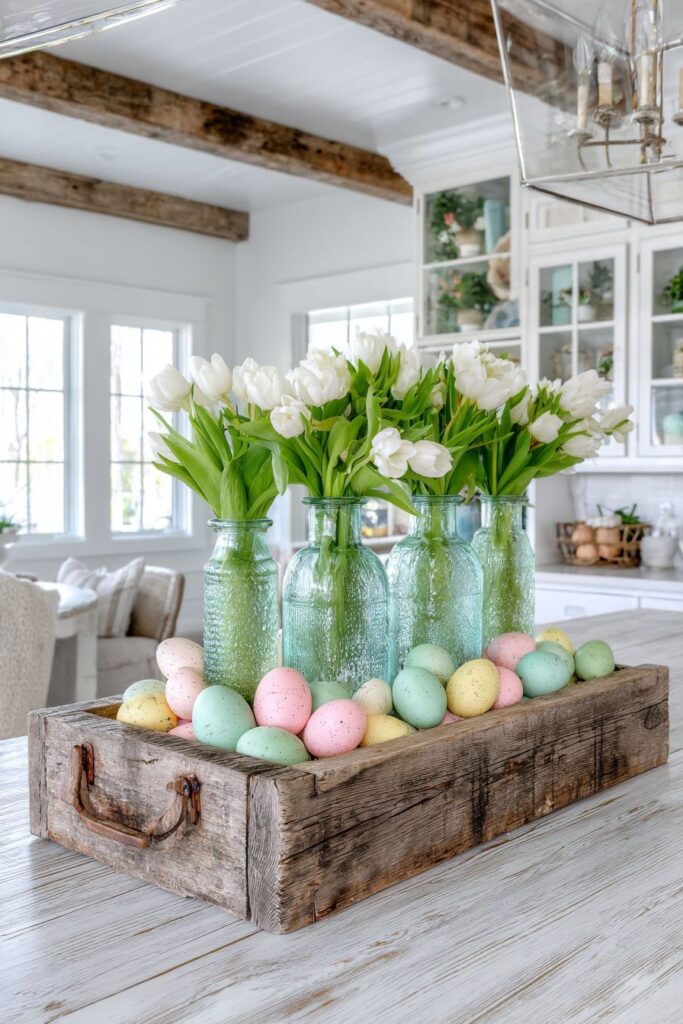
Flanking this central arrangement are vintage glass bottles of varying heights, each cradling fresh white tulips that add vertical dimension and organic movement to the composition. The clear glass allows the natural stems to become part of the decorative story, while the pristine white blooms provide a crisp counterpoint to the pastel eggs. Natural morning light streaming through nearby windows creates an ever-changing play of shadows and highlights across the distressed white wood surface of the island, emphasizing the texture contrasts between smooth painted eggs, rough wooden bowl, and delicate flower petals.
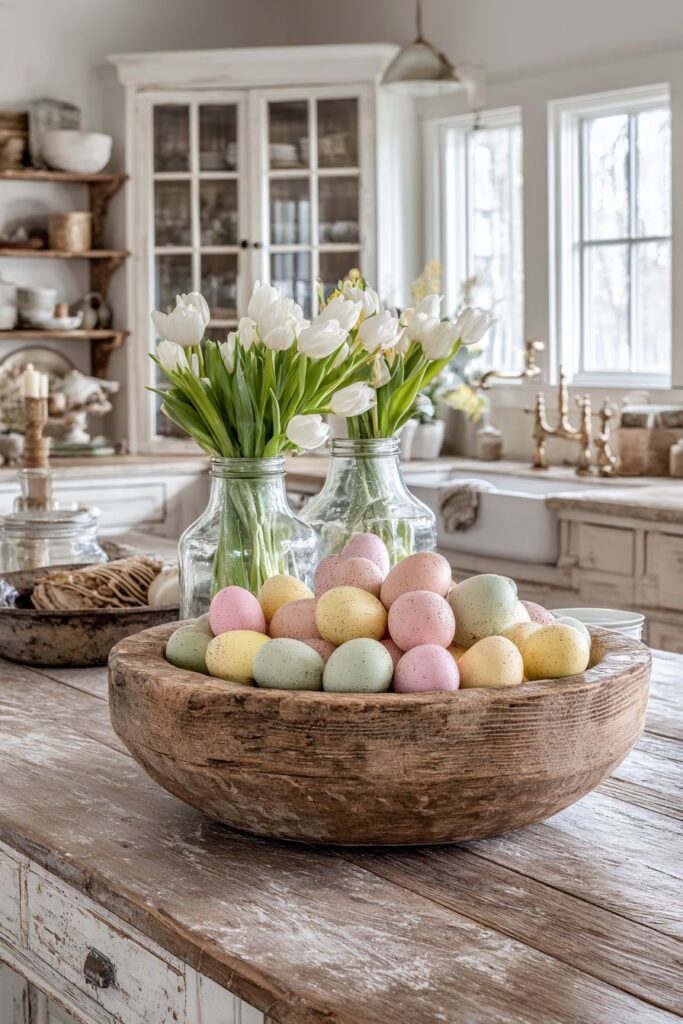
This Easter kitchen decor approach exemplifies how traditional farmhouse elements can be elevated through thoughtful styling and attention to detail. The combination of rustic and refined elements creates a welcoming atmosphere that feels both collected and intentional. The natural wood grain of both the bowl and island surface adds warmth and authenticity, while the pastel color palette keeps the overall effect light and seasonally appropriate.
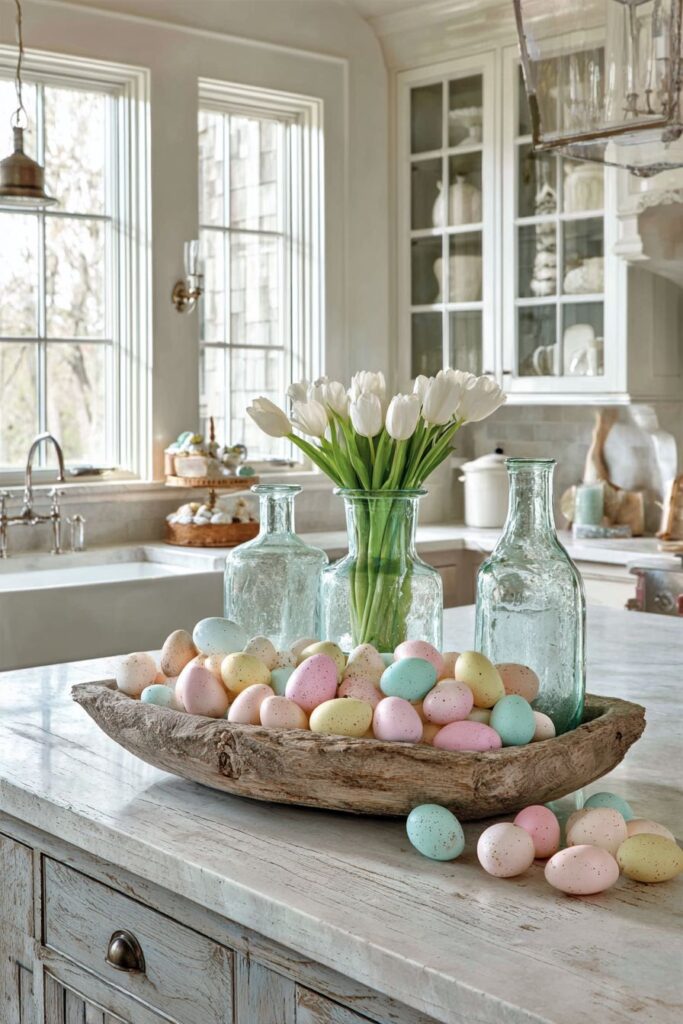
Key Design Tips:
- Choose a substantial dough bowl as your foundation to create proper visual weight for an island centerpiece
- Hand-paint eggs in a cohesive pastel palette for a custom, artisanal look that elevates standard Easter decorations
- Use vintage glass bottles in varying heights to create vertical interest and showcase fresh tulips as living elements
- Position the display where natural morning light can enhance the textures and create dynamic shadows throughout the day
- Maintain color harmony by limiting your palette to three complementary pastels against neutral backgrounds
2. Modern Minimalist Easter Elegance
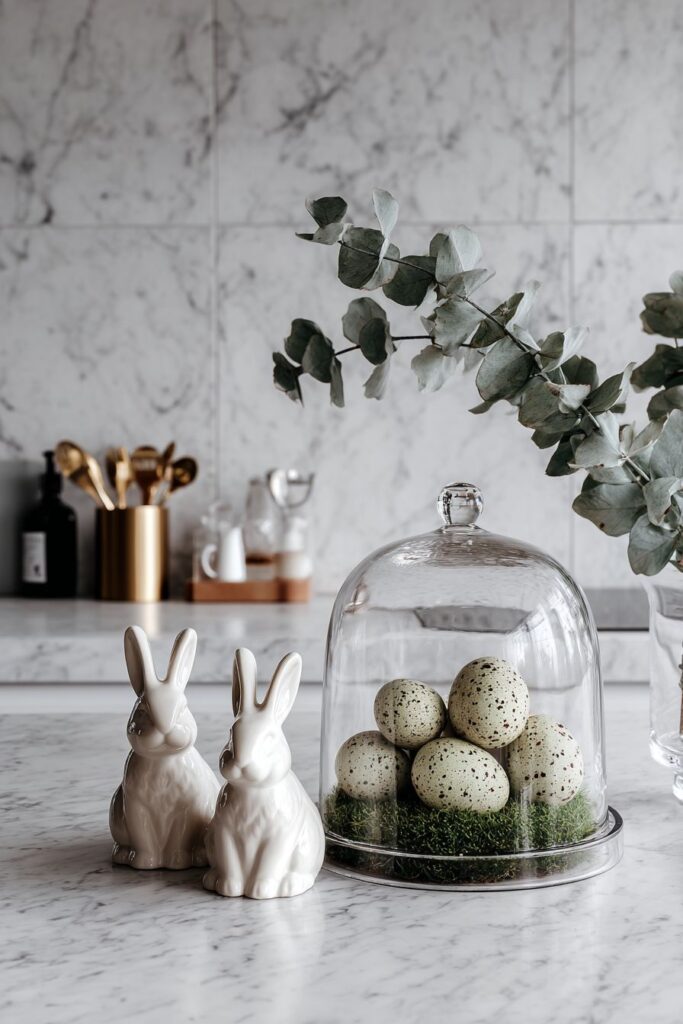
For those who appreciate the beauty of restraint, this modern Easter kitchen decor demonstrates how less truly can be more. White marble countertops provide a luxurious, clean canvas for a carefully edited display of ceramic rabbit figurines in matte white finish. These sculptural pieces are positioned with the precision of gallery art, their minimalist forms creating visual interest through shape and shadow rather than color or pattern. The monochromatic approach allows the quality of materials and the purity of form to take center stage.
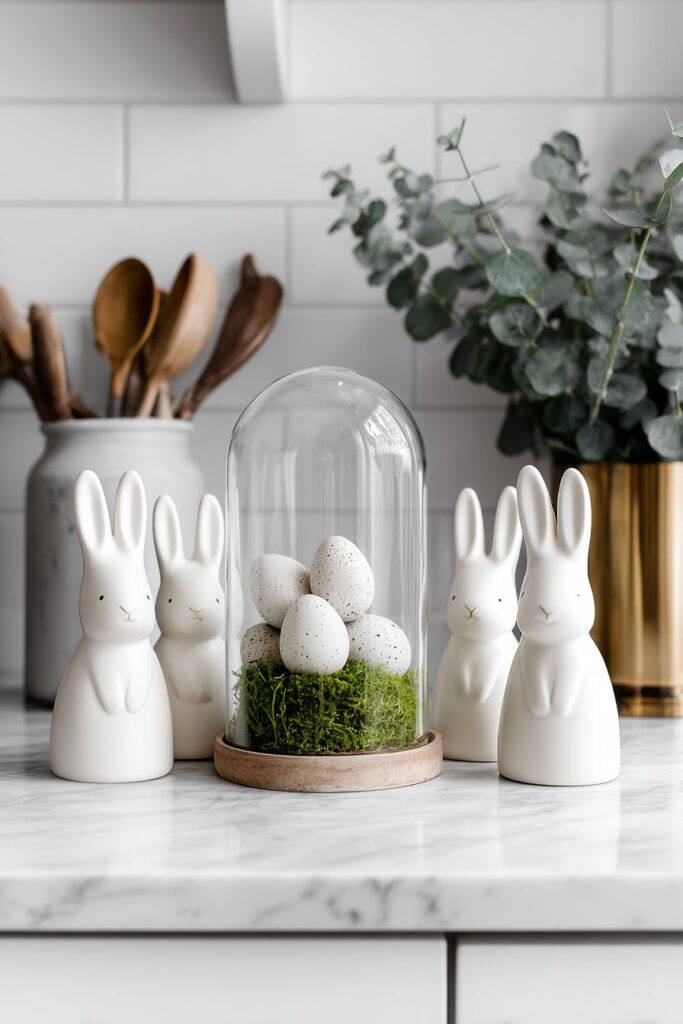
A glass cloche becomes a functional art piece, sheltering delicate speckled eggs nestled on a bed of living moss. This protective dome creates a micro-environment that preserves the naturalistic display while adding an element of curiosity and discovery. The transparency of the glass ensures the display doesn’t feel hidden, while the moss introduces an organic texture that contrasts beautifully with the sleek marble surface. Nearby, a brass utensil holder serves double duty, its metallic warmth punctuated by fresh eucalyptus branches that introduce the only significant color accent—a subtle, sophisticated green that speaks to spring without shouting.
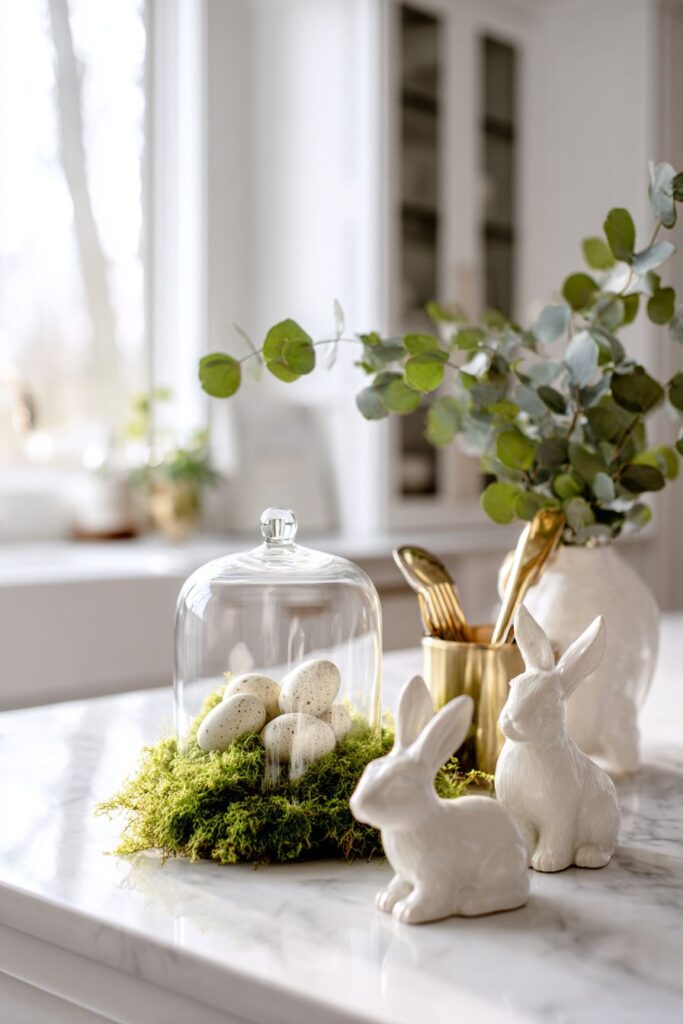
Soft diffused daylight highlights the careful composition, emphasizing clean lines and the sophisticated interplay of materials. The matte ceramic absorbs light while the marble reflects it, the brass catches and warms it, and the glass refracts it—creating a subtle light show that changes throughout the day. This approach to Easter kitchen decor proves that seasonal celebration doesn’t require traditional pastels or abundant ornamentation; instead, it can be expressed through thoughtful material selection and sculptural arrangement.
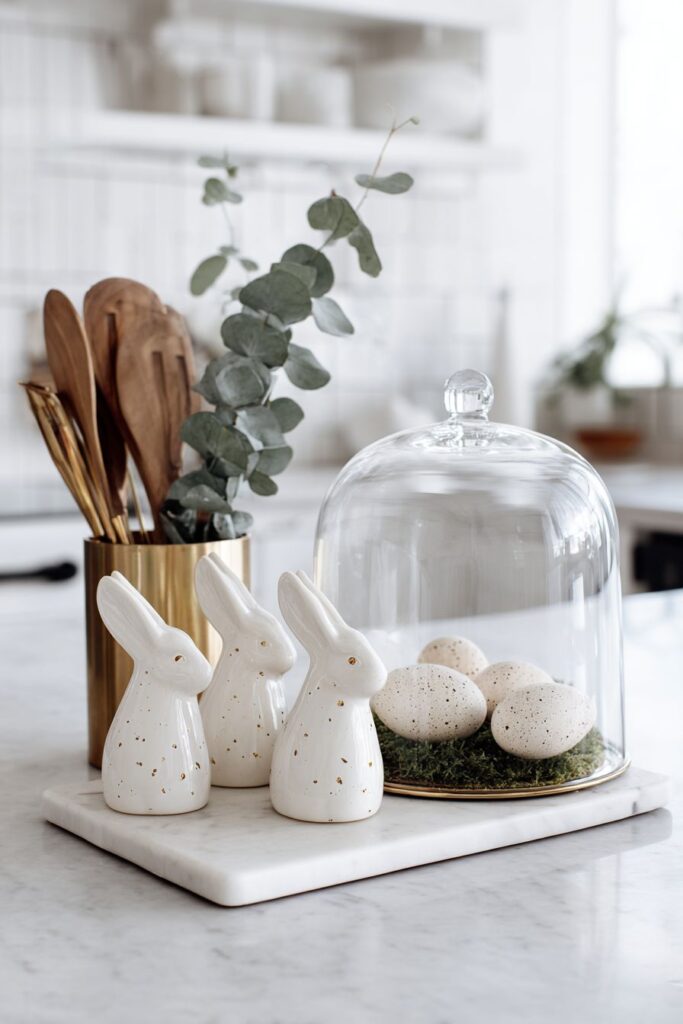
Key Design Tips:
- Embrace monochromatic color schemes with white-on-white elements to create sophisticated, contemporary Easter displays
- Use glass cloches to add dimension while protecting delicate natural elements like moss and speckled eggs
- Introduce single metallic accents through functional items like brass holders to add warmth without overwhelming the minimalist aesthetic
- Select eucalyptus for its subtle color, architectural form, and pleasant fragrance that enhances without dominating
- Position displays where diffused natural light can emphasize material textures and create subtle shadow play
3. Pastel Dishware Spring Showcase
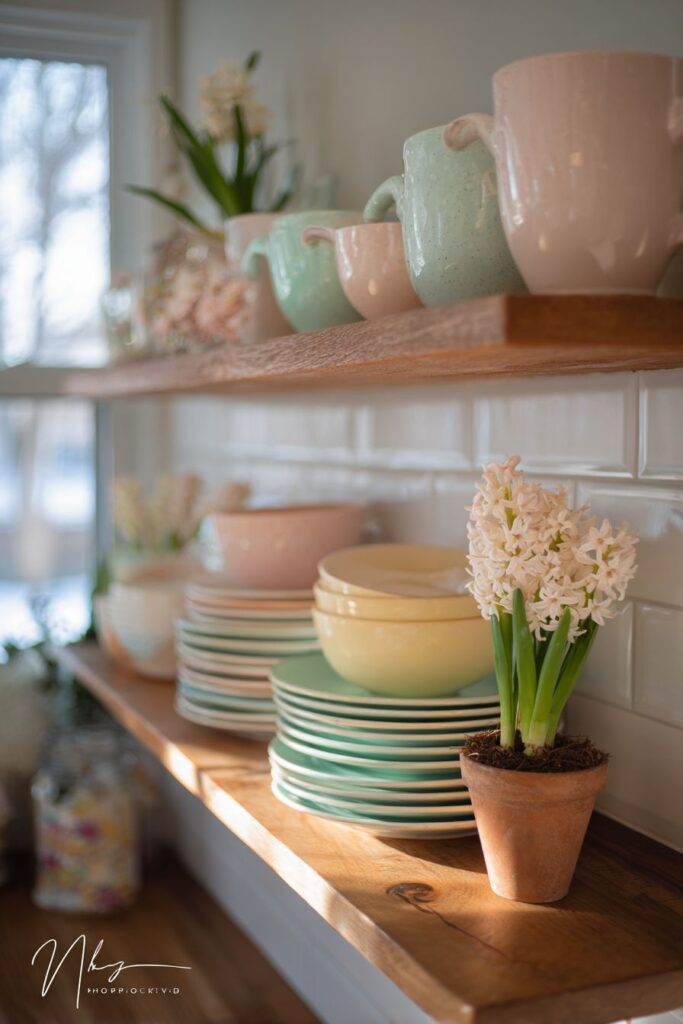
Open floating shelves transform into a celebration of spring through an artfully arranged collection of vintage pastel dishware. Mint green plates stand proudly on display stands, their soft color evoking fresh spring leaves, while blush pink bowls nestle between them like delicate rose petals. Pale yellow mugs hang from brass hooks, their sunny disposition bringing warmth and cheer to the vertical display. This Easter kitchen decor approach celebrates the beauty of functional items as decorative elements, proving that everyday objects can become seasonal art when thoughtfully curated and displayed.
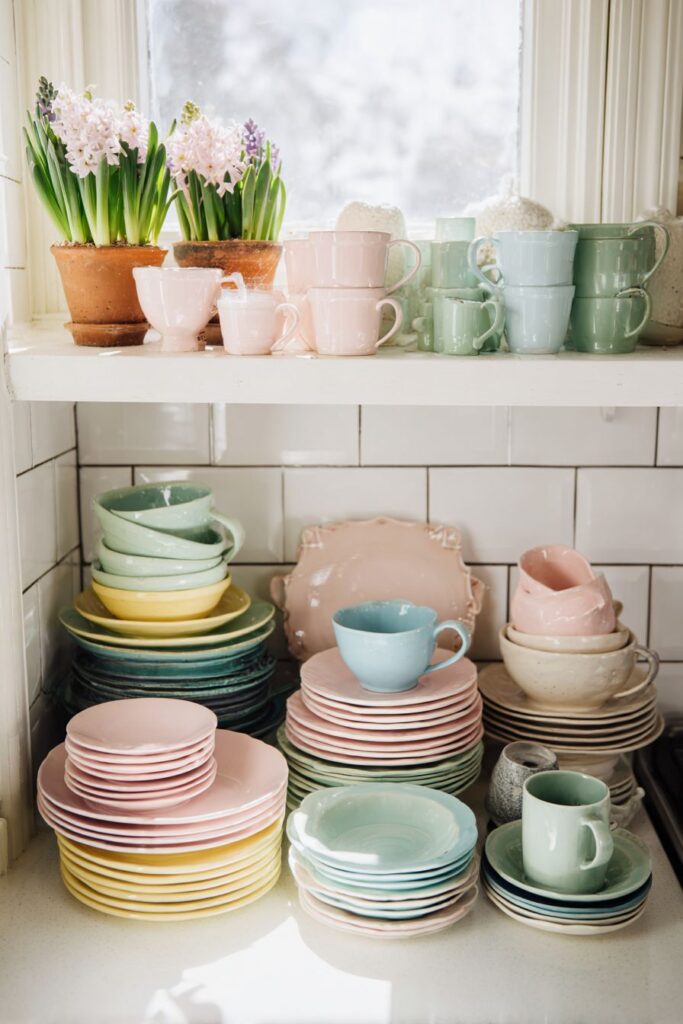
The layering technique employed here is crucial to the success of this design. Rather than simply lining items up in rows, the dishware is arranged with varying depths, creating a sense of abundance and visual intrigue. Some pieces overlap slightly, while others stand alone, allowing each item to be appreciated individually while contributing to the cohesive whole. Small potted hyacinths in terra cotta pots punctuate the display, their fragrant blooms adding not only visual interest but also the intoxicating scent of spring. The natural, unglazed terra cotta provides textural contrast against the smooth ceramic surfaces and introduces an earthy element that grounds the pastel palette.
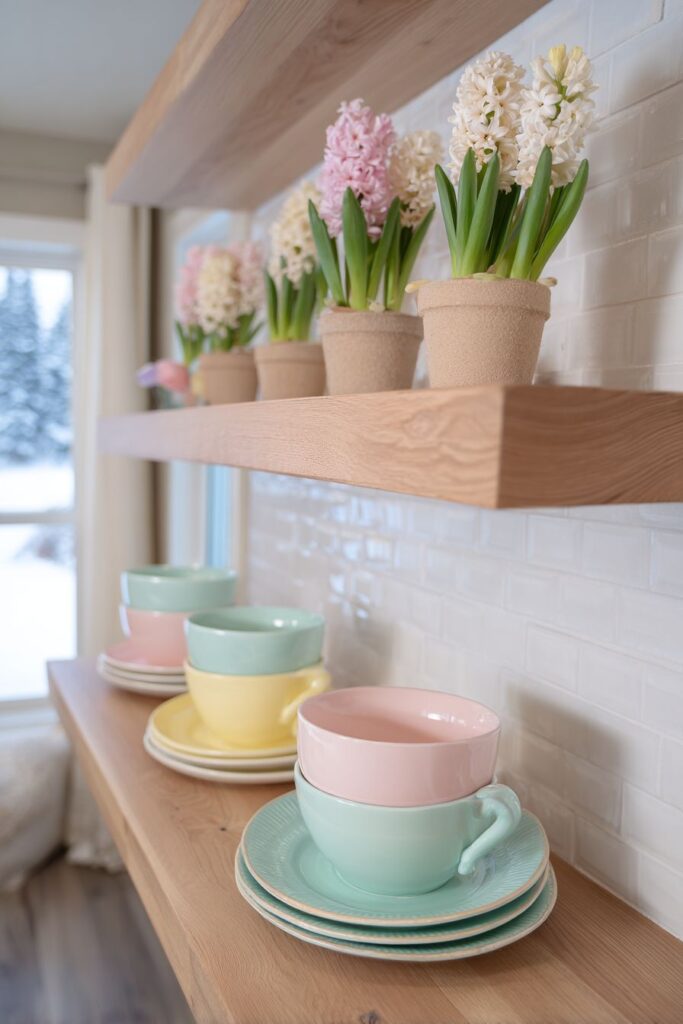
Behind this carefully orchestrated display, white subway tile backsplash provides a clean, classic backdrop that allows the pastel colors to sing. The geometric regularity of the tile creates visual order that supports rather than competes with the organic nature of the dishware arrangement. Natural window light creates gentle highlights on the ceramic surfaces, making the glazes seem to glow from within and emphasizing the hand-crafted quality of vintage pieces.
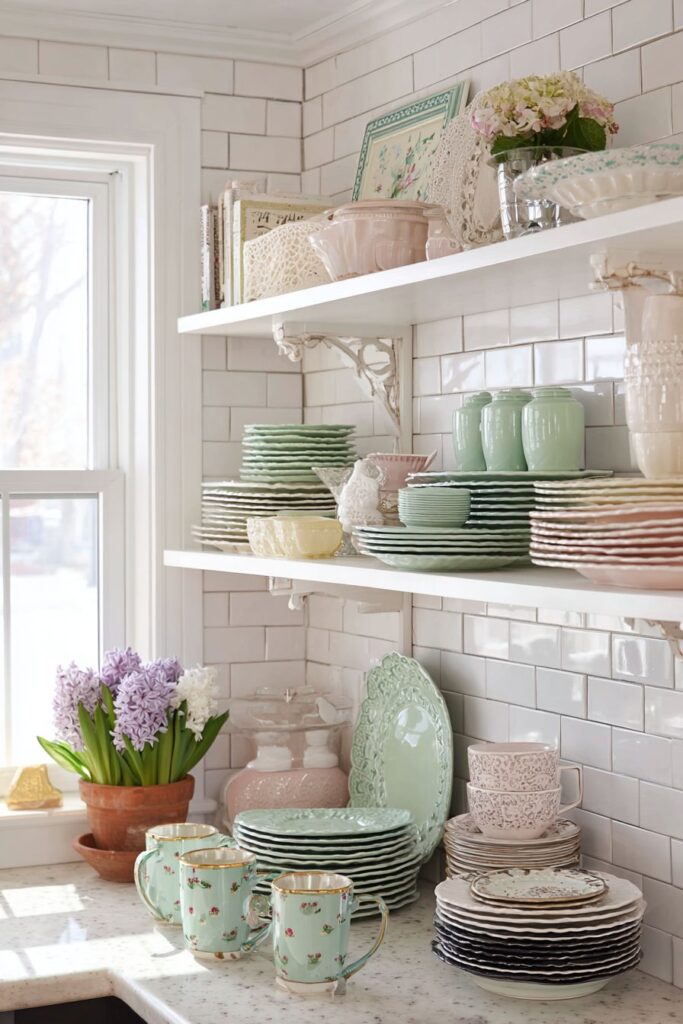
Key Design Tips:
- Curate vintage dishware in a cohesive pastel palette, mixing mint green, blush pink, and pale yellow for spring freshness
- Layer items at varying depths on shelves to create dimensional interest rather than flat, linear arrangements
- Incorporate living elements like potted hyacinths for fragrance, color, and the authentic feel of spring
- Use white or neutral backgrounds like subway tile to allow pastel colors to stand out without visual competition
- Maximize natural light exposure to enhance the luminous quality of glazed ceramics
4. Cottage-Style Easter Table Setting
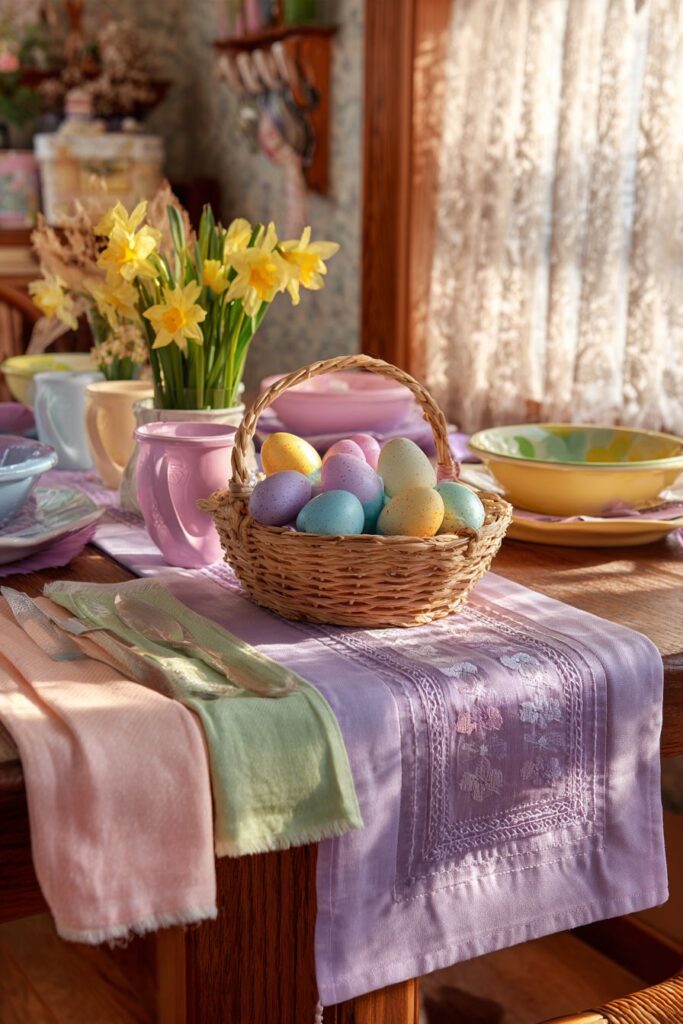
A round wooden table becomes the stage for cottage-style Easter charm, dressed in a soft lavender linen runner that introduces color while showcasing the beautiful wood grain beneath. The runner’s gentle drape and natural texture set a relaxed yet refined tone for the entire display. At the center, a woven basket filled with decorated eggs and fresh daffodils creates a focal point that combines handmade craftsmanship with nature’s bounty. The eggs feature delicate painted designs that complement rather than overwhelm, while the cheerful yellow daffodils bring the undeniable spirit of spring indoors.
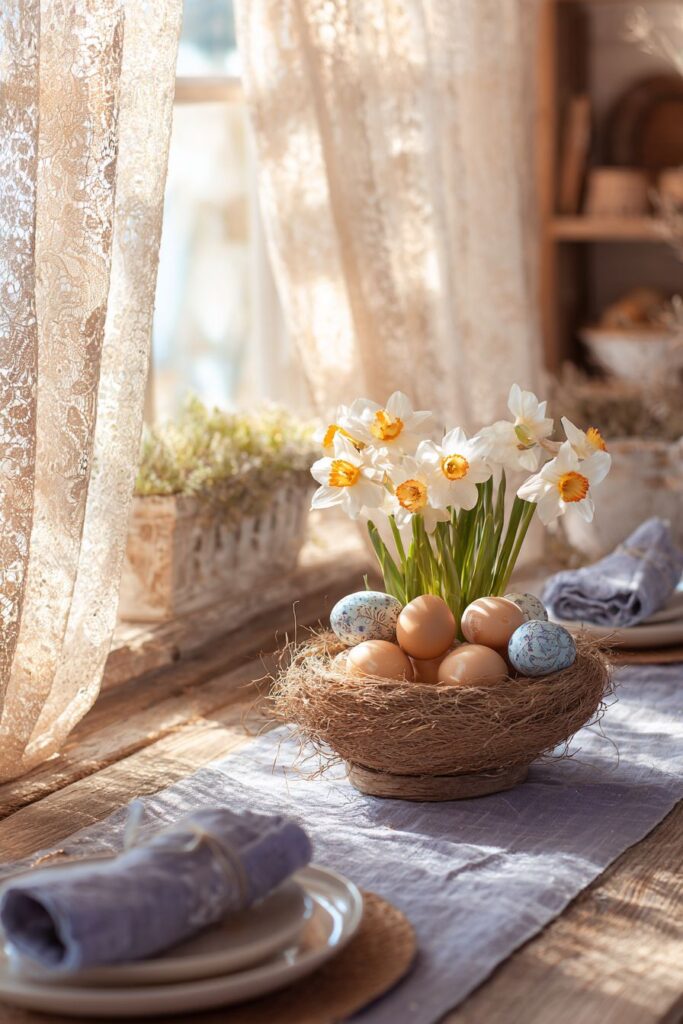
Vintage enamelware pieces are strategically placed around the table, their time-worn charm telling stories of Easter celebrations past. The slight chips and patina on these pieces aren’t flaws but rather character marks that add authenticity and warmth to the setting. Pastel-colored napkins in complementary soft hues are folded artfully at each place setting, their colors echoing both the lavender runner and the decorated eggs. These textile layers create a welcoming, tactile experience that invites guests to sit, linger, and enjoy the seasonal celebration.
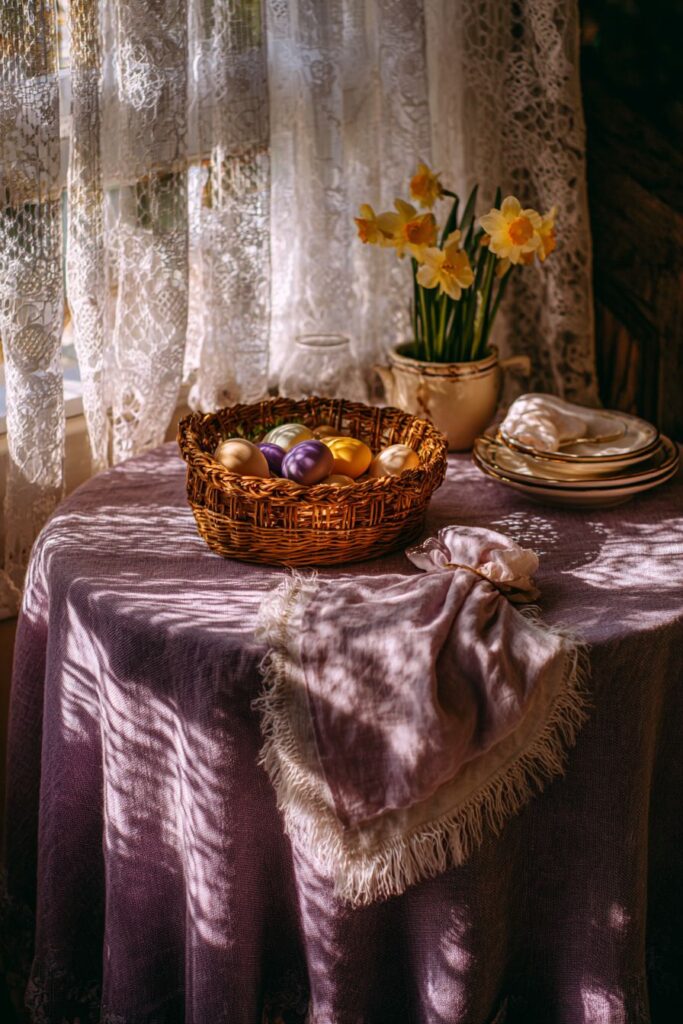
Golden hour sunlight filtering through lace curtains bathes the entire scene in a warm, nostalgic glow. The lace creates intricate shadow patterns that dance across the table surface, adding another layer of visual interest that changes throughout the day. This interplay of natural light and delicate fabric creates an atmosphere of gentle intimacy perfect for Easter gatherings. The overall effect is one of approachable elegance—sophisticated enough to feel special, yet comfortable enough to feel like home.
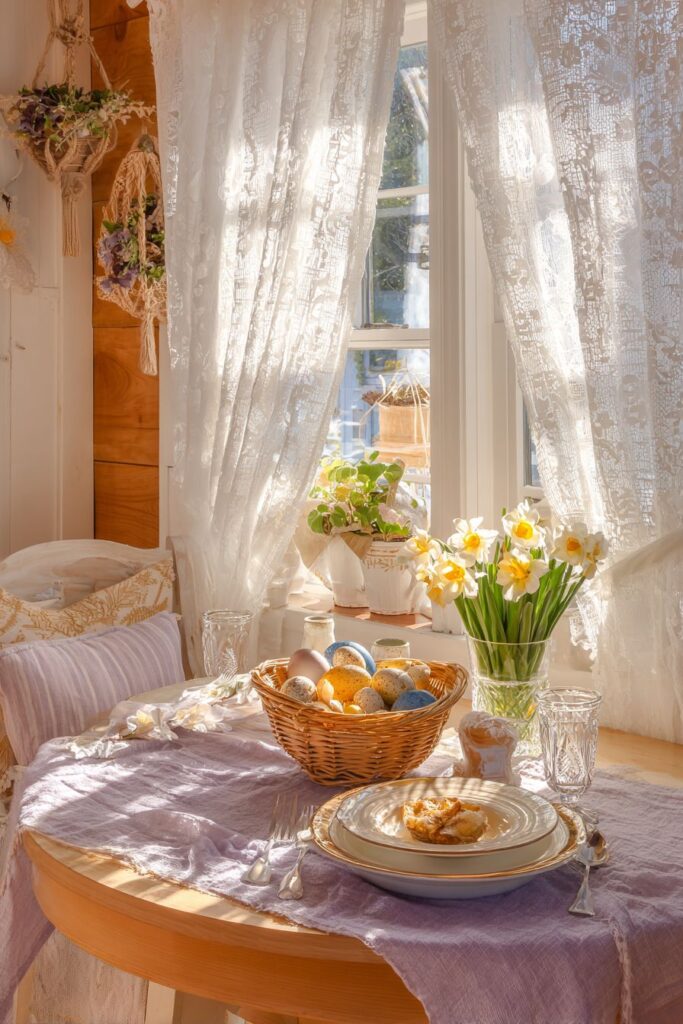
Key Design Tips:
- Use linen table runners in soft pastels to add color while maintaining the natural beauty of wood tables
- Combine woven baskets with fresh spring flowers and decorated eggs for authentic cottage-style centerpieces
- Incorporate vintage enamelware to add character and historical charm to your Easter table setting
- Layer textiles in complementary pastel shades to create depth and tactile interest
- Position tables near windows with lace curtains to capture golden hour light and create romantic shadow patterns
5. Playful Family-Friendly Kitchen Decor
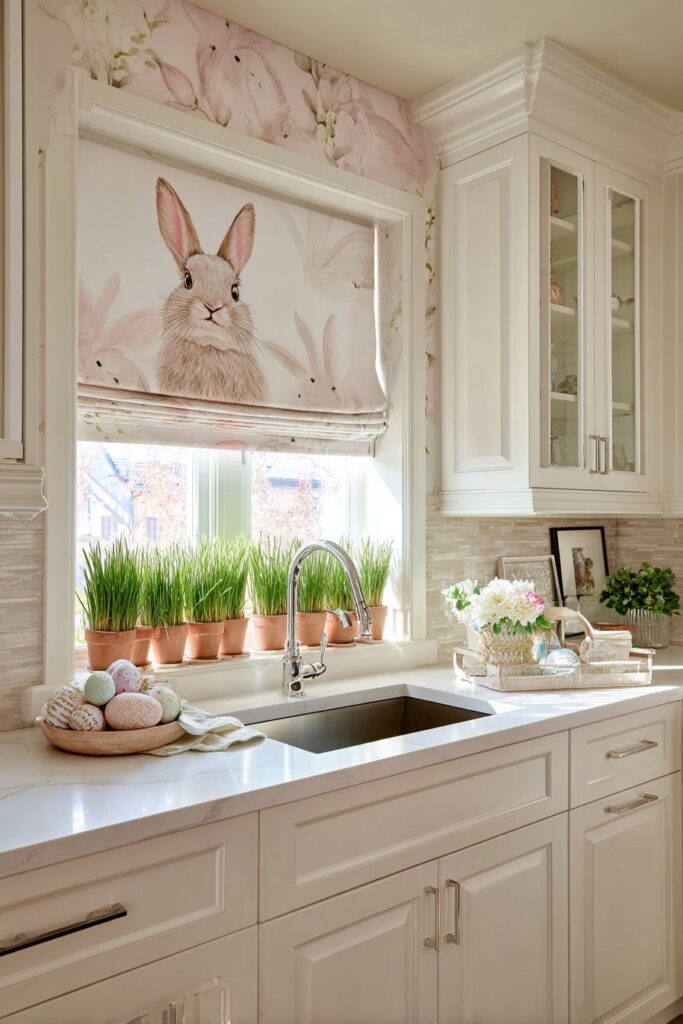
This Easter kitchen decor approach embraces whimsy without sacrificing style, proving that family-friendly design can be both fun and tasteful. Removable pastel bunny and egg decals transform the wall above the sink into a playful focal point that delights children while maintaining design integrity. These wall decorations are applied with careful spacing and compositional awareness, creating visual balance rather than random chaos. The soft color palette ensures the decals enhance rather than overwhelm the space, and their temporary nature allows for seasonal rotation without commitment.
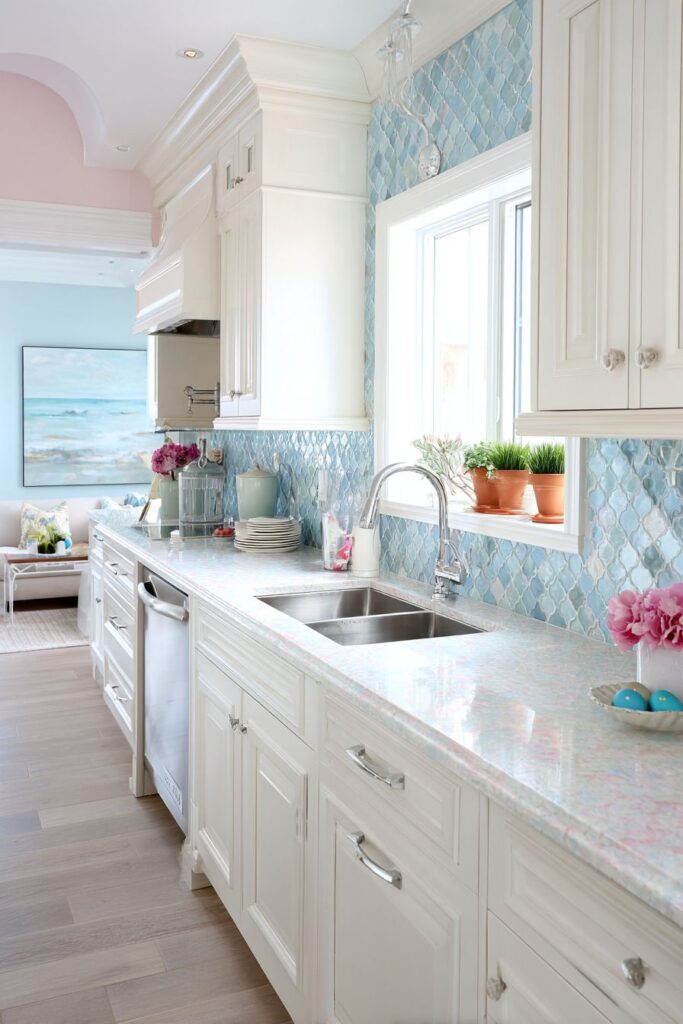
White shaker cabinets provide a clean, classic foundation that allows the seasonal elements to shine without competing for attention. Their simple, timeless design means they’ll remain stylish long after the Easter decorations have been stored away. The windowsill becomes a miniature garden display featuring small terracotta pots with sprouting grass—a living element that children can help plant and tend. Painted eggs nestle among the grass, creating a charming Easter egg hunt scene that brings joy every time someone washes dishes or looks out the window.
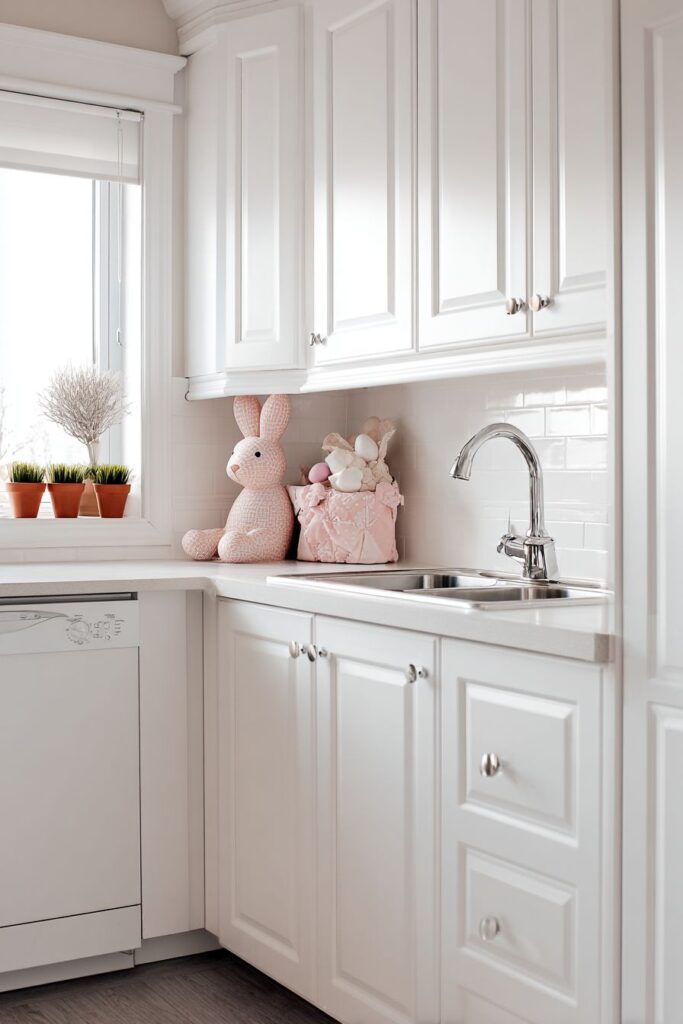
Morning light streaming through the window emphasizes both the playful Easter elements and the practical beauty of the existing kitchen design. The natural illumination makes the pastel decals seem to glow softly and highlights the fresh green of the sprouting grass. This approach demonstrates that Easter kitchen decor can be seamlessly integrated into existing design schemes without requiring major changes or investments. It’s about enhancing what you already have with thoughtful seasonal touches that bring joy to daily routines.
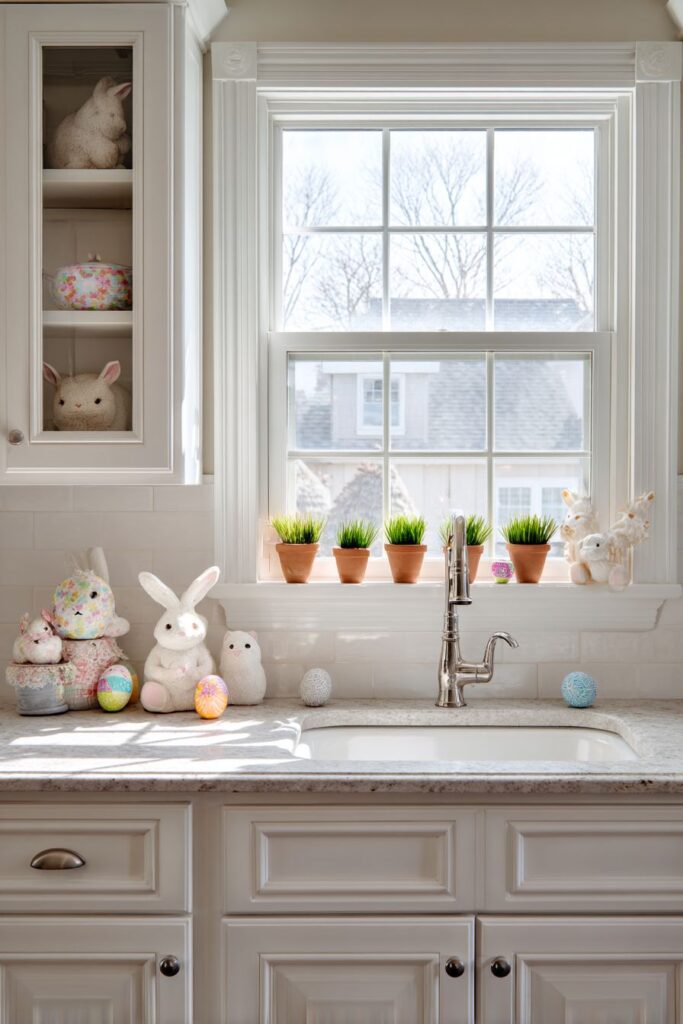
Key Design Tips:
- Select high-quality removable decals in soft pastels for playful seasonal decoration that won’t damage walls
- Use white or neutral cabinetry as a versatile backdrop that works with changing seasonal decorations
- Create windowsill displays with sprouting grass in terracotta pots for living, interactive Easter elements
- Position seasonal decorations where morning light will enhance their colors and create cheerful ambiance
- Maintain balance between whimsical seasonal touches and timeless kitchen design for lasting appeal
6. Sophisticated Tiered Island Display
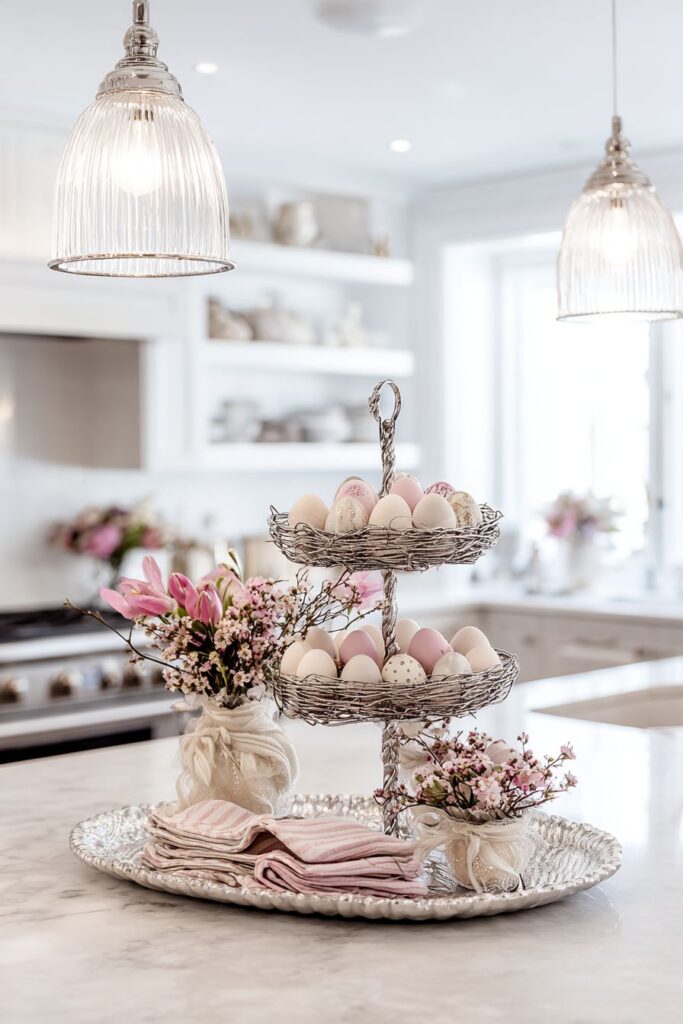
Vertical styling reaches new heights with this elegant Easter kitchen decor featuring a three-tiered wire basket stand on a Carrara marble island. This architectural approach to display maximizes visual impact while maintaining a relatively small footprint—perfect for busy kitchens where counter space is precious. The bottom tier showcases decorated eggs in complementary pastel patterns, their oval shapes echoing the organic curves of the wire basket. The middle tier features spring flowers in small vases, creating pockets of natural beauty at eye level where they can be most appreciated.
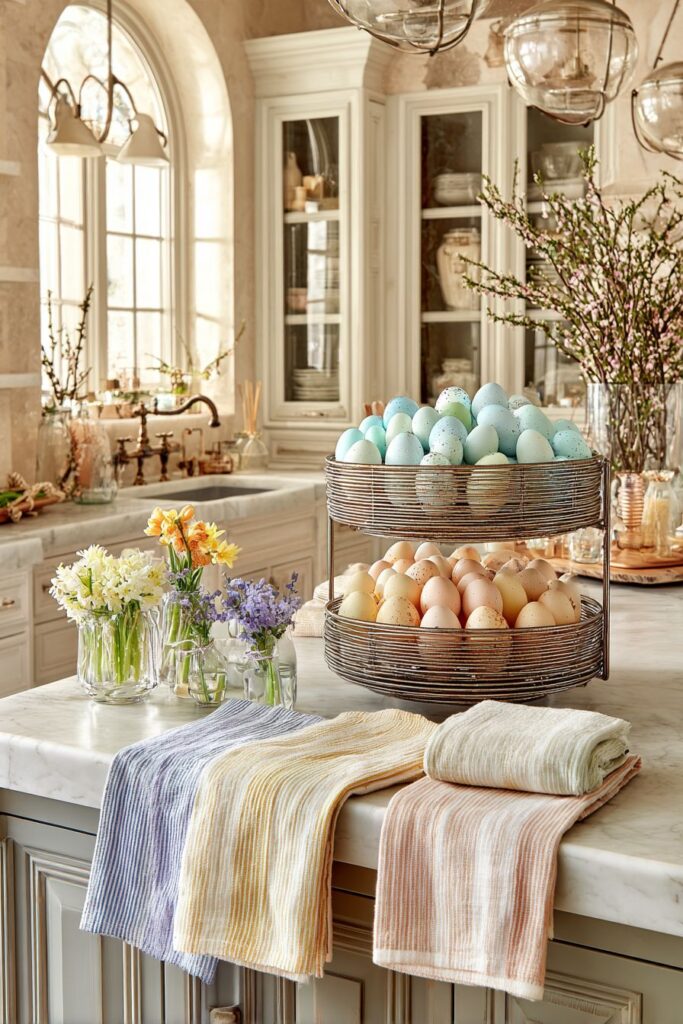
The top tier displays seasonal tea towels in pastel stripes, artfully folded to show off their patterns while remaining accessible for practical use. This multi-functional approach epitomizes sophisticated Easter kitchen decor—beautiful to look at yet entirely practical. The tea towels can be easily grabbed for use while contributing to the overall aesthetic when not in active duty. The wire construction of the stand allows light to filter through all levels, preventing the display from feeling heavy or opaque despite its vertical ambition.
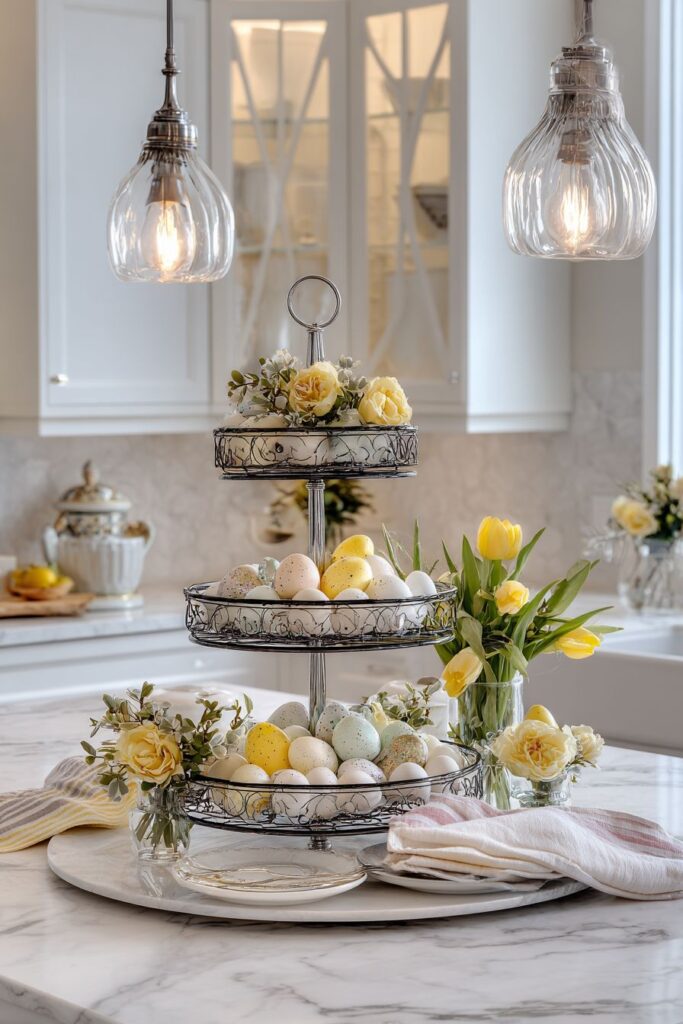
Pendant lights suspended above create subtle highlights on the various elements, their focused illumination drawing attention to the careful composition. The Carrara marble countertop provides a luxurious foundation, its grey veining adding movement and visual interest that complements rather than competes with the display above. The contrast between the industrial wire basket, organic flowers and eggs, soft textiles, and elegant stone creates a rich material conversation that elevates this Easter kitchen decor beyond simple holiday decoration into the realm of design artistry.
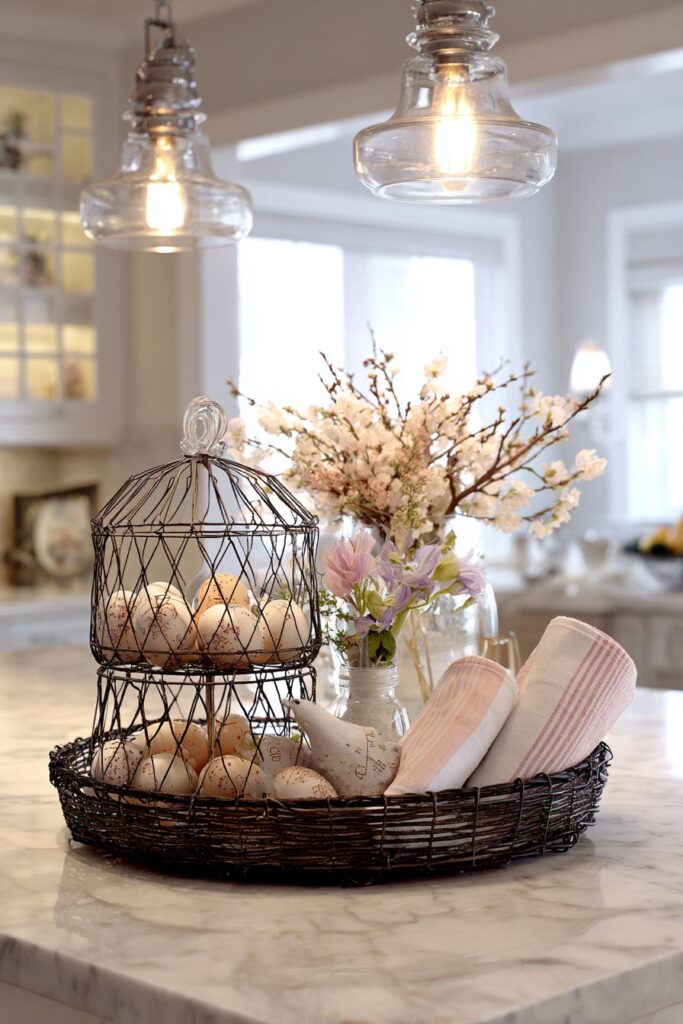
Key Design Tips:
- Utilize three-tiered stands to maximize vertical space while maintaining efficient counter footprint
- Layer different types of Easter elements—eggs, flowers, and textiles—across tiers for varied visual interest
- Choose wire basket stands that allow light penetration to prevent displays from appearing heavy
- Position tiered displays on marble or stone surfaces for material contrast and luxurious foundation
- Use pendant lighting to create dramatic highlights and draw attention to carefully styled arrangements
7. Authentic Rustic Floating Shelf Display
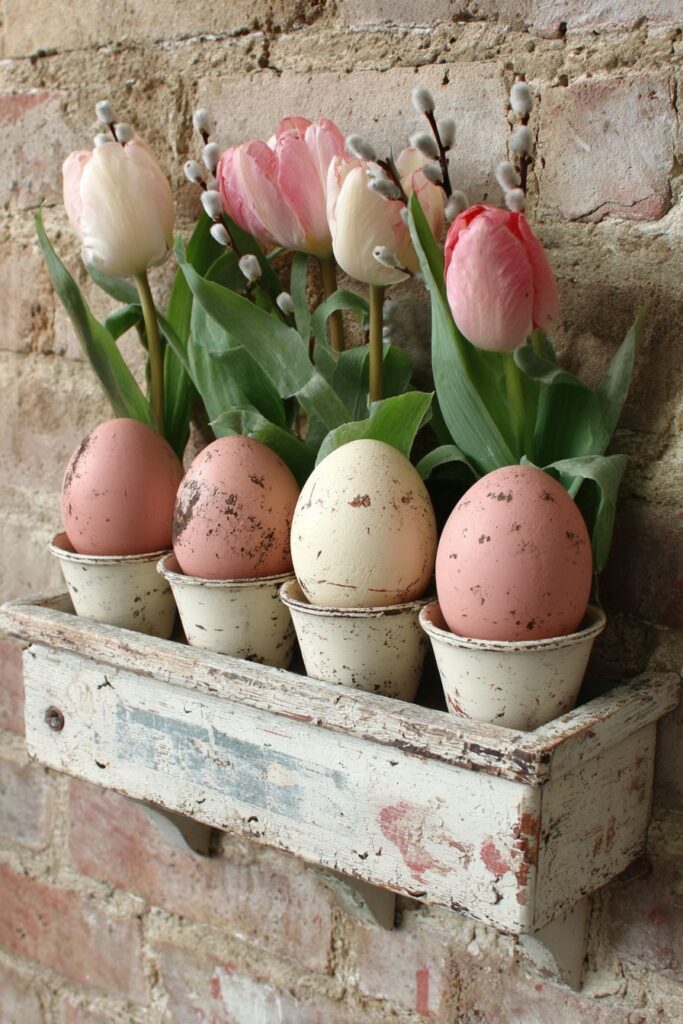
Reclaimed wood speaks volumes about character and sustainability in this rustic Easter kitchen decor approach. A floating shelf crafted from weathered barn wood or salvaged timber provides the perfect stage for a collection of vintage milk bottles, their irregular glass catching and refracting light in unpredictable ways. These bottles hold pussy willows and tulips in soft pink and cream, their organic forms a beautiful contrast to the geometric regularity of the bottles. The pussy willows add textural softness with their fuzzy catkins, while the tulips provide structural elegance with their smooth stems and sculptural blooms.
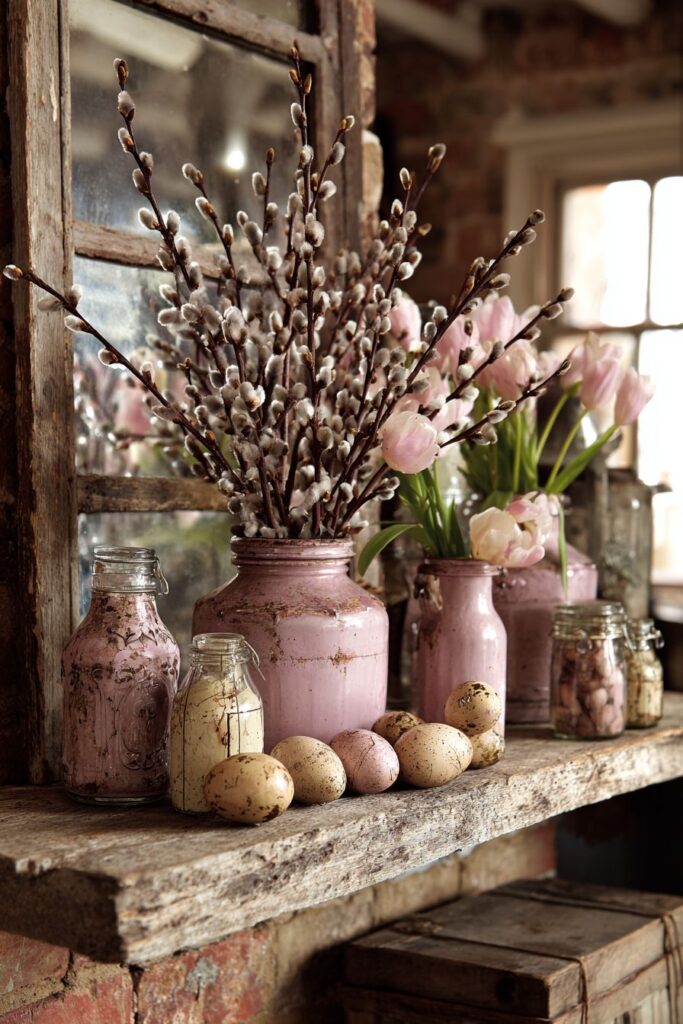
Hand-painted wooden eggs with intentionally distressed finishes nestle among the bottles, their matte surfaces and weathered appearance harmonizing perfectly with the aged wood shelf. These aren’t perfectly polished Easter decorations but rather pieces that look as though they’ve been lovingly used and displayed for generations. The painting technique might include exposed wood grain showing through thin paint layers, creating depth and visual interest that mass-produced decorations simply cannot achieve.
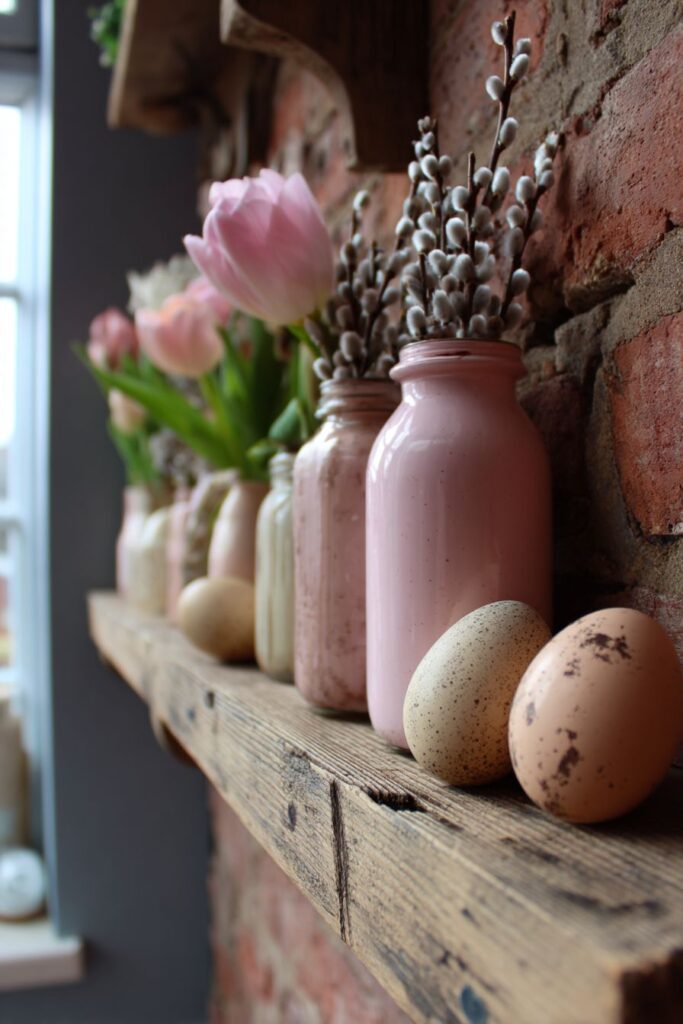
An exposed brick wall provides the ideal textural backdrop for this authentic rustic display. The irregular surface and warm earth tones of the brick complement the natural wood and create a sense of architectural honesty that enhances the overall aesthetic. Natural side lighting—perhaps from a nearby window—creates depth through shadows and highlights, emphasizing every crack, grain line, and imperfection as a design feature rather than a flaw. This Easter kitchen decor celebrates the beauty of age, authenticity, and natural materials in their most honest expressions.
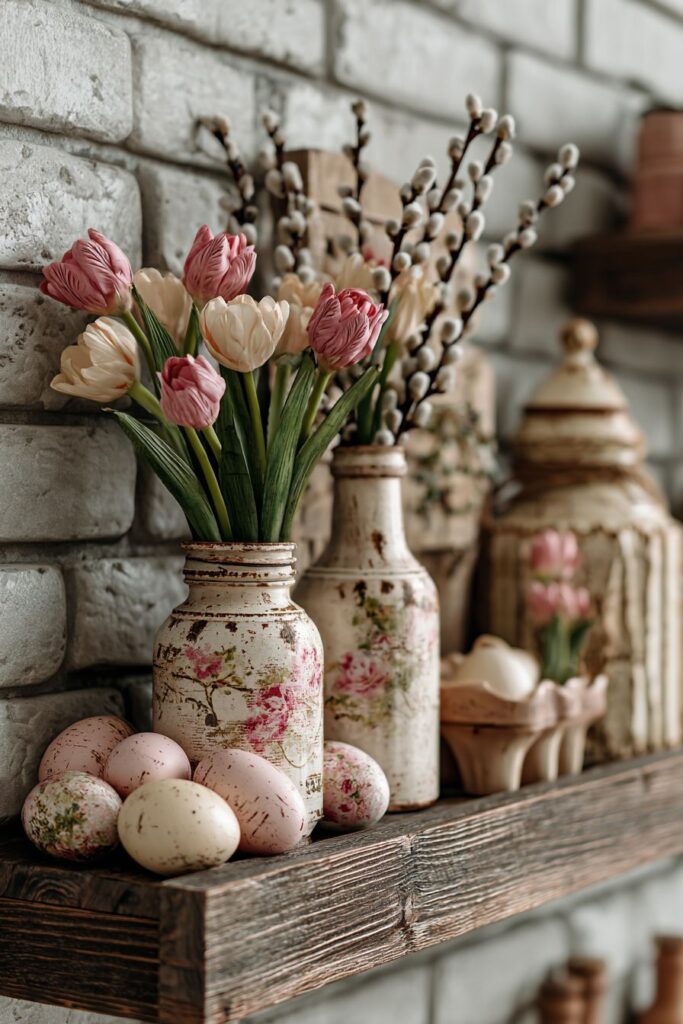
Key Design Tips:
- Source reclaimed wood for shelving to add instant character and environmental consciousness to your Easter display
- Mix pussy willows with traditional Easter flowers for unexpected textural contrast
- Create hand-painted eggs with distressed finishes that reveal underlying wood grain for authentic vintage appearance
- Use exposed brick walls as textural backdrops that enhance rather than compete with rustic displays
- Position lighting to create dramatic shadows that emphasize natural textures and imperfections as design features
8. Scandinavian Serenity Easter Table
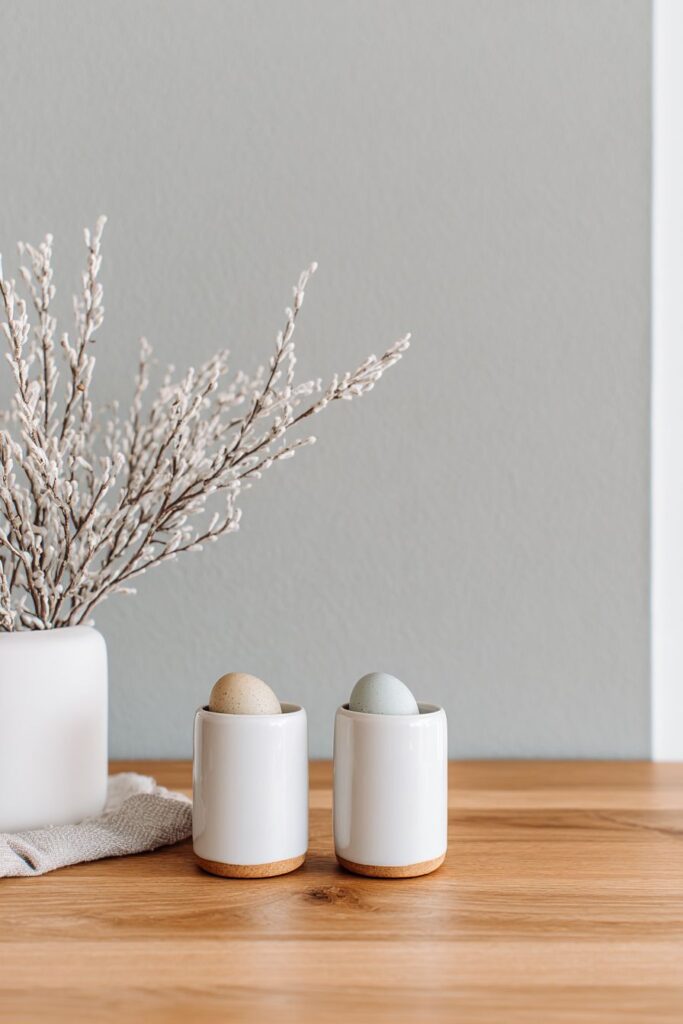
Simplicity reaches its zenith in this Scandinavian-inspired Easter kitchen decor that proves restraint can be profoundly beautiful. A light oak dining table, with its clean lines and natural blonde tones, sets the foundation for a display of thoughtful minimalism. Simple white ceramic egg cups—each a study in functional design perfection—are filled with naturally dyed eggs in muted pastels. These eggs aren’t garishly bright but rather showcase the subtle beauty achievable through natural dyeing techniques using botanical materials like red cabbage, turmeric, and beet juice.
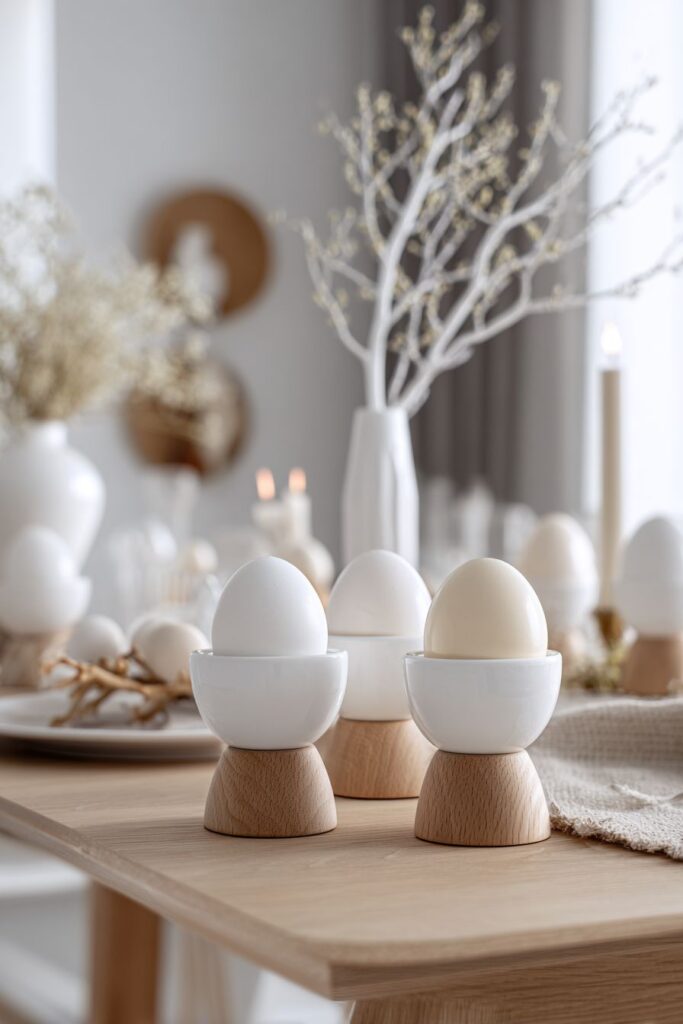
A single stem vase holds white branches, their graceful curves providing sculptural interest without overwhelming the serene composition. This could be birch, willow, or any branch with interesting form—the key is selecting one perfect specimen rather than creating abundance through quantity. The minimalist elegance of this choice embodies the Scandinavian principle of lagom—not too little, not too much, but just right. The white branches against pale grey walls create a subtle tonal study that’s sophisticated in its simplicity.
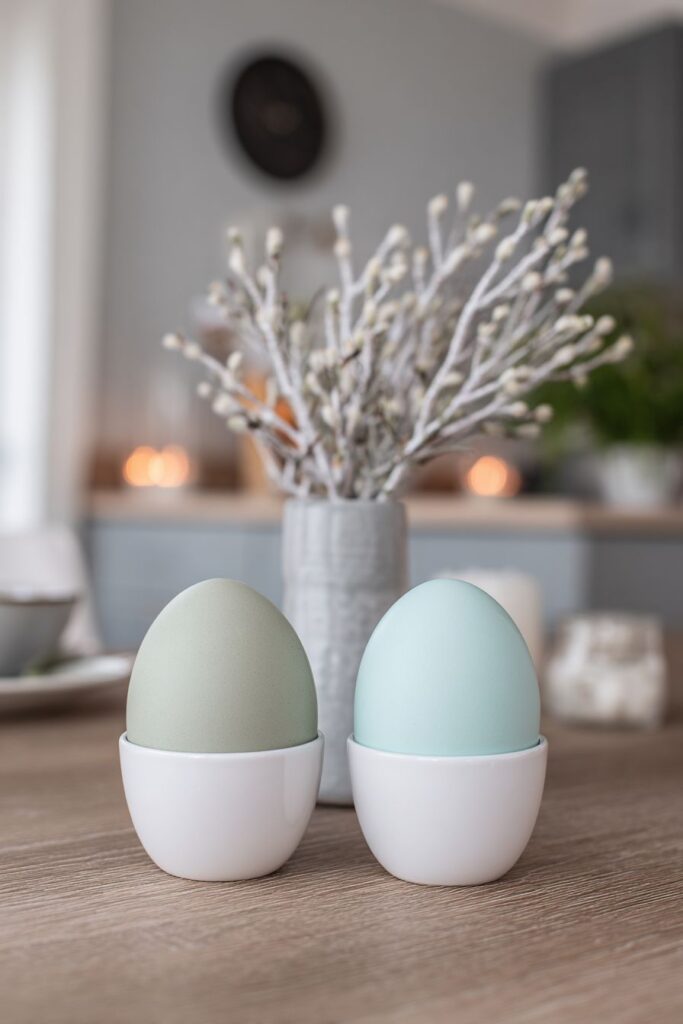
Abundant natural light floods the space, creating an airy feel that seems to expand the boundaries of the room. The pale grey walls provide just enough color to add warmth without disrupting the overall sense of lightness and space. This Easter kitchen decor approach demonstrates that celebration doesn’t require elaborate displays or bold colors—sometimes the most profound beauty lies in the careful curation of a few perfect elements, each given space to breathe and be appreciated on its own merits.
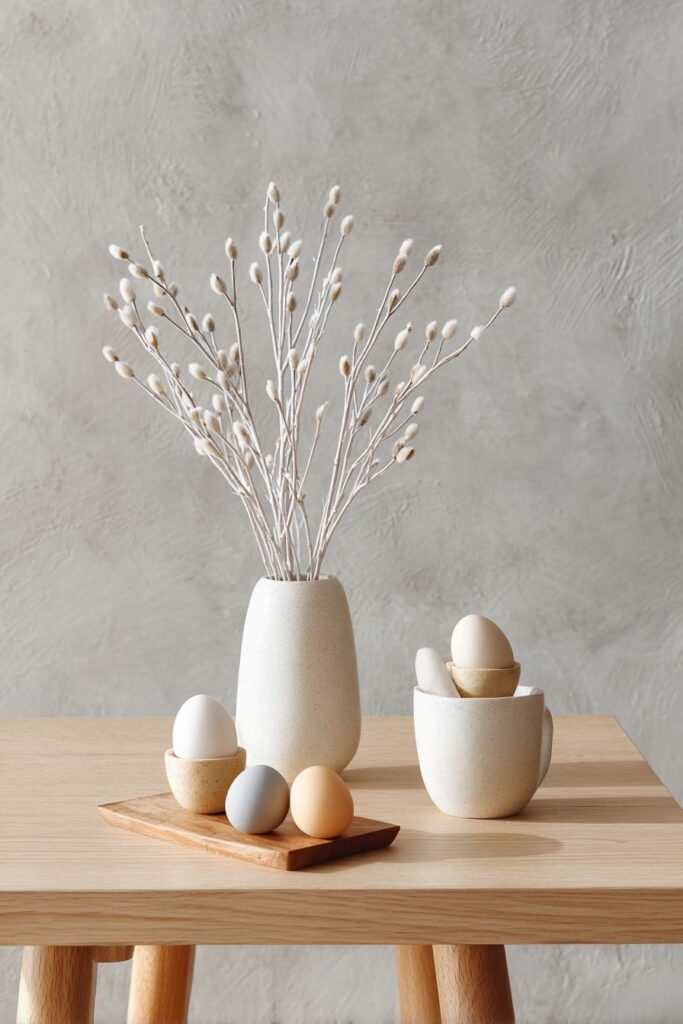
Key Design Tips:
- Embrace light oak or blonde wood furniture for authentic Scandinavian aesthetic foundations
- Use natural dyeing techniques with botanical materials to create soft, muted Easter egg colors
- Select single, perfect specimens of branches or flowers rather than abundant arrangements
- Paint walls in pale grey or soft whites to maximize natural light reflection and create airy atmosphere
- Practice restraint in decoration, allowing each element space to be individually appreciated
9. Nostalgic China Cabinet Easter Display

Glass-front cabinets become curated galleries in this traditional Easter kitchen decor approach that celebrates the beauty of collected treasures. Vintage Easter-themed china—plates adorned with hand-painted chicks, rabbits in garden settings, and delicate floral motifs—is arranged with the care of a museum exhibition. Each piece tells a story, perhaps passed down through generations or carefully hunted at antique markets and estate sales. The collection gains power through its cohesiveness, with similar color palettes and artistic styles creating visual harmony despite the variety of individual designs.
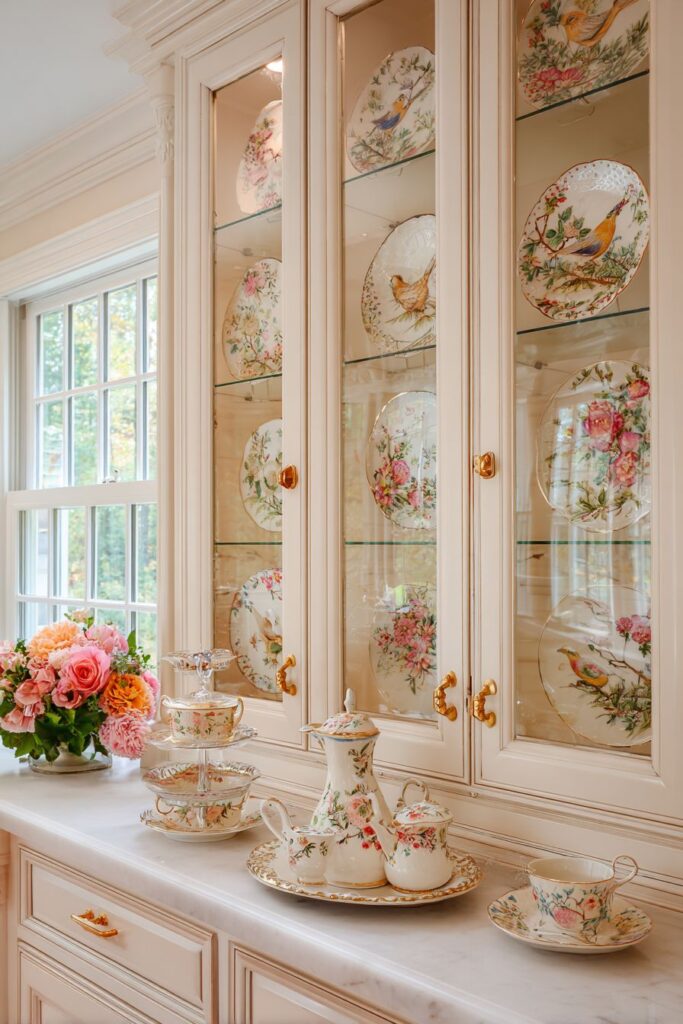
Polished brass hardware catches the light, adding warm metallic accents that complement the painted gold details often found on vintage china. These hardware elements—cabinet pulls, hinges, even the frame of the glass itself—become part of the overall decorative statement. Below the glass cabinets, a matching tea set sits ready on the counter, suggesting imminent use and connecting the displayed collection to daily life. This isn’t china that’s merely looked at but china that can be—and perhaps will be—used for Easter tea or celebration.
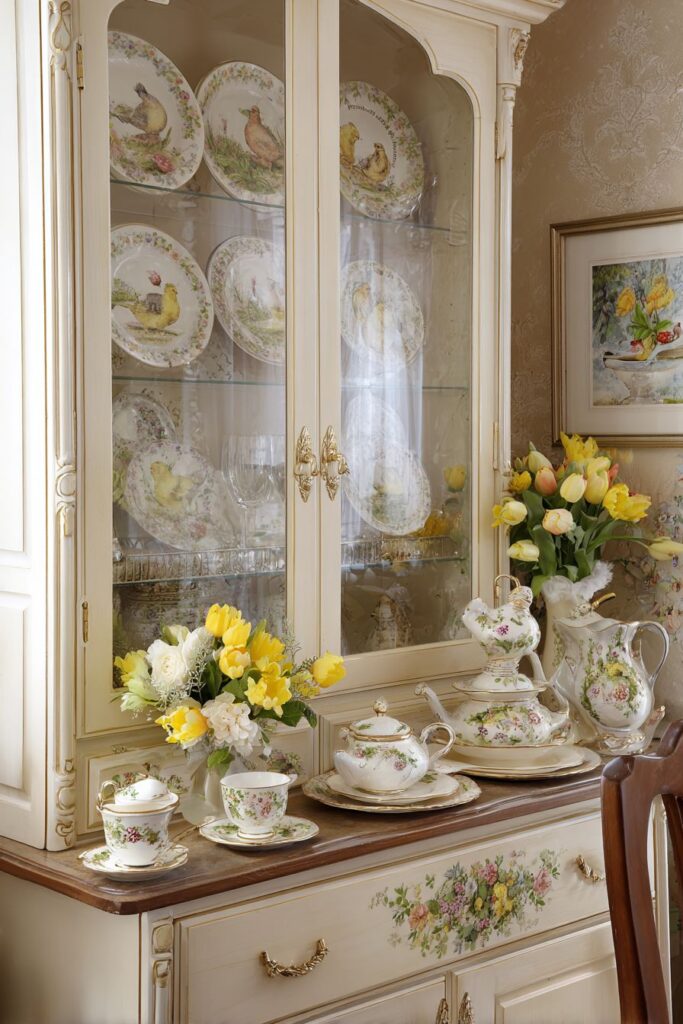
Natural daylight from adjacent windows illuminates the display, making the delicate painted details on ceramics truly sing. The way light plays through the glass doors creates interesting reflections and depth, adding dimensional interest to what could be a flat display. The translucency of fine china when backlit reveals the quality of the porcelain, while the hand-painted details become more vivid and appreciable. This Easter kitchen decor approach celebrates the art of collecting and the joy of displaying treasured objects that mark the season.

Key Design Tips:
- Curate vintage Easter china collections with cohesive themes and color palettes for unified visual impact
- Display treasured pieces in glass-front cabinets where they’re protected yet visible and appreciated
- Polish brass hardware to catch light and add warm metallic accents to vintage displays
- Position matching tea sets or serving pieces on counters below to suggest practical use alongside decorative display
- Maximize natural light from windows to illuminate delicate painted details and create depth through glass reflections
10. Contemporary Geometric Easter Statement
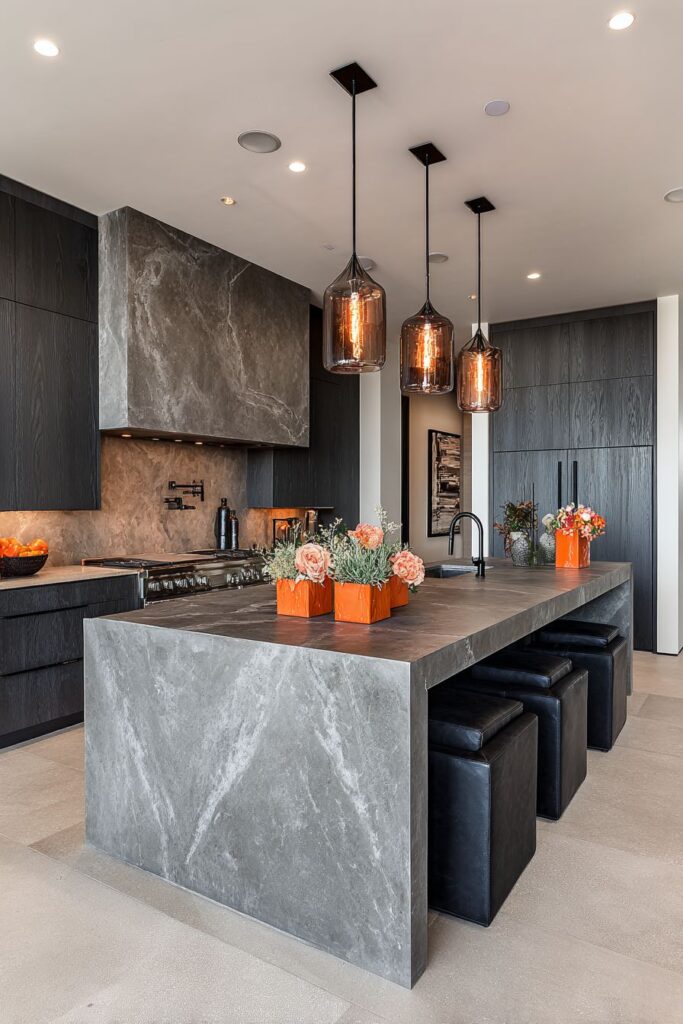
Modern design meets seasonal celebration in this contemporary Easter kitchen decor that reimagines traditional elements through a geometric lens. A sleek quartz breakfast bar provides a pristine, minimalist foundation for a linear arrangement that feels more like an art installation than conventional decoration. Geometric concrete planters—perhaps hexagonal, cubic, or pyramidal in form—create a striking visual rhythm along the counter. These planters hold fresh herbs like rosemary, thyme, or mint, introducing practical function alongside aesthetic appeal.
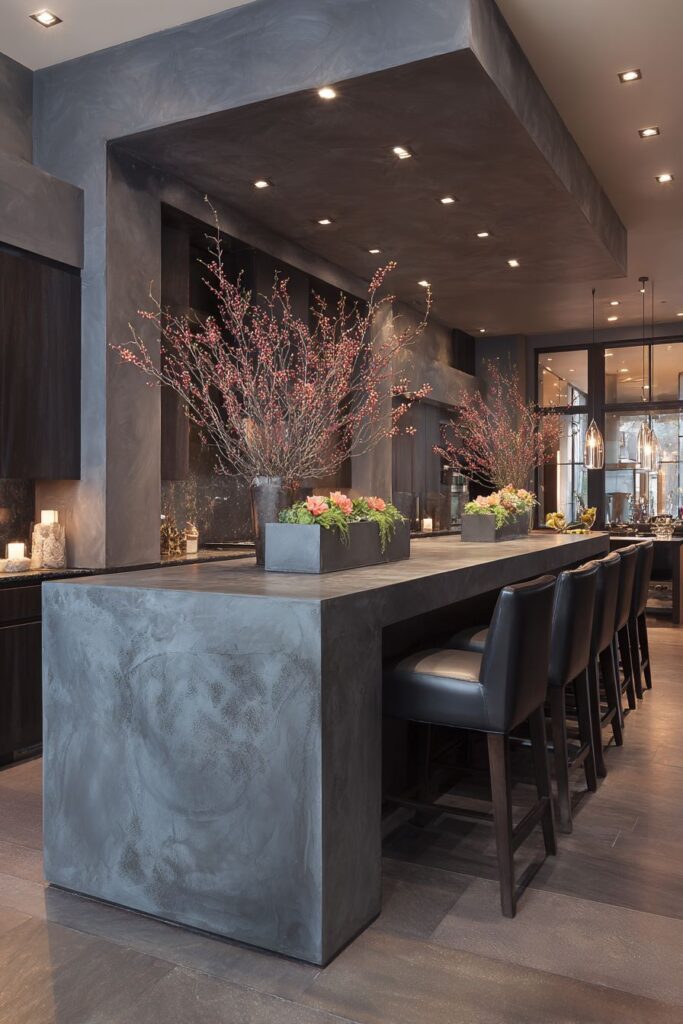
Small spring blooms in coral and peach tones punctuate the herb display, providing pops of seasonal color that feel sophisticated rather than overtly Easter-themed. These warm, sunset-inspired hues represent a contemporary interpretation of spring colors, moving beyond traditional pastels into more complex, nuanced territory. The blooms might include ranunculus, spray roses, or sweet peas—flowers with interesting forms that complement the geometric planters.
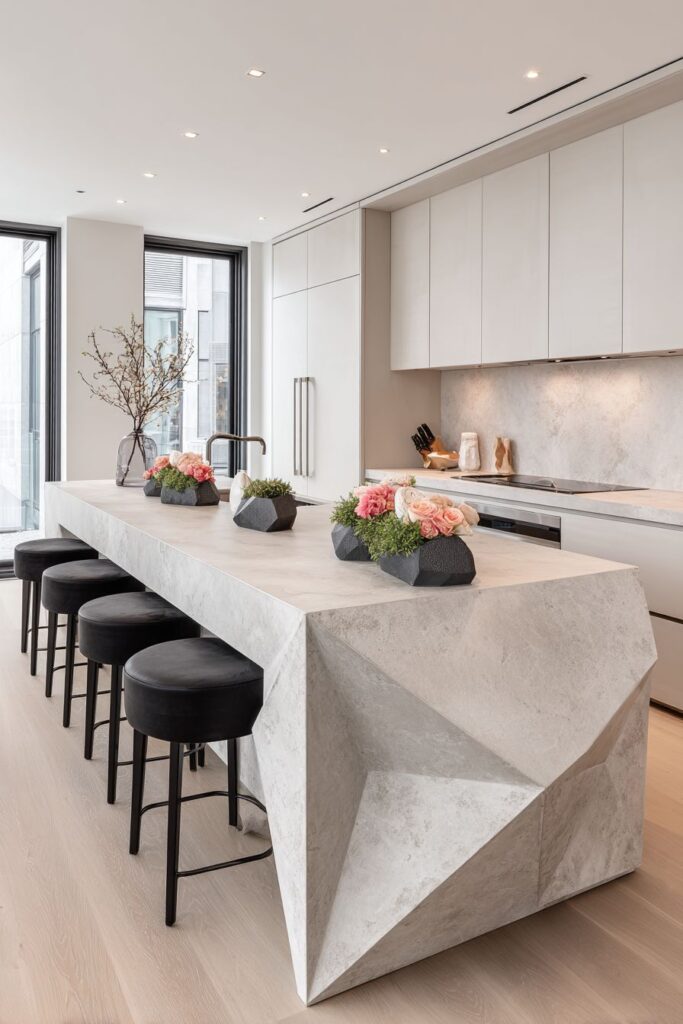
Matte black bar stools provide dramatic contrast, their dark silhouettes grounding the lighter display and creating visual weight that prevents the arrangement from feeling too ethereal. Recessed lighting creates even, gallery-like illumination that emphasizes the geometric forms and allows the subtle color variations to be fully appreciated. This Easter kitchen decor demonstrates that contemporary spaces can embrace seasonal decoration while maintaining their modern aesthetic integrity through thoughtful material selection, geometric forms, and a sophisticated color approach.
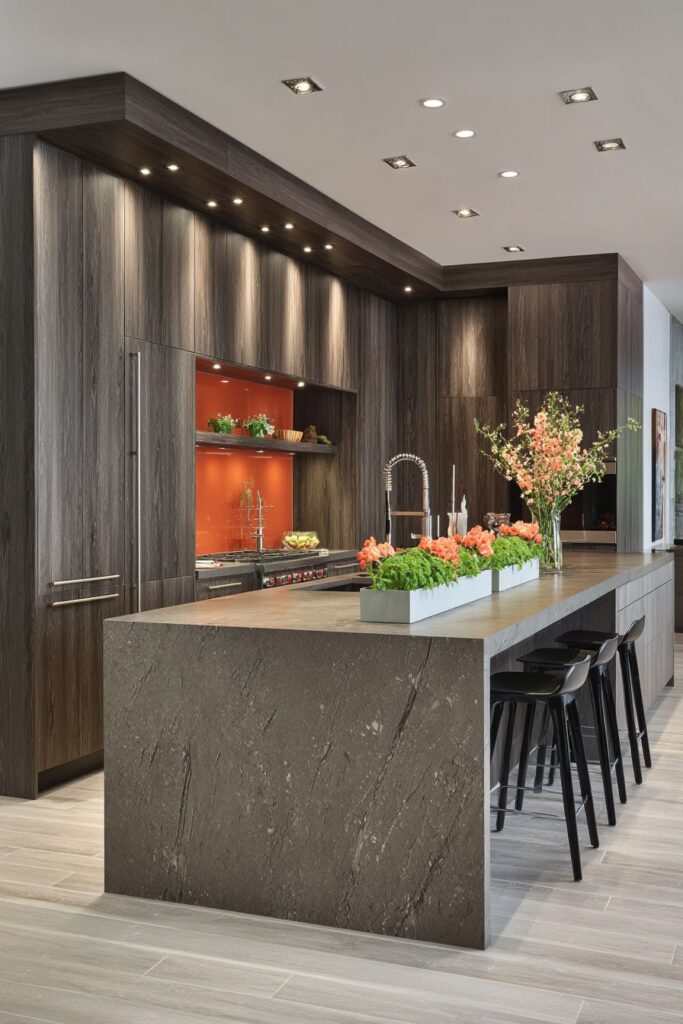
Key Design Tips:
- Select geometric concrete planters in architectural forms to create modern Easter displays with visual rhythm
- Combine functional herbs with decorative spring blooms for multi-purpose arrangements
- Choose coral and peach tones as sophisticated alternatives to traditional pastel Easter colors
- Use matte black elements to create grounding contrast against lighter seasonal displays
- Install recessed lighting for even, gallery-quality illumination that emphasizes geometric forms
11. Vintage Farmhouse Sink Display
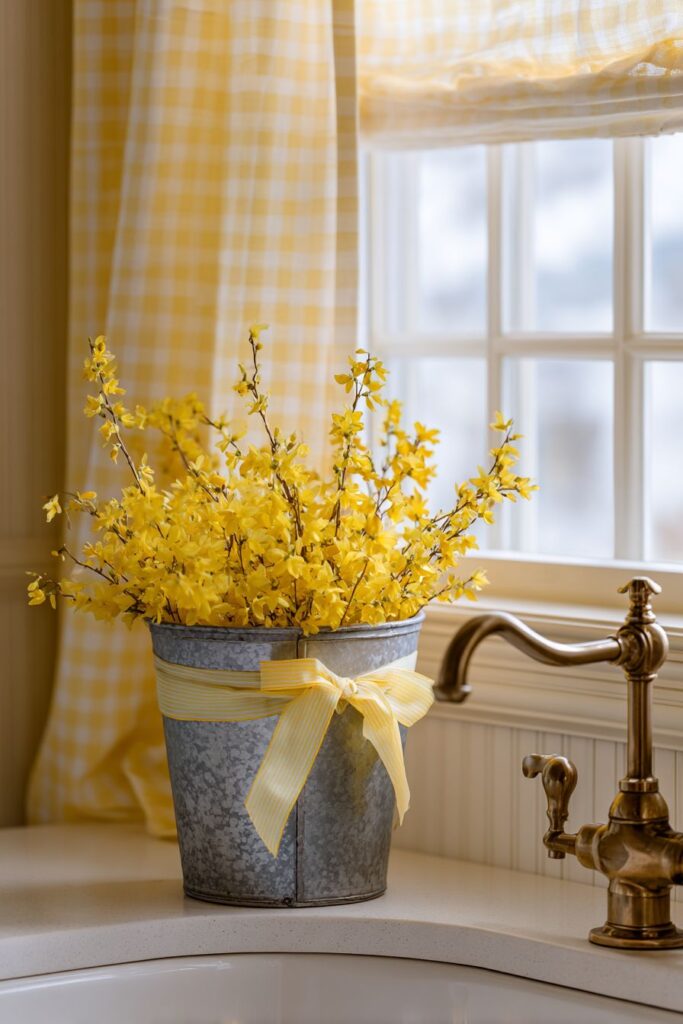
The farmhouse sink area becomes the heart of Easter kitchen decor in this charming approach that celebrates both vintage finds and fresh natural elements. A galvanized metal bucket—perhaps showing signs of gentle rust or patina that speak to its age—holds an abundant arrangement of fresh cut forsythia branches. These early spring bloomers bring their distinctive bright yellow flowers that announce the season’s arrival with unmistakable enthusiasm. Pastel ribbon accents woven through the branches add a softening touch, connecting the vibrant yellow to the broader Easter color palette.
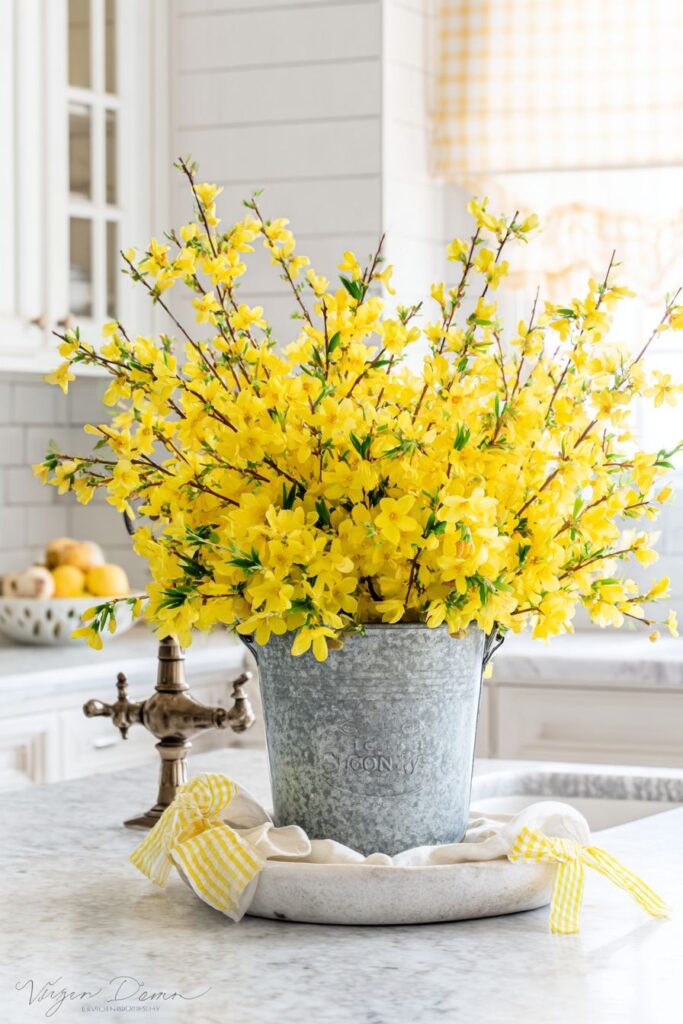
Cream subway tile and white beadboard walls create a classic backdrop that feels simultaneously timeless and specifically American in its farmhouse aesthetic. These architectural elements provide clean, textured surfaces that enhance rather than compete with the seasonal display. The subway tile’s subtle sheen catches light differently than the matte beadboard, creating quiet visual interest through material variation. An antique brass faucet adds warmth and vintage character, its slightly weathered finish suggesting years of faithful service.
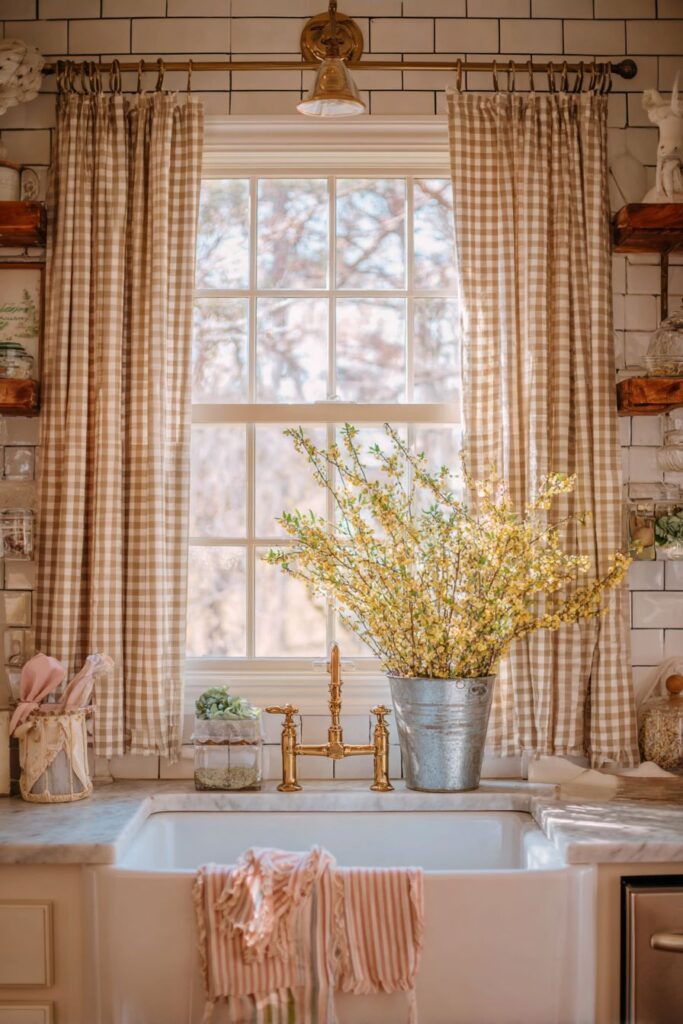
Soft morning light filters through café curtains in gingham check pattern—perhaps in soft yellow, sage green, or classic red and white—creating dappled illumination that changes throughout the day. The gingham pattern introduces a humble, nostalgic element that reinforces the farmhouse aesthetic while the curtain’s transparency ensures adequate natural light. This Easter kitchen decor approach succeeds through its authentic embrace of vintage elements paired with fresh, living seasonal touches that feel gathered from a spring garden.
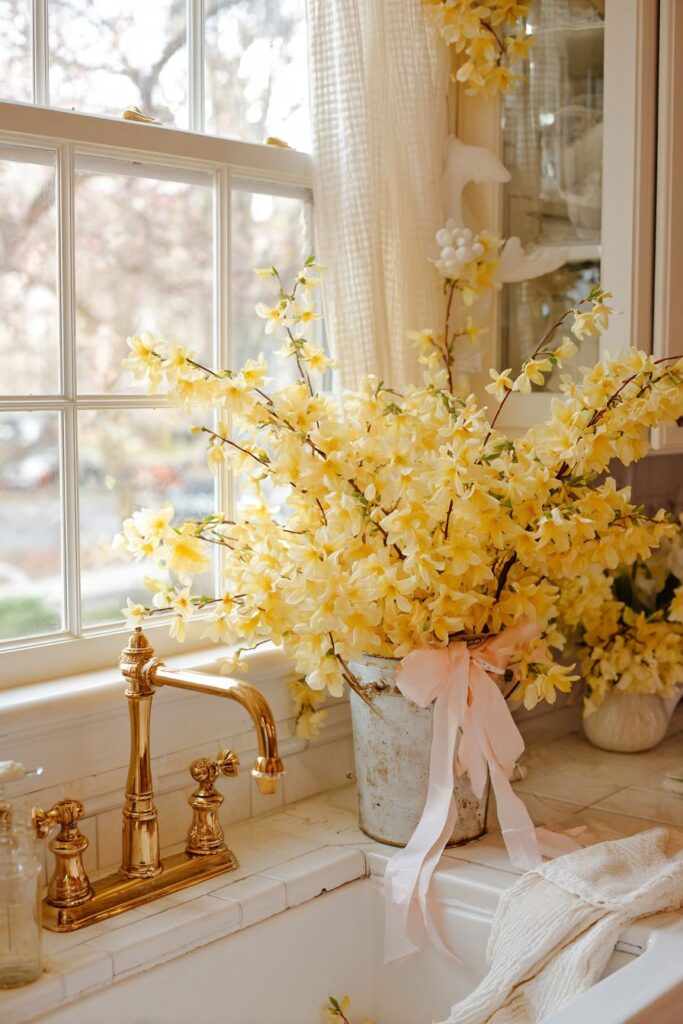
Key Design Tips:
- Use galvanized metal buckets or containers for authentic farmhouse vessel character
- Feature forsythia branches for their unmistakable early spring presence and vibrant yellow blooms
- Install cream subway tile and white beadboard for classic farmhouse architectural foundation
- Select antique or reproduction brass fixtures for warm metallic accents with vintage character
- Hang gingham café curtains to filter morning light while maintaining farmhouse aesthetic integrity
12. French Country Easter Romance
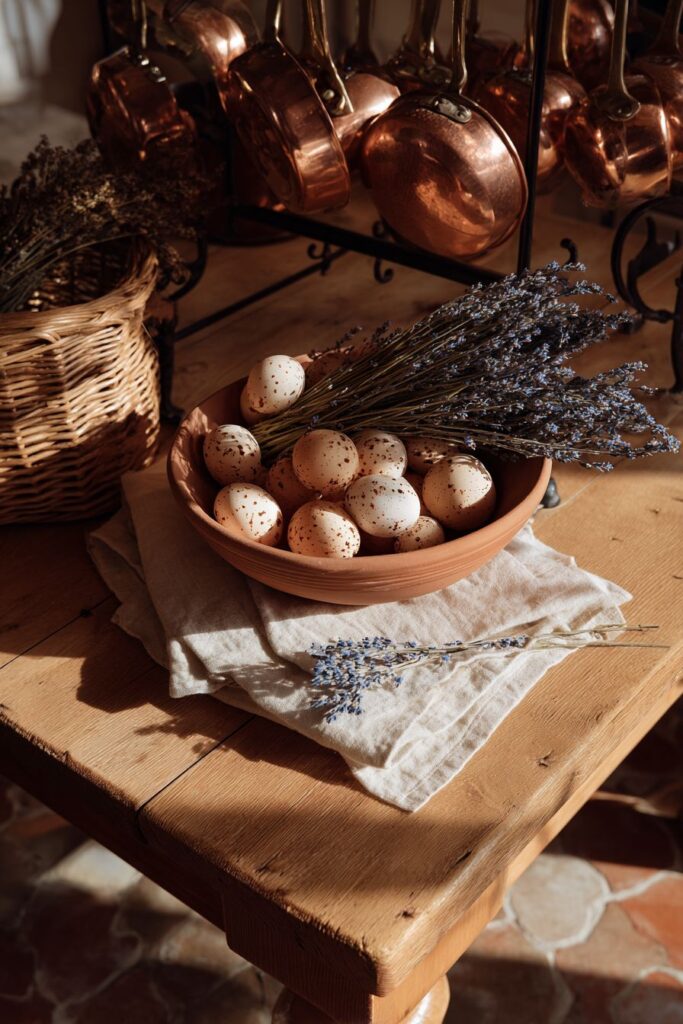
Butcher block warmth meets European elegance in this French country Easter kitchen decor that transports you to a Provençal farmhouse. The substantial butcher block island provides a work-worn surface rich with the patina of use, its honey-toned wood creating immediate warmth. Atop this foundation sits a terracotta bowl—unglazed, earthy, and honest in its simplicity—overflowing with an abundant collection of speckled eggs that look as though they came directly from a countryside henhouse.
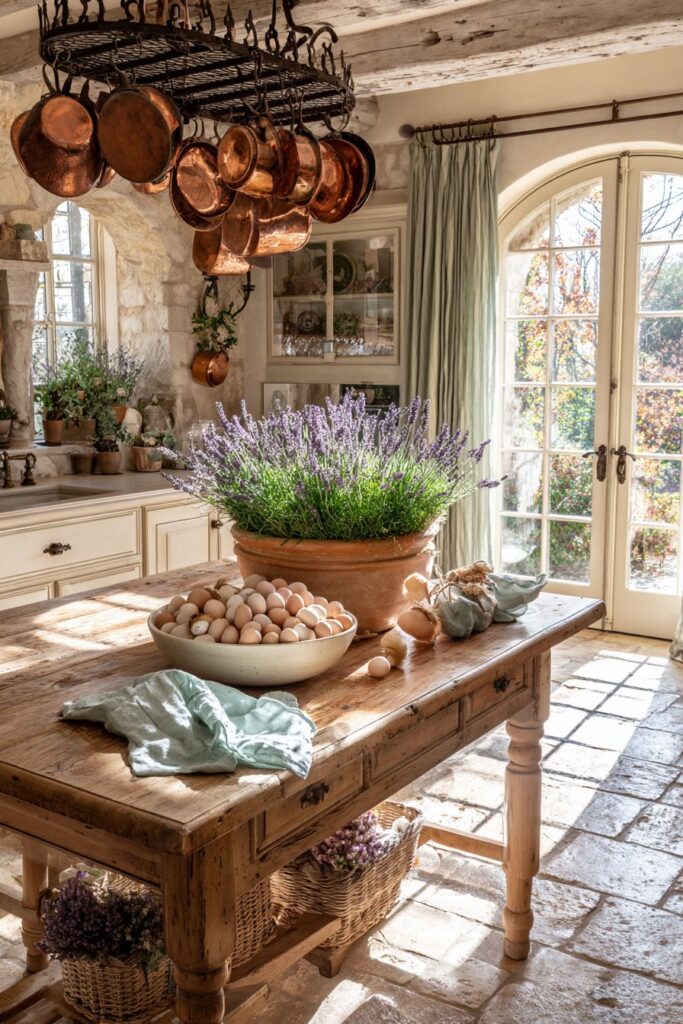
Lavender sprigs are tucked among the eggs, their grey-green foliage and purple blooms introducing both color and the unmistakable fragrance of Provence. This signature French plant brings authenticity to the display while providing aromatic ambiance that engages multiple senses. Natural linen napkins in pale blue are artfully draped or loosely folded nearby, their casual elegance and soft color suggesting relaxed refinement. The linen’s natural texture and slight irregularity add to the authentic, lived-in quality of the space.
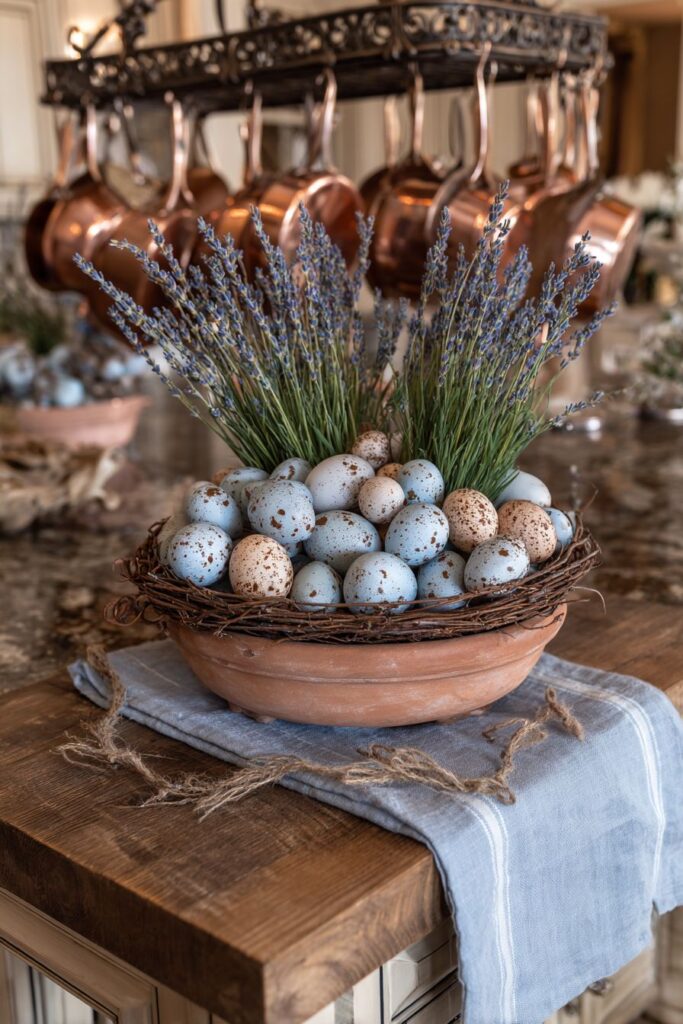
Above, a wrought iron pot rack holds copper cookware that catches light like treasured art pieces. The warm metallic tones of copper harmonize beautifully with the butcher block while the wrought iron adds structural, artistic elements that are both functional and decorative. Stone tile flooring grounds the space with earthy, substantial presence, its cool tones providing balance to the warm wood and metal elements. Natural light creates warm shadows and highlights that dance across surfaces, emphasizing textures and creating the kind of atmospheric depth that characterizes the finest French country interiors.
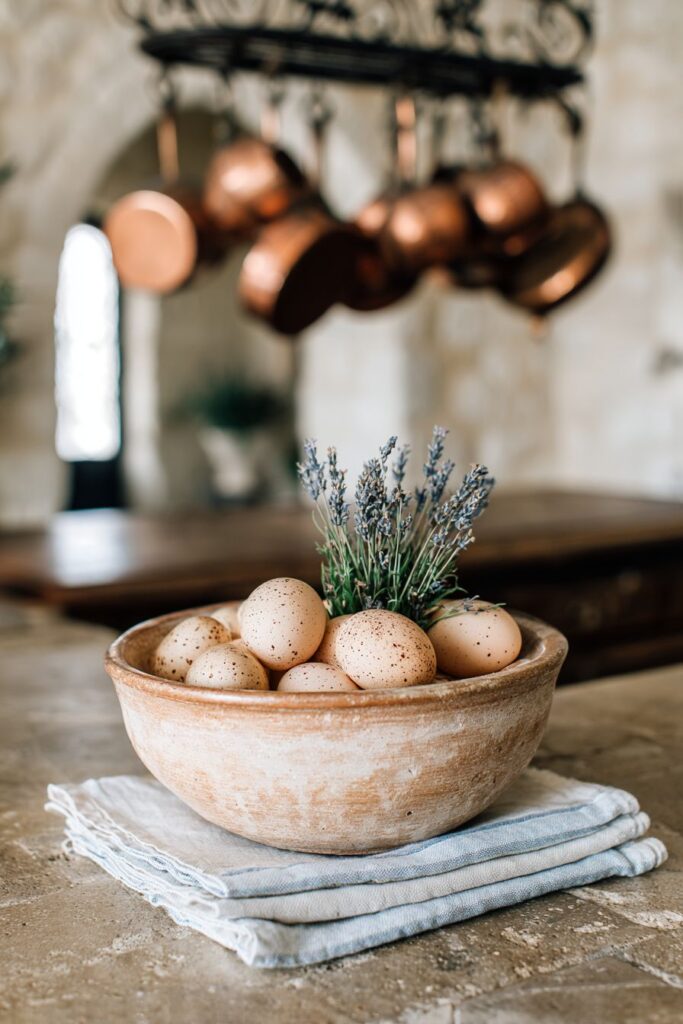
Key Design Tips:
- Feature butcher block surfaces for authentic French country warmth and work-worn character
- Use unglazed terracotta bowls filled with naturally speckled eggs for rustic, countryside authenticity
- Incorporate fresh lavender sprigs for signature Provençal fragrance and grey-green color accents
- Display copper cookware on wrought iron racks as functional art that adds warm metallic tones
- Install stone tile flooring to ground the space with earthy, substantial European character
13. Cozy Breakfast Nook Easter Haven
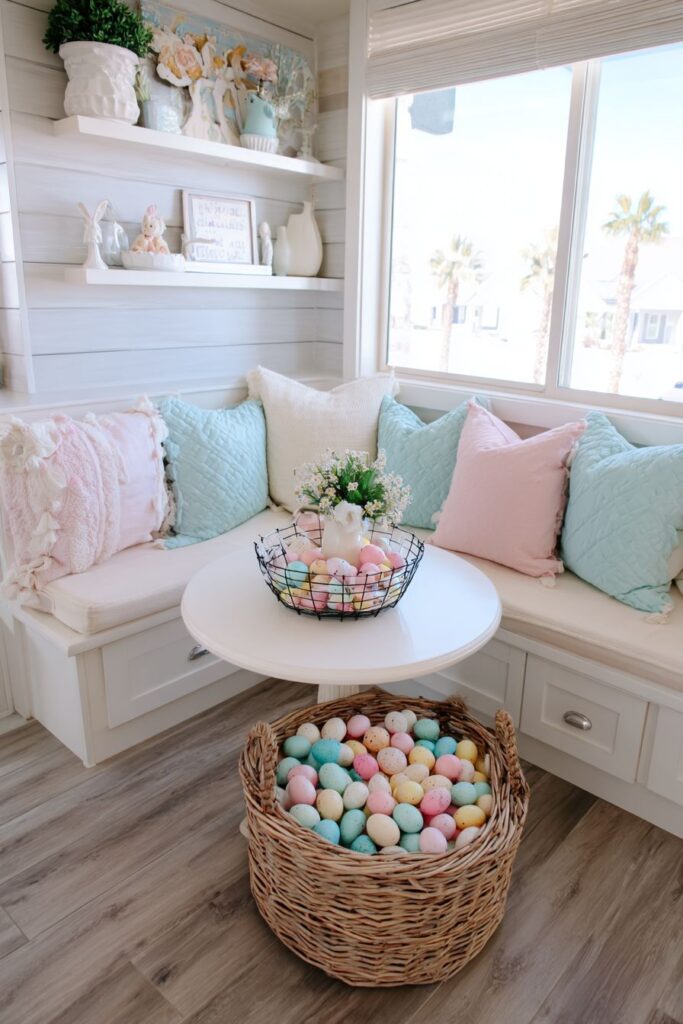
A built-in breakfast nook transforms into an Easter haven through thoughtful textile layering and color coordination. White painted wood seating provides a clean foundation that’s enhanced with an abundance of pastel throw pillows in mint, blush, and cream. These pillows aren’t merely decorative afterthoughts but are carefully selected for their varying textures—perhaps including velvet, linen, and cotton—that create tactile interest and inviting comfort. The color coordination creates visual harmony while the textural variety prevents the space from feeling flat or one-dimensional.
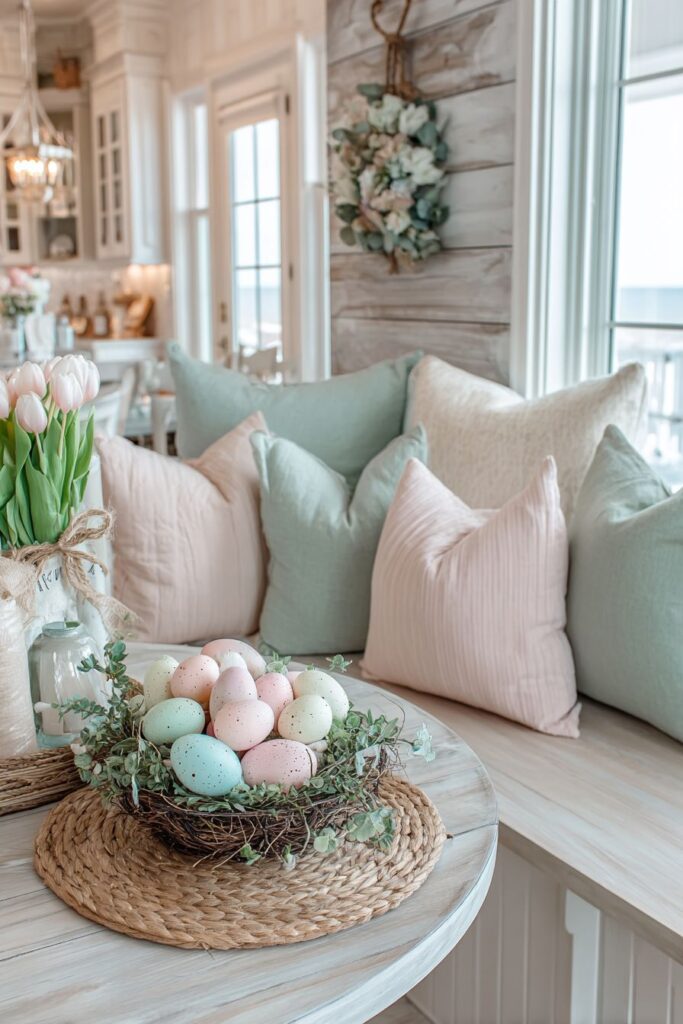
The small round table at the nook’s center features a simple yet effective centerpiece: colored eggs arranged in a wire basket with fresh greenery woven throughout. The basket’s open construction allows the eggs to be fully visible and appreciated while the greenery—perhaps eucalyptus, fern fronds, or ivy—softens the arrangement and introduces organic movement. This centerpiece maintains functionality by keeping the table surface largely clear for dining while providing enough visual interest to mark the space as special and seasonally decorated.
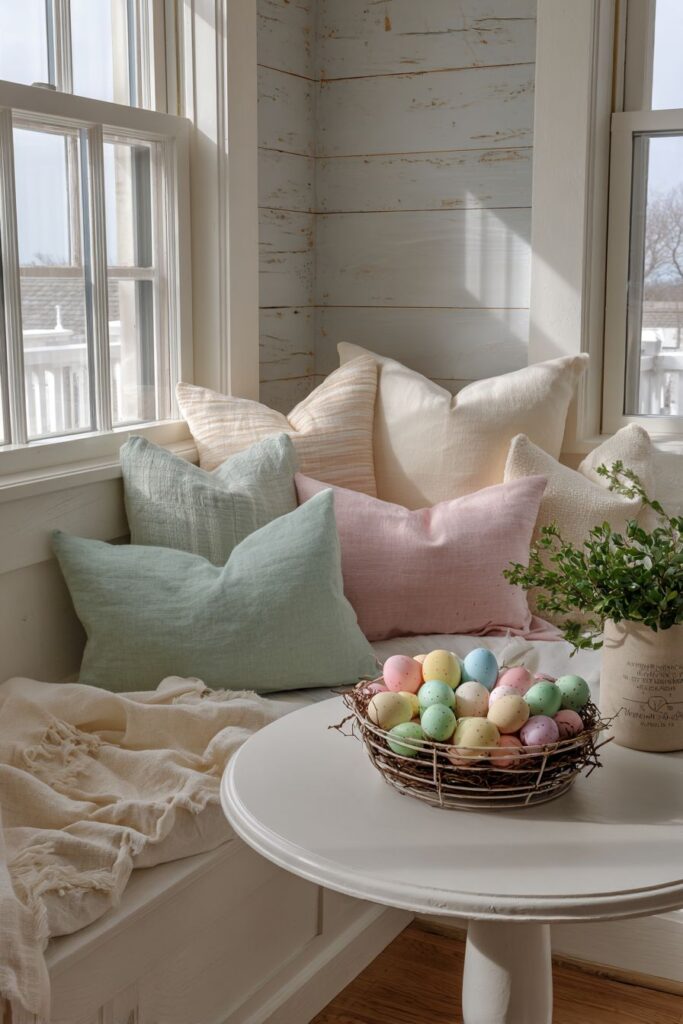
Shiplap walls painted in soft grey provide subtle texture that enhances the cozy atmosphere without overwhelming the space. The horizontal lines of shiplap create visual movement that makes the nook feel designed and intentional rather than simply a casual breakfast spot. Window light floods the area, creating a bright, cheerful environment perfect for morning coffee or leisurely weekend brunches. This Easter kitchen decor approach demonstrates that holiday decoration can enhance everyday comfort, creating spaces that are both festive and genuinely livable.
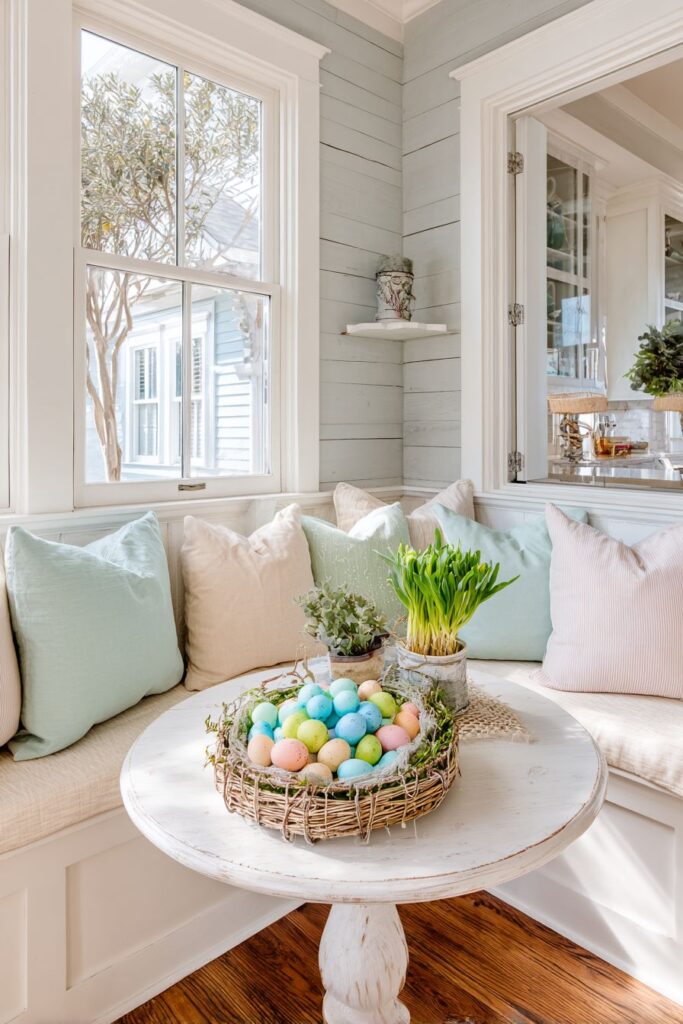
Key Design Tips:
- Layer pastel throw pillows in varying textures like velvet, linen, and cotton for dimensional comfort
- Keep table centerpieces simple with wire baskets of eggs and greenery to maintain dining functionality
- Paint shiplap walls in soft grey for subtle texture that enhances without overwhelming small spaces
- Position breakfast nooks near windows to maximize natural light and create cheerful morning environments
- Balance Easter decoration with everyday comfort to create spaces that are both festive and livable
14. Industrial-Chic Easter Fusion
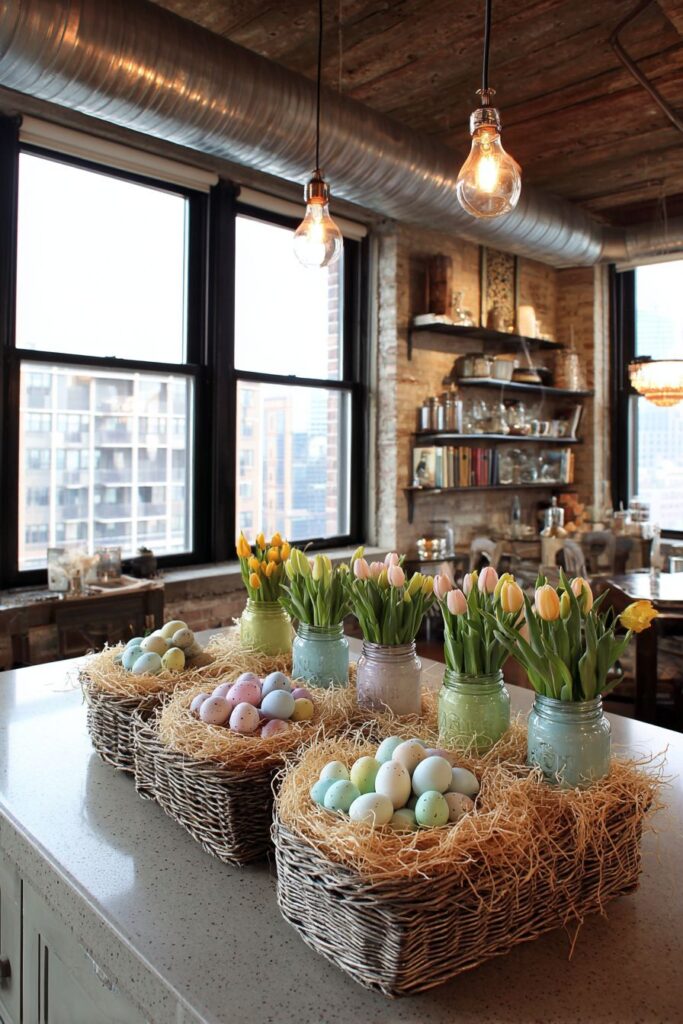
Unexpected material combinations create magic in this industrial-chic Easter kitchen decor that proves seasonal celebration can transcend traditional style boundaries. Metal open shelving with its honest, utilitarian aesthetic becomes the unlikely stage for delicate Easter displays. Pastel-colored vintage mason jars—perhaps in pale pink, soft aqua, or mint green—line the shelves, each filled with spring flowers that bring organic softness to the industrial setting. Decorated eggs rest on beds of natural straw within some jars, creating miniature still-life compositions that blend country charm with urban edge.

Concrete countertops provide raw, substantial surfaces that ground the space with industrial authenticity. Their grey tones and slightly irregular finish create textural interest while providing a neutral backdrop that allows the pastel accents to truly pop. Exposed ductwork overhead, rather than being hidden, becomes a celebrated architectural element that reinforces the industrial aesthetic. This honest approach to building systems creates visual interest and loft-like atmosphere.
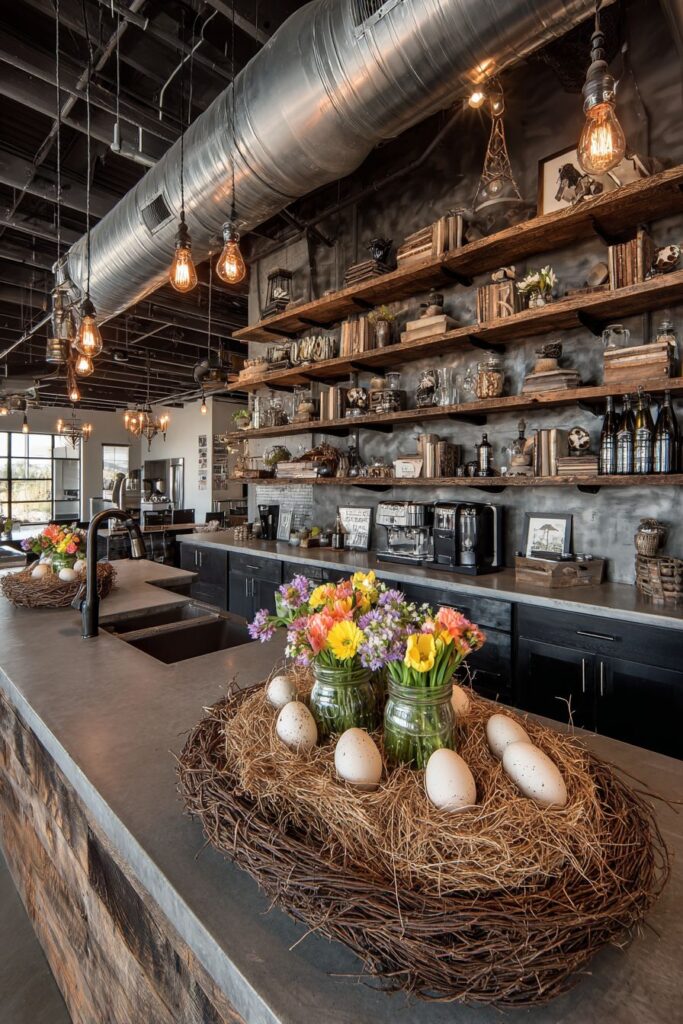
Edison bulb pendants suspended at varying heights provide warm, amber-toned lighting that softens the industrial materials and creates intimate pockets of illumination. The visible filaments within these vintage-style bulbs add another layer of visual interest while their warm glow counterbalances the cool tones of metal and concrete. Natural light from tall windows—perhaps factory-style with black frames—balances the artificial lighting and prevents the space from feeling too moody or dim. This Easter kitchen decor approach celebrates creative contrast and the beauty found in unexpected material pairings.
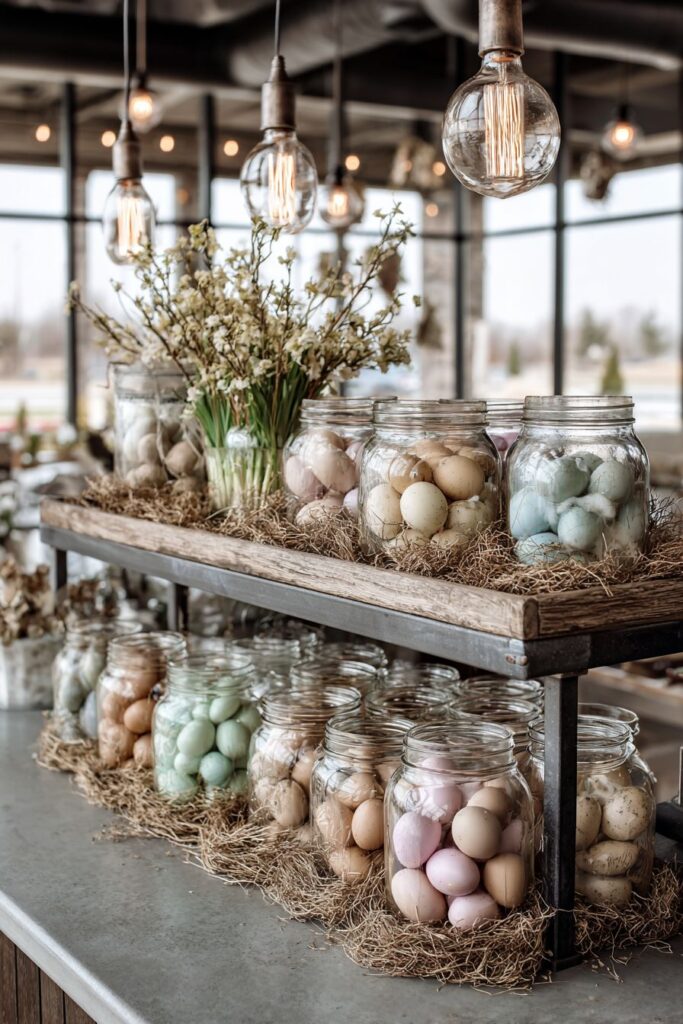
Key Design Tips:
- Use metal open shelving as an industrial foundation for unexpected Easter displays
- Fill pastel vintage mason jars with spring flowers and eggs on straw for country-industrial fusion
- Embrace concrete countertops for raw, substantial surfaces that ground eclectic design approaches
- Celebrate exposed ductwork and building systems as architectural features rather than hiding them
- Install Edison bulb pendants for warm ambient lighting that softens industrial materials
15. Window Treatment Easter Charm
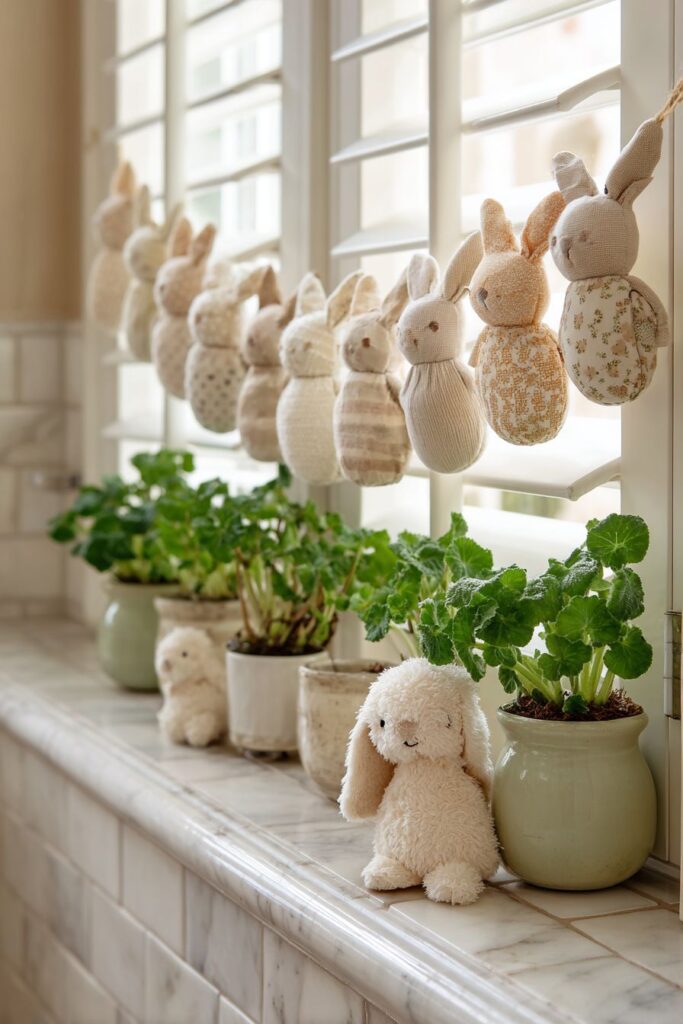
Sometimes the most impactful Easter kitchen decor focuses on a single, well-executed element. In this approach, the kitchen window becomes the star through a charming fabric garland strung across white shutters. The garland features fabric bunnies and eggs in soft, coordinated patterns—perhaps gingham, tiny florals, and polka dots in pastel hues. These handmade or artisan-crafted elements bring whimsy without feeling childish, their fabric construction adding textural warmth and handcrafted character.
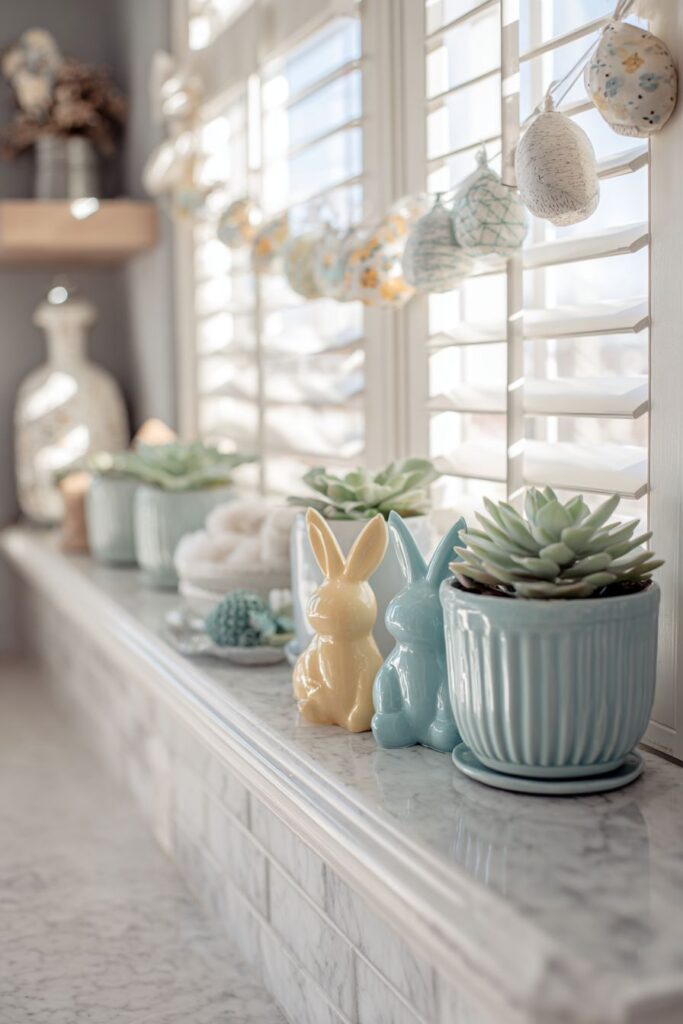
The windowsill below continues the theme with potted primrose plants in pastel ceramic pots. These early spring bloomers provide living color that changes and grows throughout the season, their cheerful faces turning toward the light. The ceramic pots might feature subtle embossed patterns or simple color blocking in shades that echo the fabric garland above, creating vertical visual continuity. White subway tile and marble counters surrounding the window keep the focus squarely on these seasonal details, their neutral perfection allowing the Easter elements to command full attention.
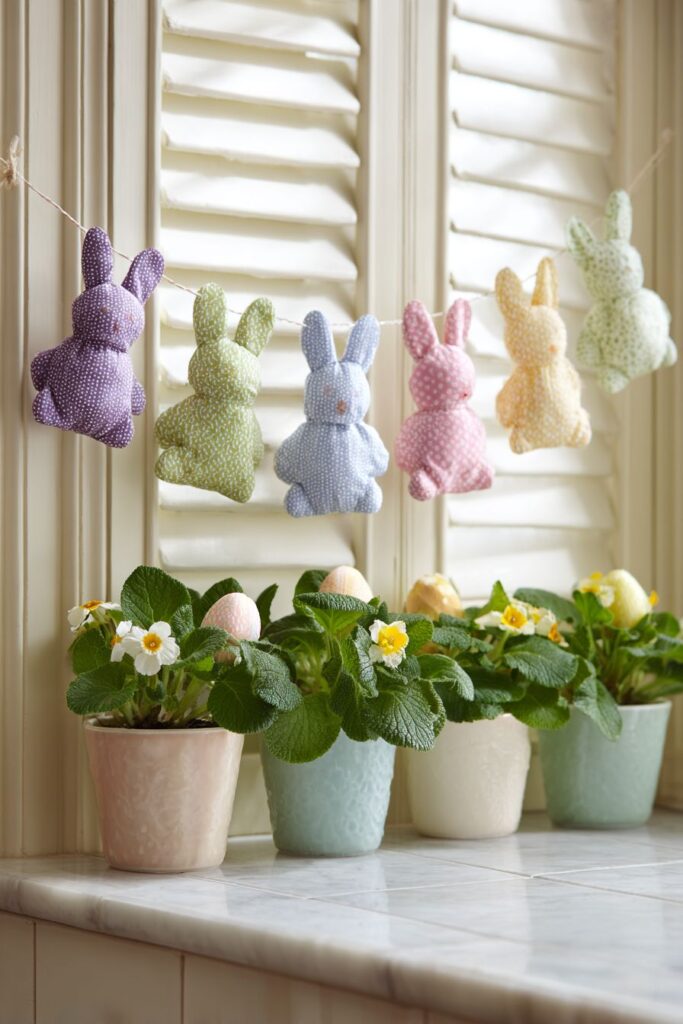
Morning sunlight filtering through the shutters and garland creates a cheerful glow that transforms the entire area into a beacon of spring. The way light plays through and around the fabric elements creates interesting shadow patterns on the surrounding surfaces, adding dynamic visual interest that changes throughout the day. This Easter kitchen decor approach proves that strategic focal points can be more effective than comprehensive decoration, creating memorable impact through concentrated design attention.
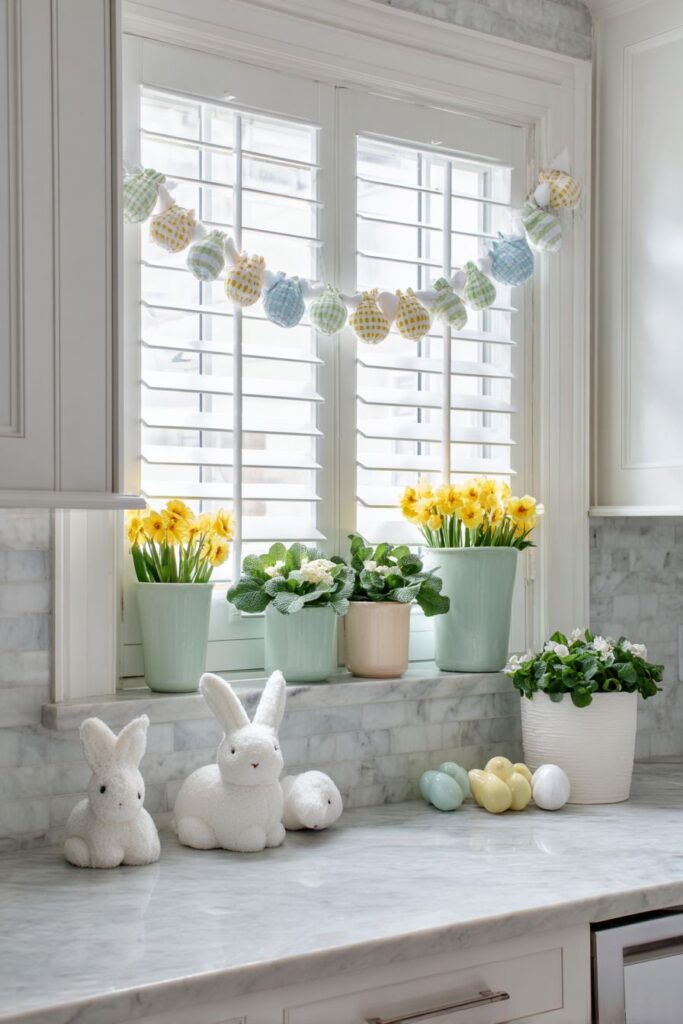
Key Design Tips:
- Create fabric garlands with coordinated patterns in soft pastels for handcrafted window charm
- String garlands across white shutters to frame windows with seasonal interest
- Line windowsills with potted primrose in pastel ceramic pots for living, growing displays
- Keep surrounding surfaces neutral to allow window treatments to serve as clear focal points
- Position seasonal window displays where morning light will create cheerful, dynamic illumination
16. Coastal Easter Fresh Air
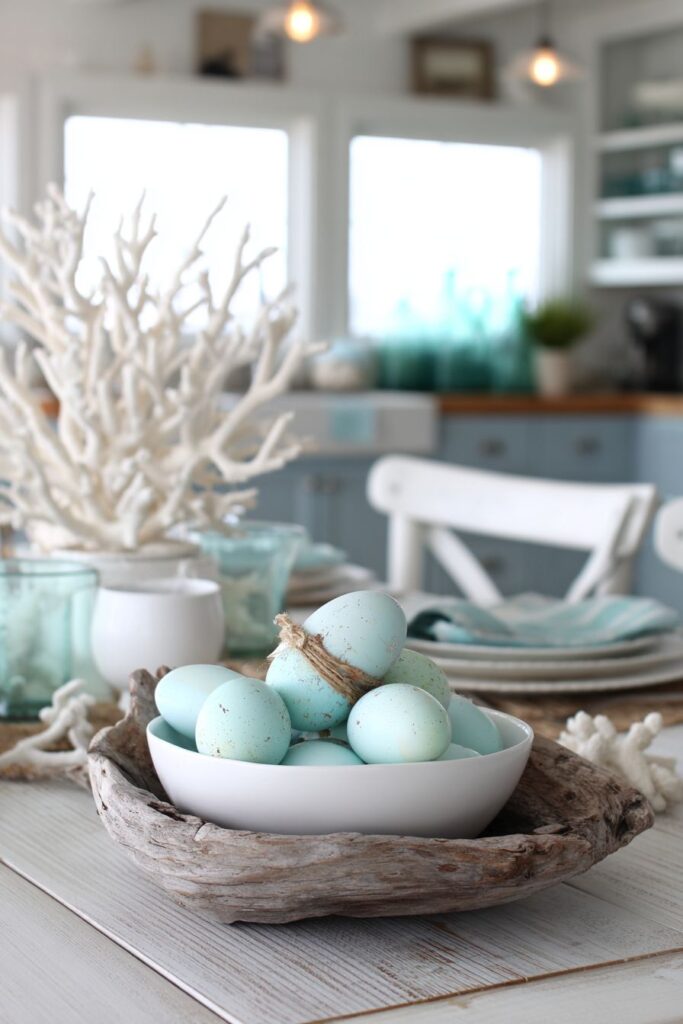
Beach-inspired elements bring a fresh perspective to Easter kitchen decor in this coastal interpretation that swaps traditional pastels for ocean-inspired hues. A whitewashed wood kitchen table provides the perfect foundation, its weathered finish suggesting driftwood washed up on shore. The centerpiece is a natural driftwood bowl—perhaps found during beach walks or sourced from coastal artisans—filled with decorated eggs in turquoise and seafoam green. Natural twine wrapping around the eggs adds textural interest while reinforcing the organic, beachy aesthetic.
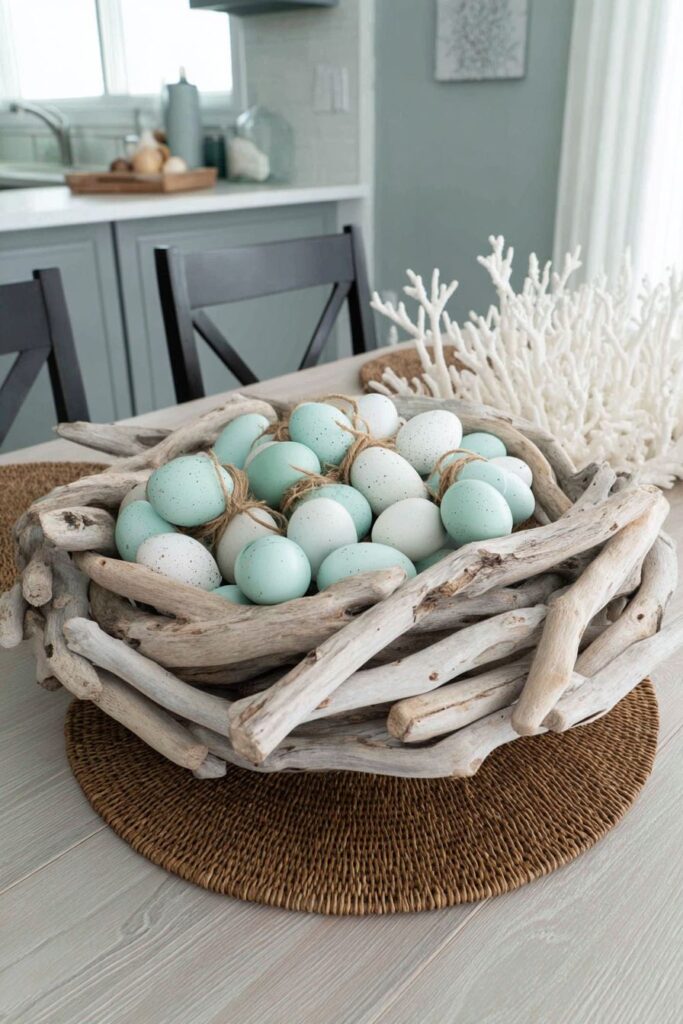
Seagrass placemats introduce woven texture that evokes beach grass swaying in coastal breezes, while white coral branches create sculptural focal points that are both organic and architectural. These coral pieces—whether real specimens or artisan reproductions—add vertical interest and connect the display to marine environments. Soft blue-grey cabinetry in the background provides subtle color that suggests foggy mornings or calm seas, creating atmospheric depth without overwhelming the space.
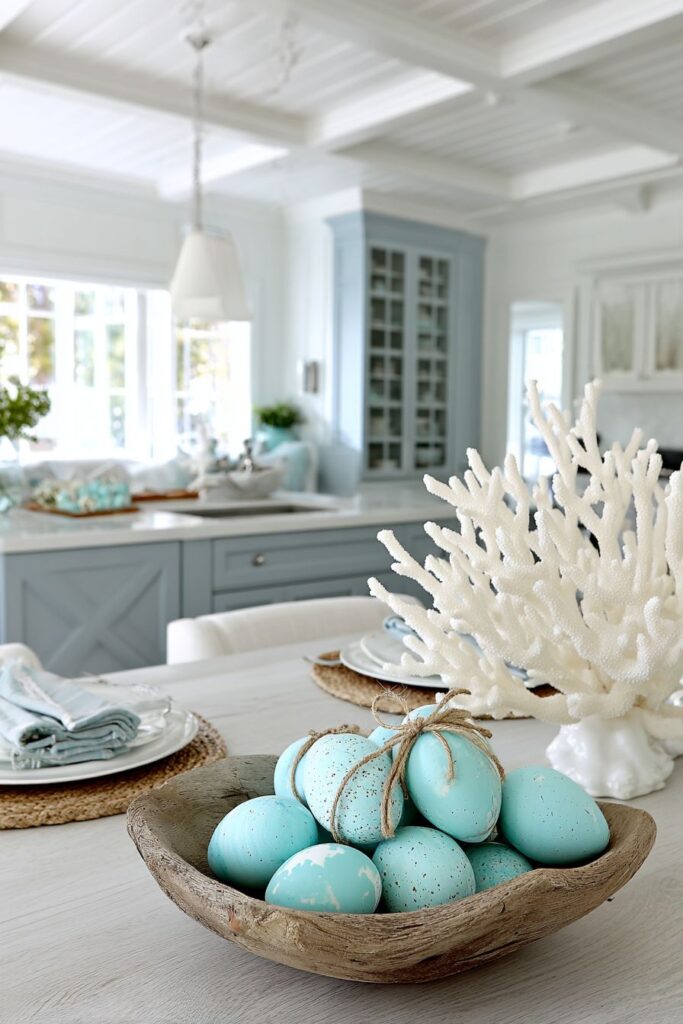
Bright, airy natural lighting mimics the quality of seaside atmosphere where light seems to bounce and shimmer. Large windows or glass doors might allow actual sea breezes to drift through, carrying salt air that enhances the coastal theme. This Easter kitchen decor approach demonstrates that holiday decoration can be regionally inspired, incorporating local landscape and natural elements to create something both seasonal and personally meaningful. The ocean-inspired color palette offers a sophisticated alternative to traditional Easter pastels while maintaining the fresh, optimistic spirit of spring.
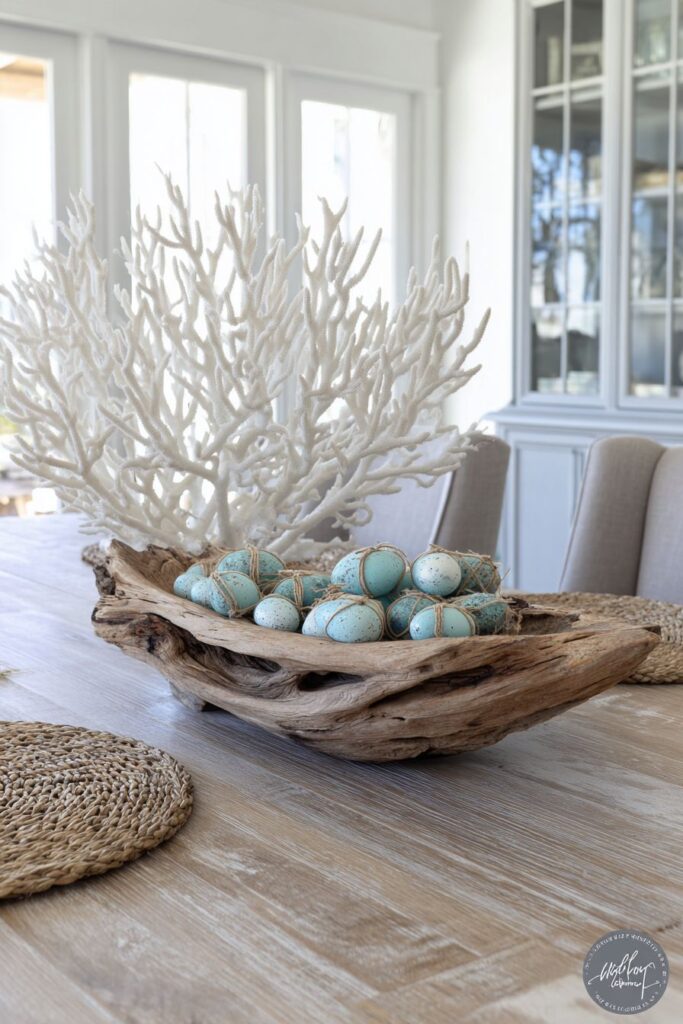
Key Design Tips:
- Use whitewashed wood furniture for driftwood-inspired coastal foundation
- Decorate eggs in turquoise and seafoam green for sophisticated ocean-inspired Easter palette
- Incorporate natural driftwood bowls and white coral branches for authentic marine elements
- Install soft blue-grey cabinetry to create atmospheric coastal depth
- Maximize natural light to achieve bright, airy atmosphere reminiscent of seaside environments
17. Entertaining-Ready Easter Elegance
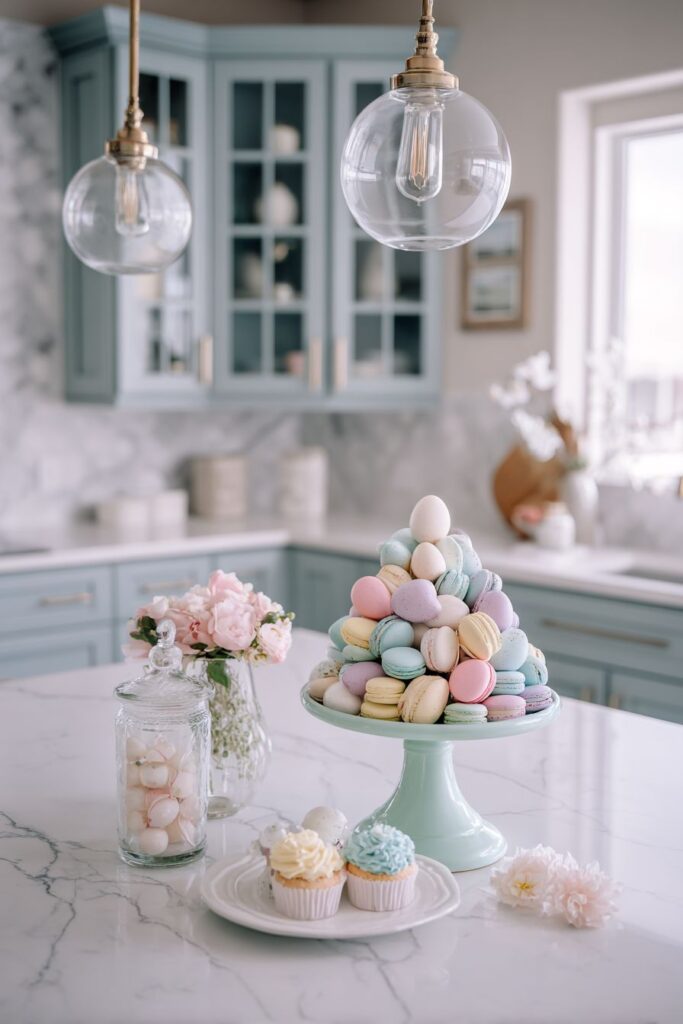
The kitchen peninsula becomes an elegant entertaining station in this sophisticated Easter kitchen decor approach. A tiered cake stand—typically reserved for desserts—is cleverly repurposed to display pastel macarons, small decorated eggs, and delicate spring flower petals. This vertical presentation creates visual drama while maintaining practical accessibility, allowing guests to admire and partake in the display. The macarons might include flavors like lavender, rose, and lemon that coordinate with the Easter theme through both color and seasonal ingredients.
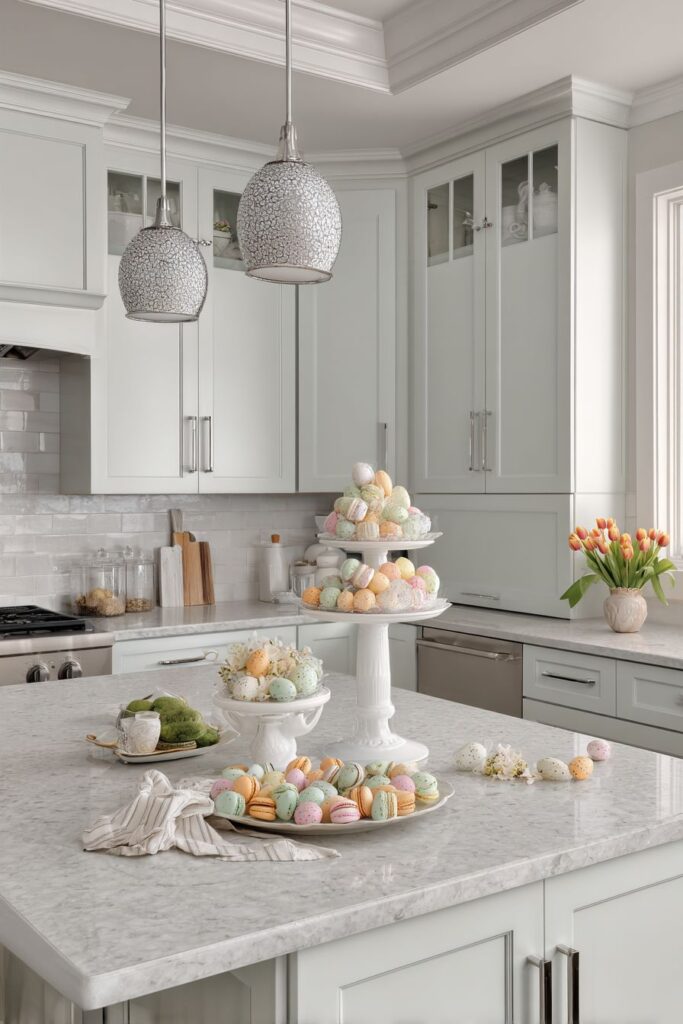
White quartz countertop with subtle grey veining provides an elegant base that suggests marble’s luxury without the maintenance concerns. The veining adds just enough visual movement to prevent the surface from appearing flat while maintaining the clean, sophisticated aesthetic. Brushed nickel hardware and fixtures throughout the kitchen complement the soft color scheme, their warm metallic finish adding polish without the formality of polished chrome or the rustic weight of bronze.
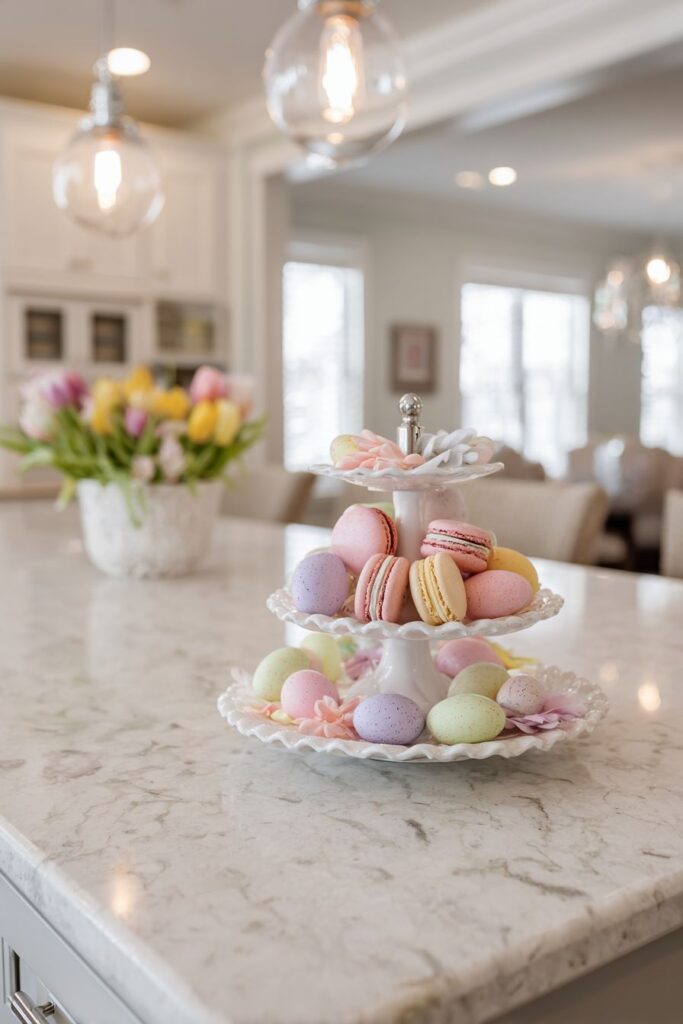
Pendant lighting suspended above creates gentle highlights that make the display almost glow, drawing attention and creating ambiance perfect for gathering and conversation. The focused illumination emphasizes the careful vertical styling and allows the delicate colors and textures to be fully appreciated. This Easter kitchen decor approach demonstrates that seasonal decoration can be simultaneously beautiful and functional, creating displays that enhance entertaining while serving as conversation pieces in their own right.
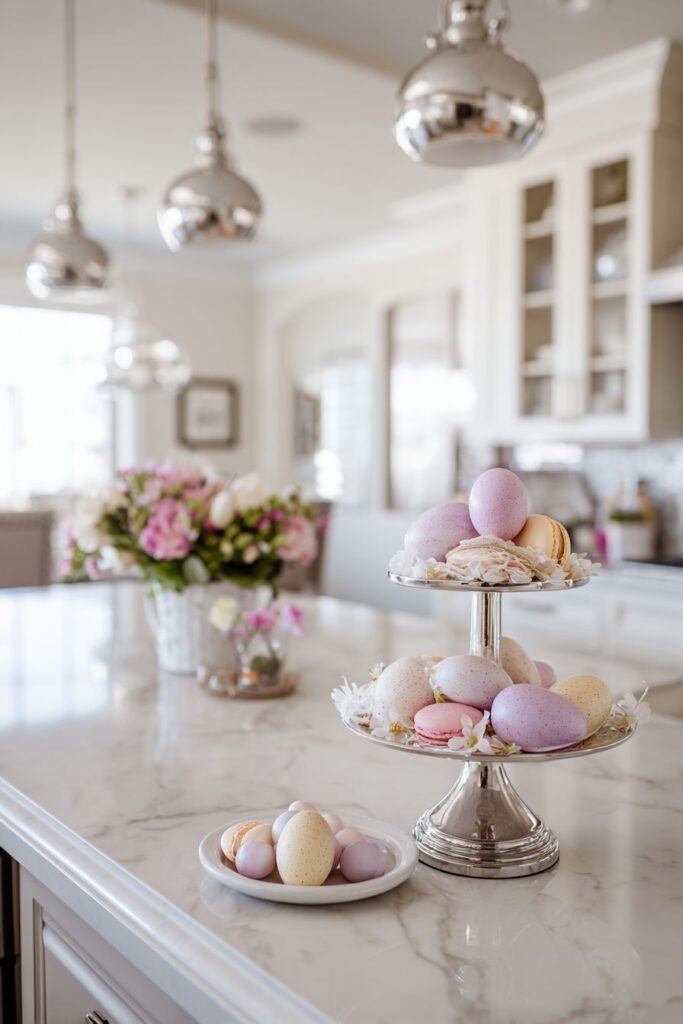
Key Design Tips:
- Repurpose cake stands for vertical display of macarons, eggs, and edible flower petals
- Choose white quartz with grey veining for elegant, low-maintenance countertop foundation
- Install brushed nickel fixtures and hardware for warm metallic accents that complement pastels
- Use pendant lighting to create gentle highlights that emphasize vertical displays
- Create entertaining-ready displays that are both beautiful and functionally accessible to guests
18. Bohemian Easter Creativity
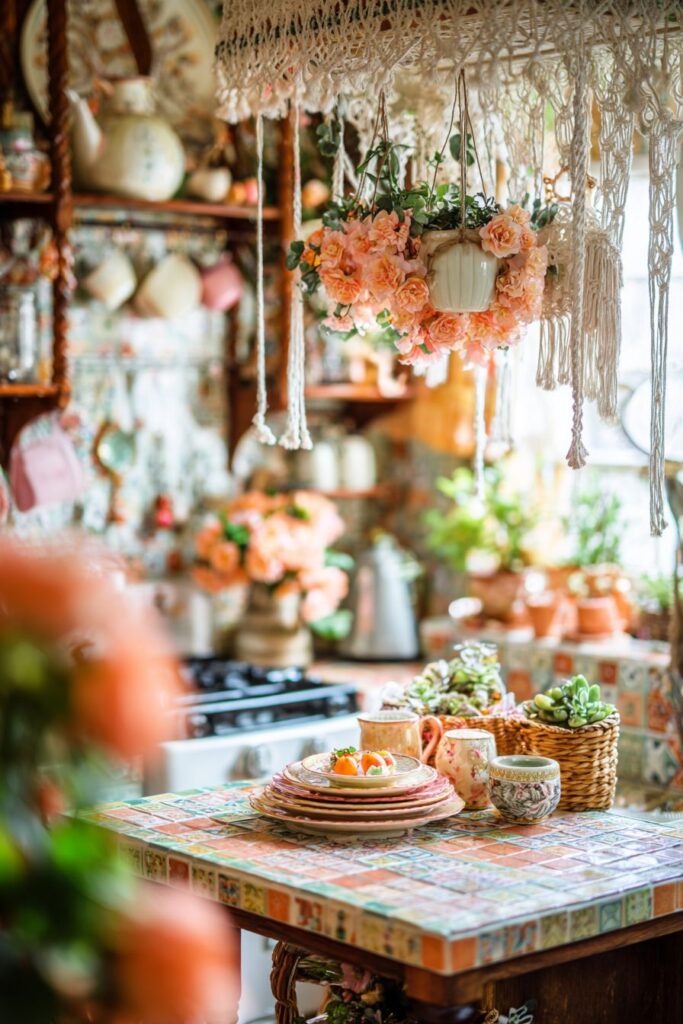
Free-spirited creativity defines this bohemian Easter kitchen decor that embraces handmade elements and layered patterns. Open wooden shelving provides rustic foundation that’s enhanced with macramé garland draped artistically across the shelves. The macramé—with its intricate knots and organic cotton texture—introduces handcrafted character while creating visual movement. Faux flowers in peach and coral tones are interwoven with the macramé, their warm hues representing a bohemian interpretation of spring colors that moves beyond conventional pastels.
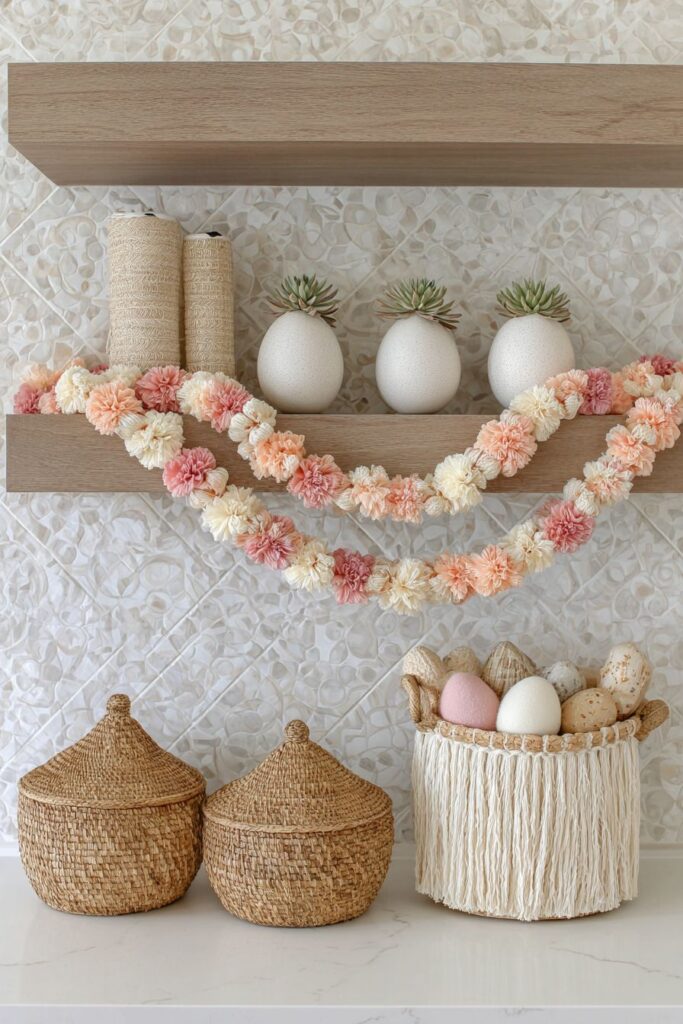
Ceramic egg-shaped planters offer year-round appeal with seasonal flair, housing succulents that require minimal care while providing ongoing visual interest. These planters bridge the gap between permanent and seasonal decoration, allowing the Easter theme to enhance rather than completely transform the existing aesthetic. Colorful patterned tile backsplash adds eclectic charm with geometric or floral designs in vibrant hues that celebrate maximalist tendencies.
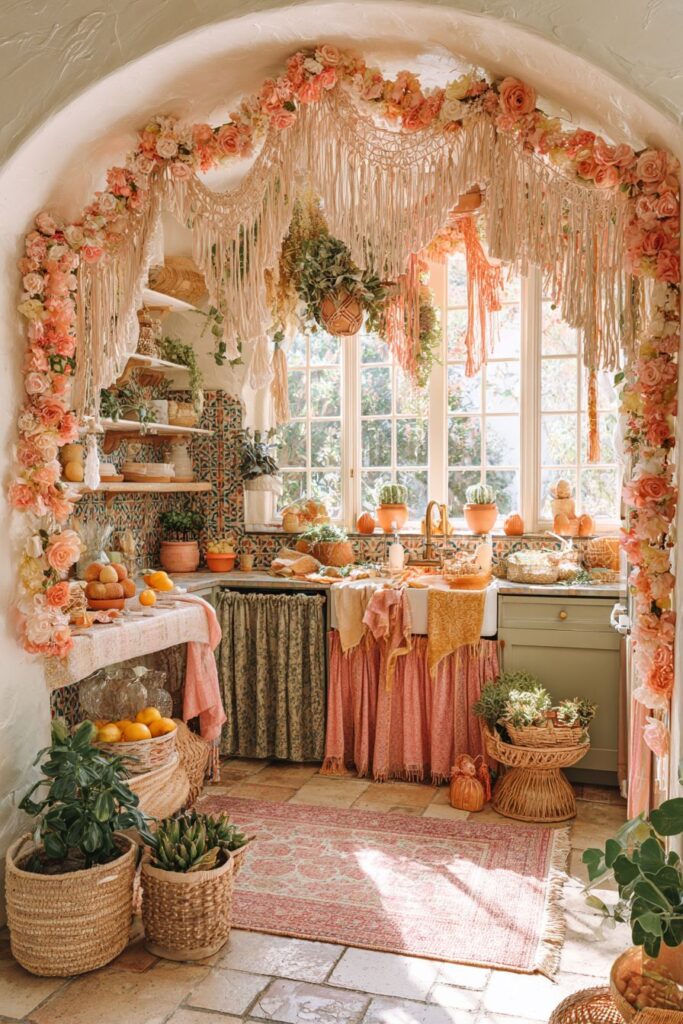
Natural woven baskets in varying sizes provide texture and practical storage solutions that double as decorative elements. These baskets might hold additional eggs, small plants, or kitchen essentials, demonstrating the bohemian principle of beautiful functionality. Soft, diffused natural light emphasizes the relaxed vibe, creating gentle illumination that highlights textures without harsh shadows. This Easter kitchen decor approach celebrates individuality, handcrafted beauty, and the joyful mixing of patterns and textures that defines bohemian style.
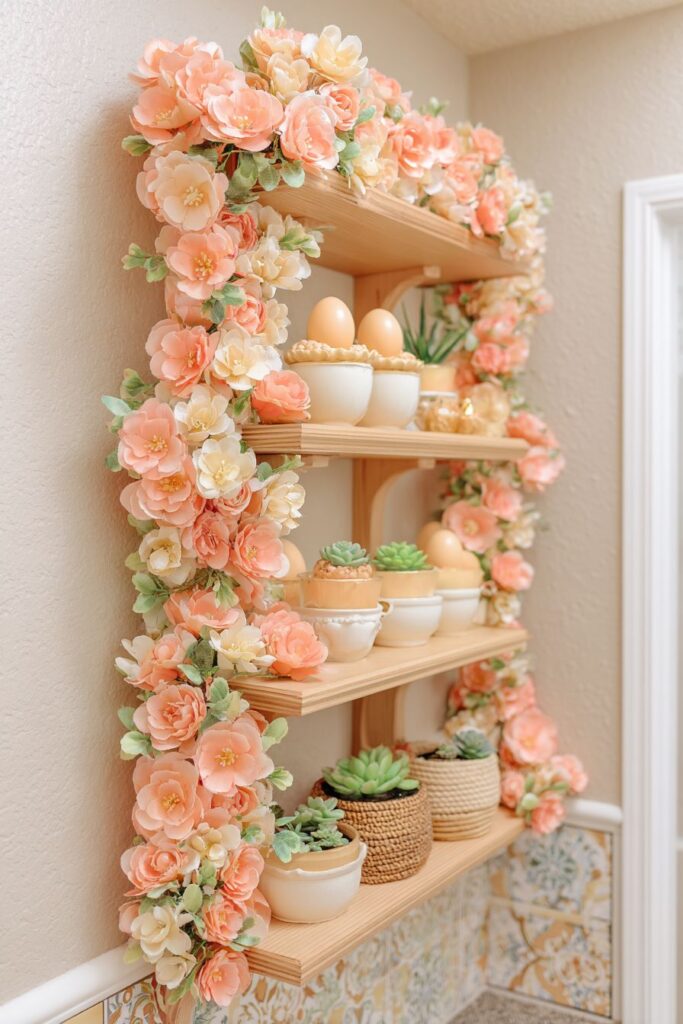
Key Design Tips:
- Drape handmade macramé garland across open shelving for bohemian texture and movement
- Interweave faux flowers in warm peach and coral tones with macramé for unconventional spring colors
- Use egg-shaped planters with succulents for year-round elements with seasonal Easter relevance
- Install colorful patterned tile backsplash for eclectic charm and maximalist expression
- Display natural woven baskets as both functional storage and textural decorative elements
19. Smart Small Space Easter Solutions
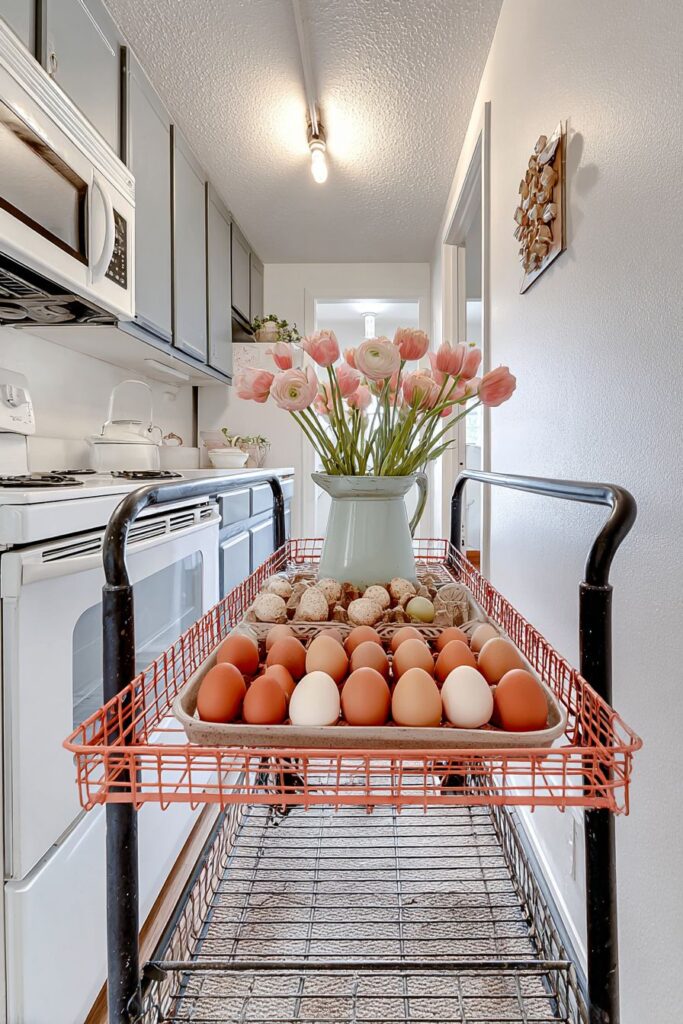
Galley kitchens demand creative solutions, and this Easter kitchen decor proves that limited space can still embrace seasonal celebration beautifully. A rolling cart becomes the hero of this design, offering mobility and multi-functionality. Styled with a vintage enamel pitcher filled with tulips and ranunculus in soft pink and white, the cart creates a movable focal point that can be repositioned as needed. The flowers’ romantic blooms add elegance while their soft colors maintain the Easter theme without overwhelming the narrow space.
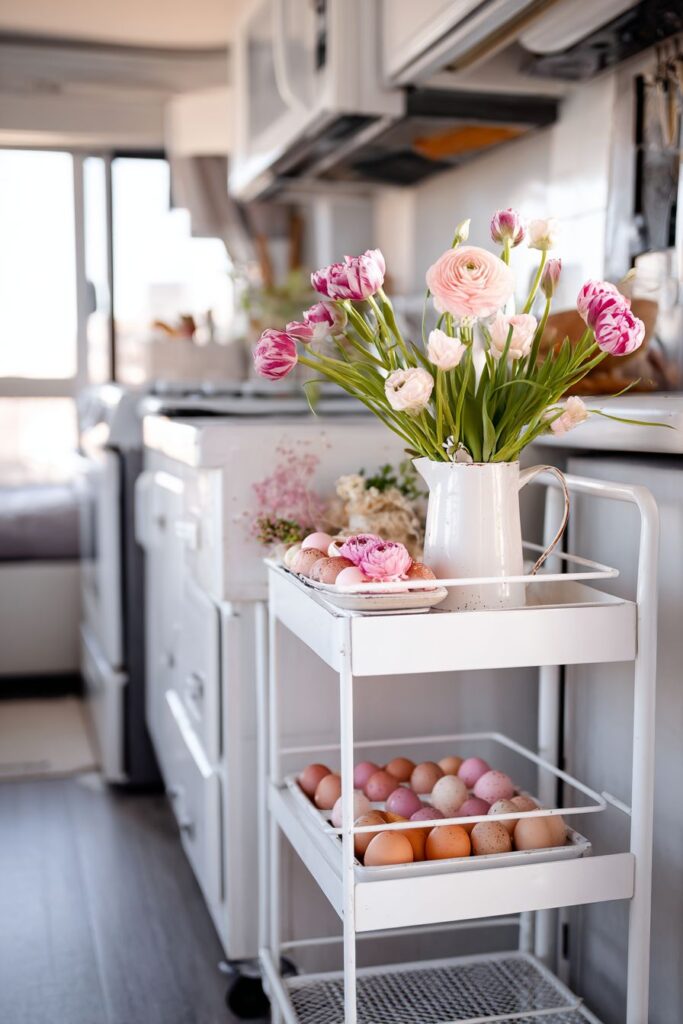
A small tray on the cart’s lower tier holds naturally dyed eggs created using botanical materials like onion skins, red cabbage, and turmeric. These eggs showcase subtle, sophisticated colors achieved through traditional techniques, their organic hues feeling more refined than commercial dyes. The tray contains and organizes the display while allowing the cart to remain functional for other purposes when needed. Light grey cabinets throughout the galley keep the space feeling open despite its narrowness, their neutral tone reflecting light and creating visual spaciousness.
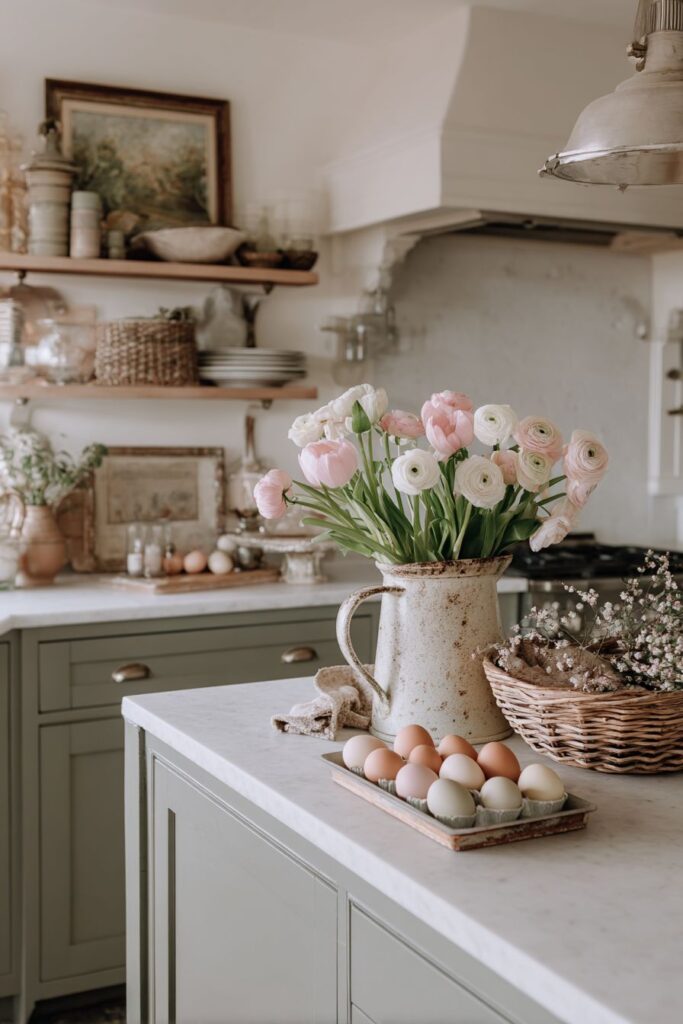
Under-cabinet lighting provides both task illumination for cooking and ambient lighting that highlights the Easter display. The strategic placement of these lights ensures the cart arrangement remains visible and appreciated even in the narrow space. This Easter kitchen decor approach demonstrates that thoughtful design can overcome spatial limitations, using mobile elements, multi-functional pieces, and strategic lighting to create seasonal impact without permanent commitment or spatial sacrifice.
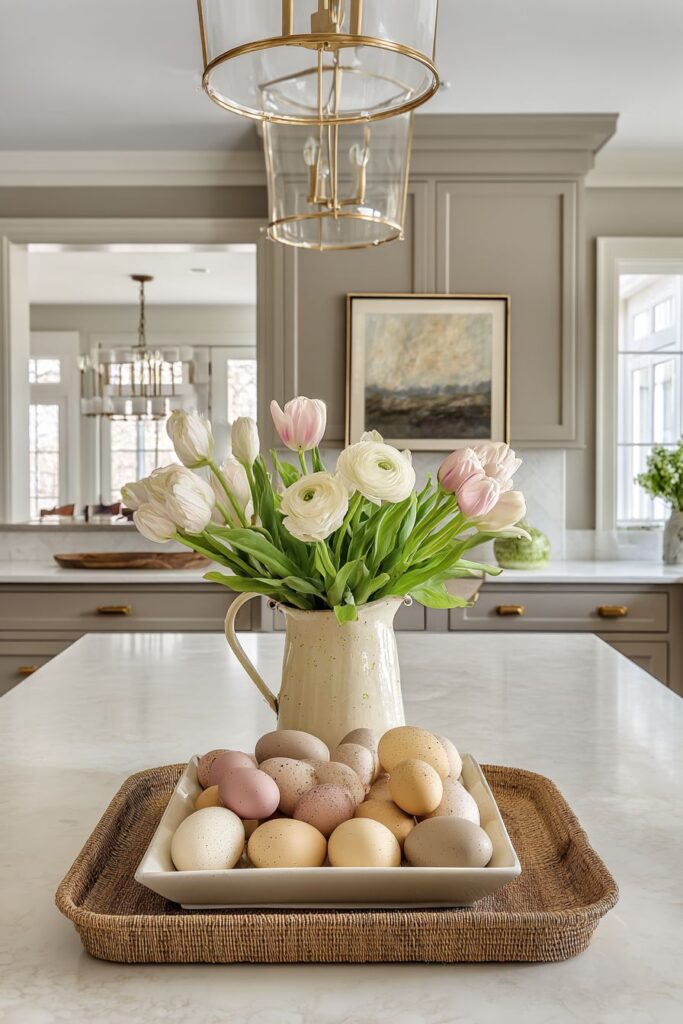
Key Design Tips:
- Use rolling carts for mobile, flexible Easter displays perfect for small or galley kitchens
- Style carts with vintage enamel pitchers and fresh flowers for movable focal points
- Create naturally dyed eggs using botanical materials for sophisticated, organic color palettes
- Install light grey cabinets to maximize light reflection and create visual spaciousness
- Utilize under-cabinet lighting for dual-purpose task and ambient illumination of seasonal displays
20. Classic Easter Celebration Table
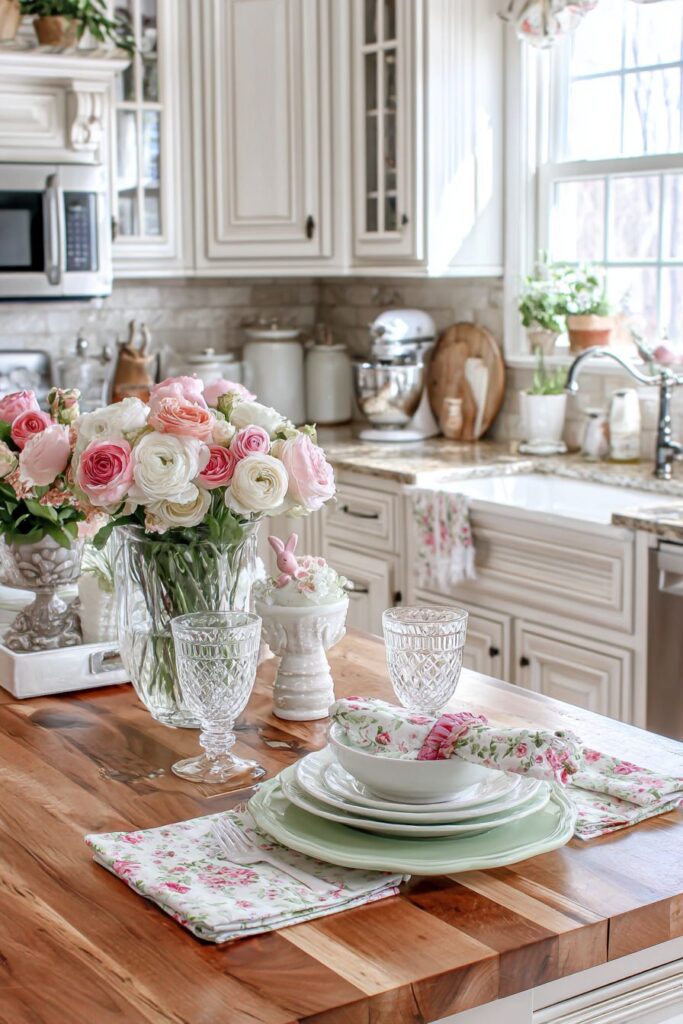
Traditional elegance reaches its peak in this classic Easter kitchen decor featuring a dining area set for celebratory brunch. A solid wood table provides substantial foundation, its quality craftsmanship and rich wood tones suggesting heirloom status and enduring value. Pastel-colored plates in coordinated hues create a color story that flows around the table, perhaps alternating between soft pink, pale yellow, and mint green. Floral napkins featuring spring blooms add pattern and visual interest, while bunny-shaped napkin rings introduce whimsical charm without compromising sophistication.
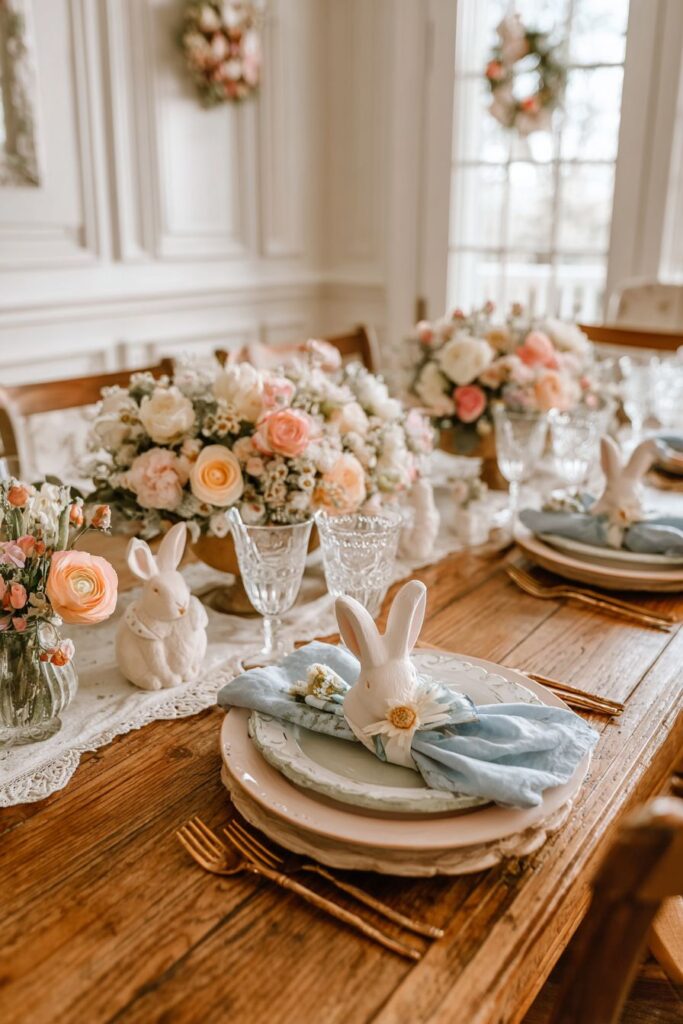
The centerpiece is kept intentionally low to encourage conversation across the table—a thoughtful design choice that prioritizes gathering and connection over pure visual impact. Garden roses and ranunculus in blush and ivory create lush, romantic abundance with their layered petals and varying bloom sizes. The soft color palette feels both celebratory and refined, avoiding the harsh brightness of some Easter decorations in favor of nuanced, sophisticated shades. Crystal glassware catches and refracts light, creating sparkle that elevates the entire setting and suggests special occasion.
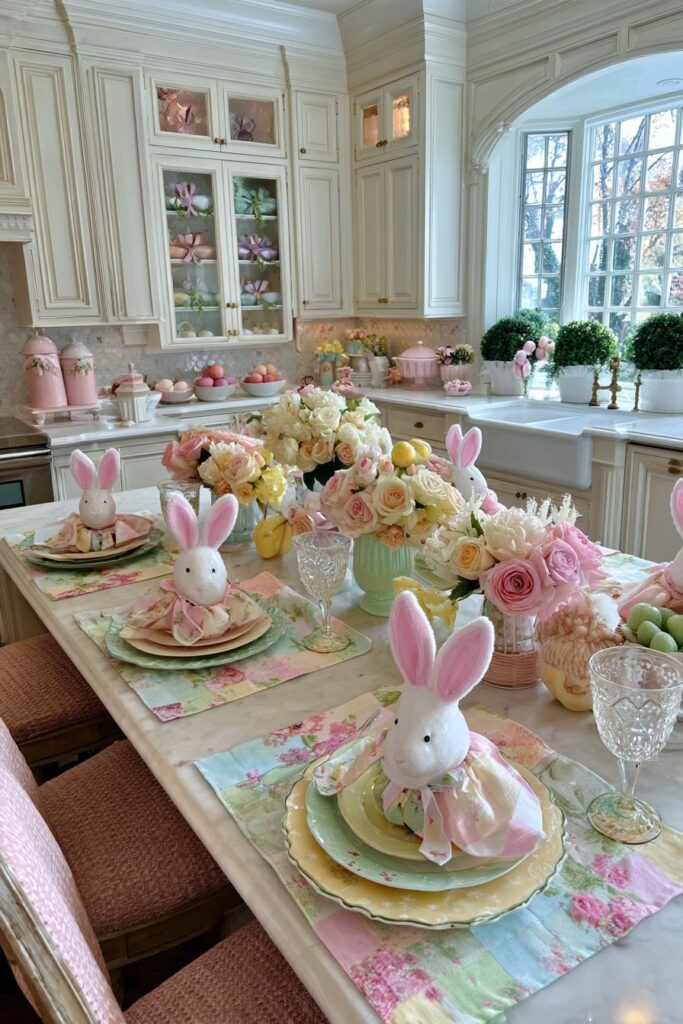
Wainscoting and crown molding provide traditional architectural details that frame the space with classic elegance. These elements create visual interest and architectural distinction without requiring any seasonal modification—they simply provide the perfect backdrop for Easter celebration. Natural window light floods the space, creating warm, inviting atmosphere that makes guests feel welcome from the moment they enter. This Easter kitchen decor approach honors tradition while creating a setting that feels both special and timelessly beautiful.
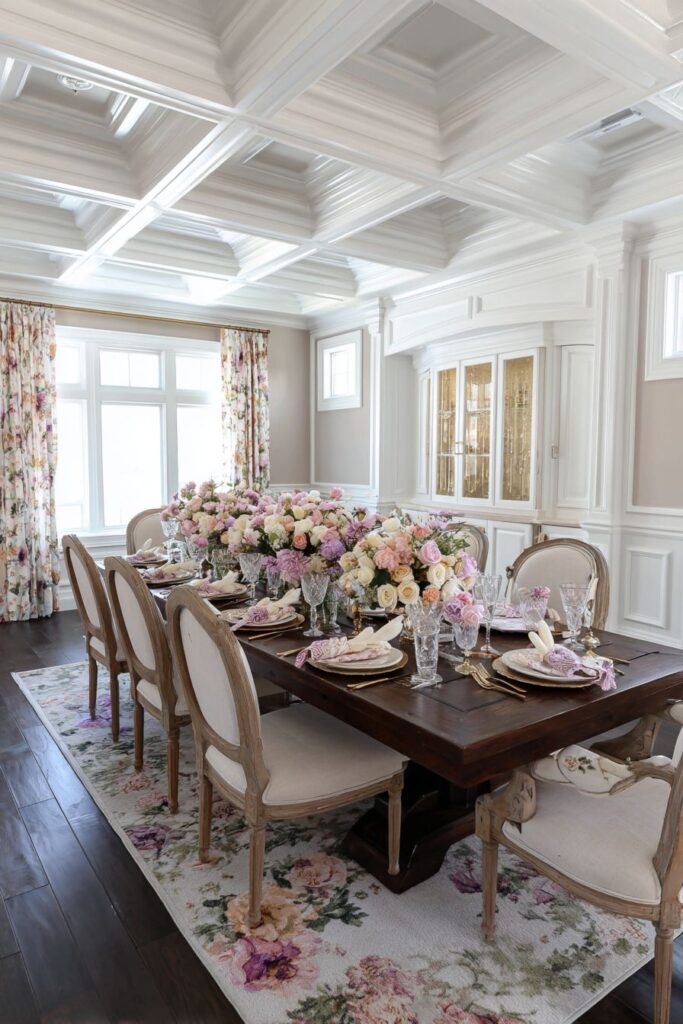
Key Design Tips:
- Set tables with pastel plates in coordinated hues for cohesive color flow around the dining surface
- Use bunny-shaped napkin rings to add whimsy while maintaining sophisticated table settings
- Create low centerpieces with roses and ranunculus to encourage conversation across the table
- Include crystal glassware for light-catching sparkle that elevates the entire setting
- Leverage existing architectural details like wainscoting and crown molding as classic backdrops for Easter celebration
Why These Easter Kitchen Decor Designs Work Best
Each of these twenty Easter kitchen decor approaches succeeds because they understand fundamental design principles while adapting them to seasonal celebration. The farmhouse rustic display works because it balances weathered authenticity with fresh, living elements—the juxtaposition of aged wood and new blooms creates visual tension that keeps the eye engaged. The modern minimalist approach proves that Easter doesn’t require traditional elements when material quality and sculptural form can convey seasonal spirit through sophisticated restraint.
Pastel dishware showcases succeed by transforming functional items into art, demonstrating that smart curation can eliminate the need for additional seasonal purchases. The cottage-style table setting creates emotional resonance through nostalgic elements combined with natural beauty—it’s decoration that feels like memory and anticipation intertwined. Family-friendly playful designs work because they acknowledge that Easter kitchen decor must serve multiple audiences, creating spaces where children’s delight and adult aesthetic sensibilities can coexist harmoniously.
The sophisticated tiered displays maximize vertical space while maintaining accessibility, solving the common kitchen challenge of limited counter space. Rustic floating shelf arrangements celebrate imperfection as beauty, teaching us that weathered textures and natural irregularities can be more compelling than manufactured perfection. Scandinavian serenity demonstrates that restraint isn’t deprivation but rather clarity—when every element earns its place, the result is profound peace and visual satisfaction.
Nostalgic china displays preserve family history while making it relevant to current celebration, bridging generations through shared objects and traditions. Contemporary geometric approaches prove that Easter can be edgy and sophisticated, appealing to modern sensibilities while honoring seasonal change. The vintage farmhouse sink display works because it places seasonal decoration within the natural workflow of kitchen tasks, making Easter part of daily experience rather than separate from it.
French country romance succeeds through material authenticity and aromatic layers—it engages multiple senses to create immersive experience. Cozy breakfast nooks demonstrate that comfort and celebration aren’t mutually exclusive, creating spaces that invite lingering and connection. Industrial-chic fusion breaks style rules to create something unexpected and memorable—its success lies in confident material mixing and creative vision.
Window treatment charm teaches focus—sometimes the most effective design concentrates energy on single, well-executed elements rather than dispersing effort across multiple areas. Coastal fresh interpretations show that regional inspiration can refresh traditional holidays, creating personally meaningful decoration that reflects local landscape and lifestyle. Entertaining-ready elegance combines beauty with function, proving that the best Easter kitchen decor serves practical purposes while creating visual impact.
Bohemian creativity celebrates handmade elements and pattern mixing, reminding us that rules are meant to be broken by those with confident vision and personal style. Smart small space solutions demonstrate that spatial limitations inspire innovation rather than limiting possibilities—constraint becomes creative catalyst. Finally, classic celebration settings work because they honor tradition while executing it with impeccable attention to detail and quality materials.
These designs represent the best of Easter kitchen decor because they each offer something different while sharing common threads of authenticity, functionality, and aesthetic coherence. Whether your kitchen is farmhouse rustic or sleek contemporary, small galley or expansive open concept, traditional or bohemian, there’s an approach here that can be adapted to your space, budget, and style preferences. The key is selecting elements that resonate with your personal aesthetic while embracing the optimistic, renewal-focused spirit of Easter.
Conclusion
Easter kitchen decor offers limitless possibilities for transforming your culinary space into a celebration of spring, renewal, and natural beauty. From the rustic charm of farmhouse-style displays featuring weathered wood and hand-painted eggs to the sophisticated minimalism of contemporary geometric arrangements, each approach demonstrates that seasonal decoration can be both beautiful and deeply personal. The twenty designs explored here prove that Easter doesn’t demand a single aesthetic—rather, it provides a flexible framework that adapts beautifully to diverse style preferences, spatial constraints, and decorating budgets.
The most successful Easter kitchen decor balances seasonal celebration with practical functionality, creating spaces that remain fully usable while expressing the joy and optimism of spring. Whether you’re drawn to the nostalgic appeal of vintage collections, the fresh perspective of coastal-inspired palettes, or the creative freedom of bohemian layering, the key lies in selecting elements that feel authentic to your personal style while honoring the spirit of the season. Natural materials, pastel color palettes, fresh botanical elements, and thoughtful lighting create the foundation for memorable Easter kitchens that welcome family and friends to gather, celebrate, and create new traditions.
As you implement these ideas in your own home, remember that the best decoration tells your unique story while embracing seasonal change. Start with one or two elements that truly resonate with you—perhaps a vintage dough bowl filled with hand-painted eggs, a collection of pastel dishware artfully displayed, or a simple fabric garland framing your kitchen window. Allow these initial touches to guide your broader decorating decisions, building a cohesive Easter kitchen that feels collected rather than contrived, celebratory rather than overwhelming. The true success of Easter kitchen decor lies not in perfect execution but in creating spaces that bring joy to daily routines and make seasonal celebration an integral part of everyday life. Let these twenty inspiring approaches encourage you to experiment, take creative risks, and discover the unique ways your kitchen can welcome spring’s arrival with beauty, warmth, and welcoming charm.
